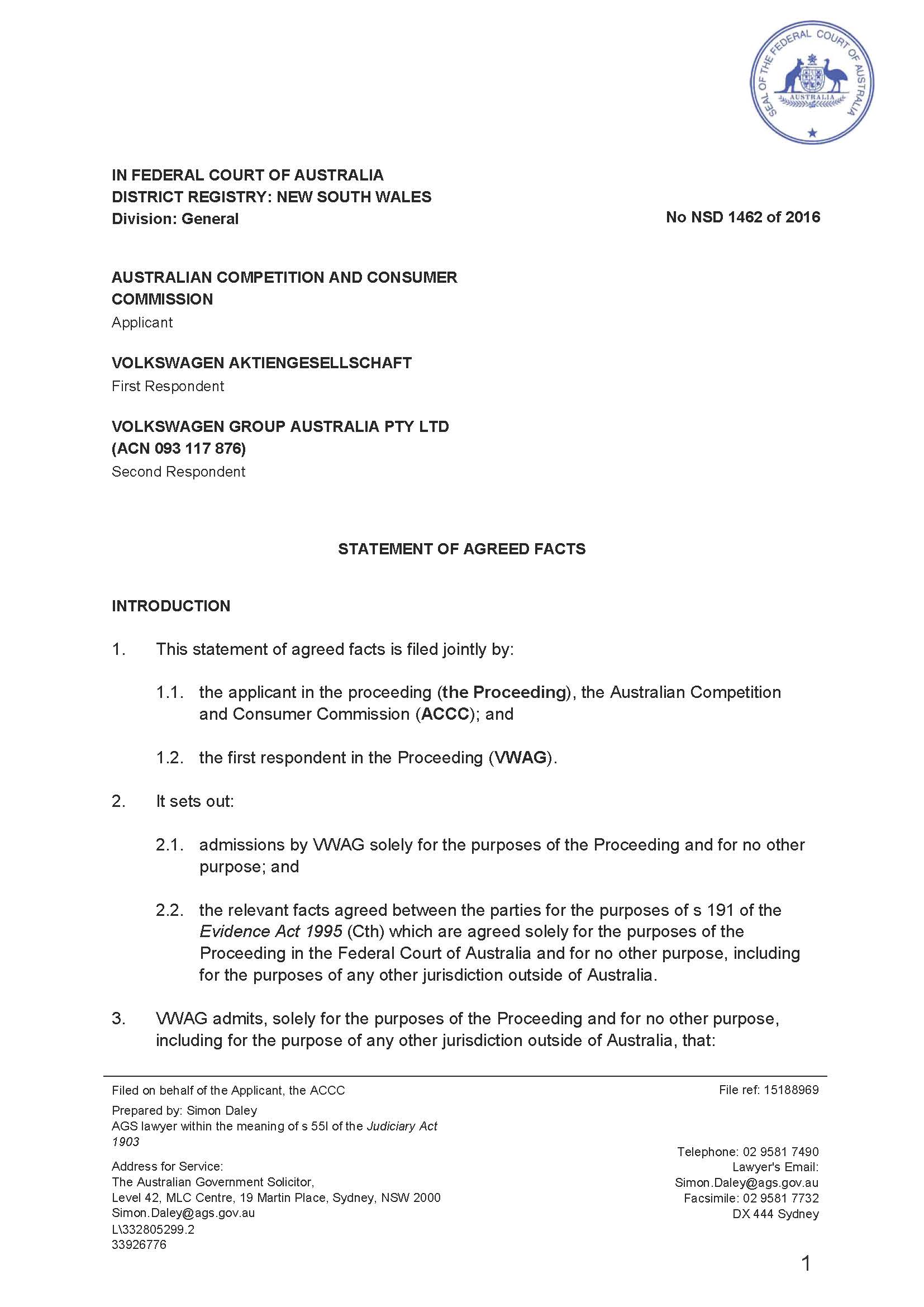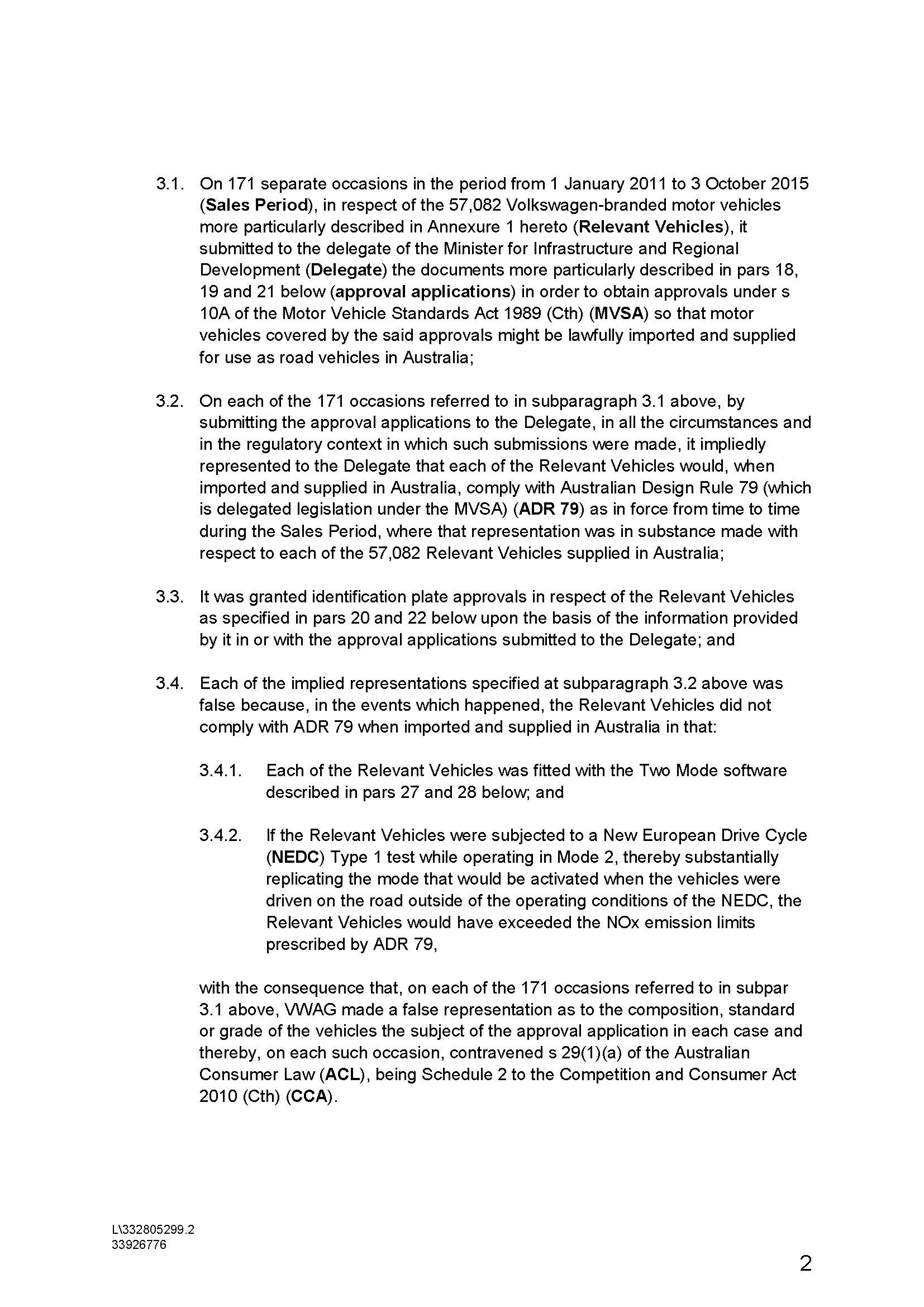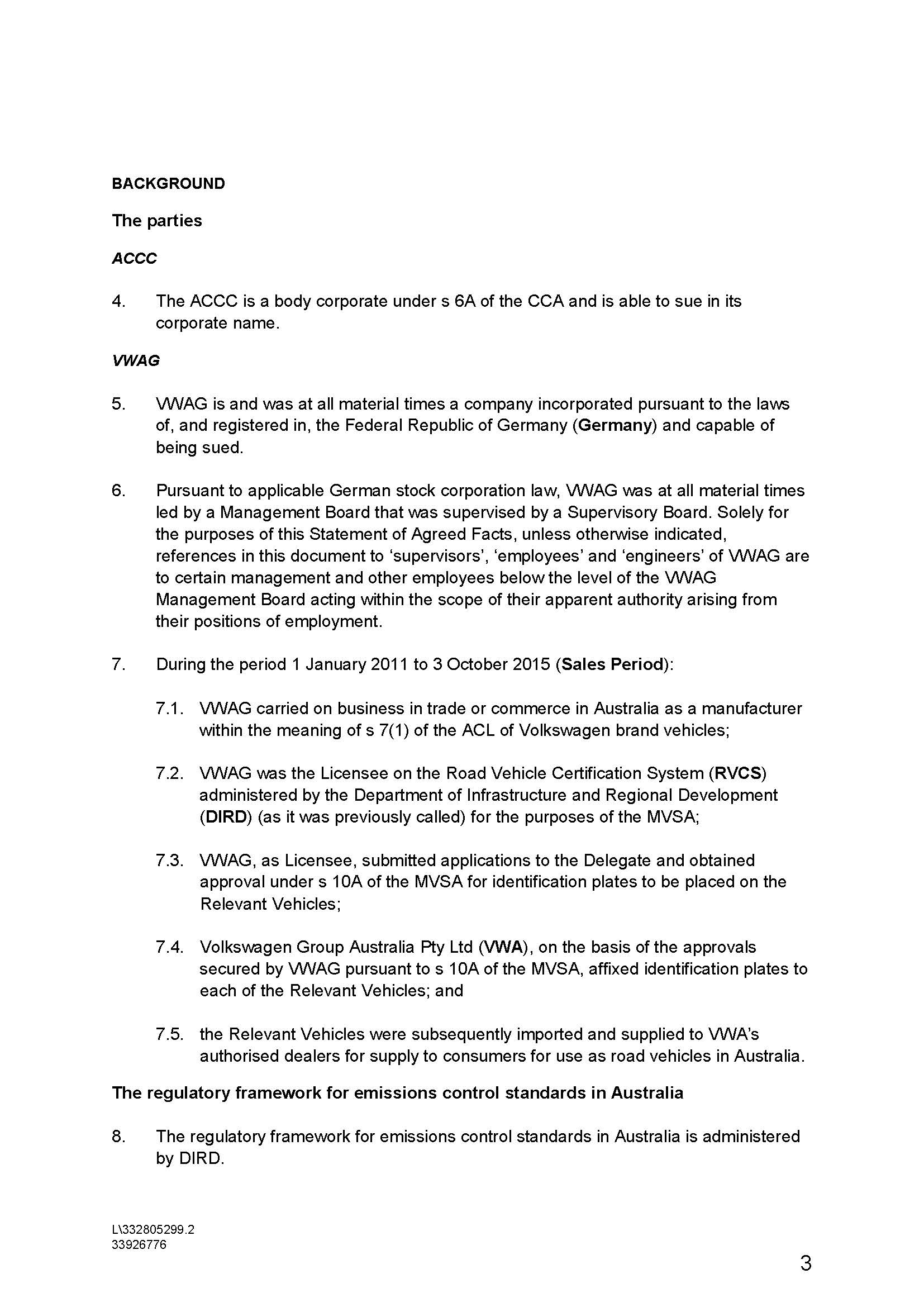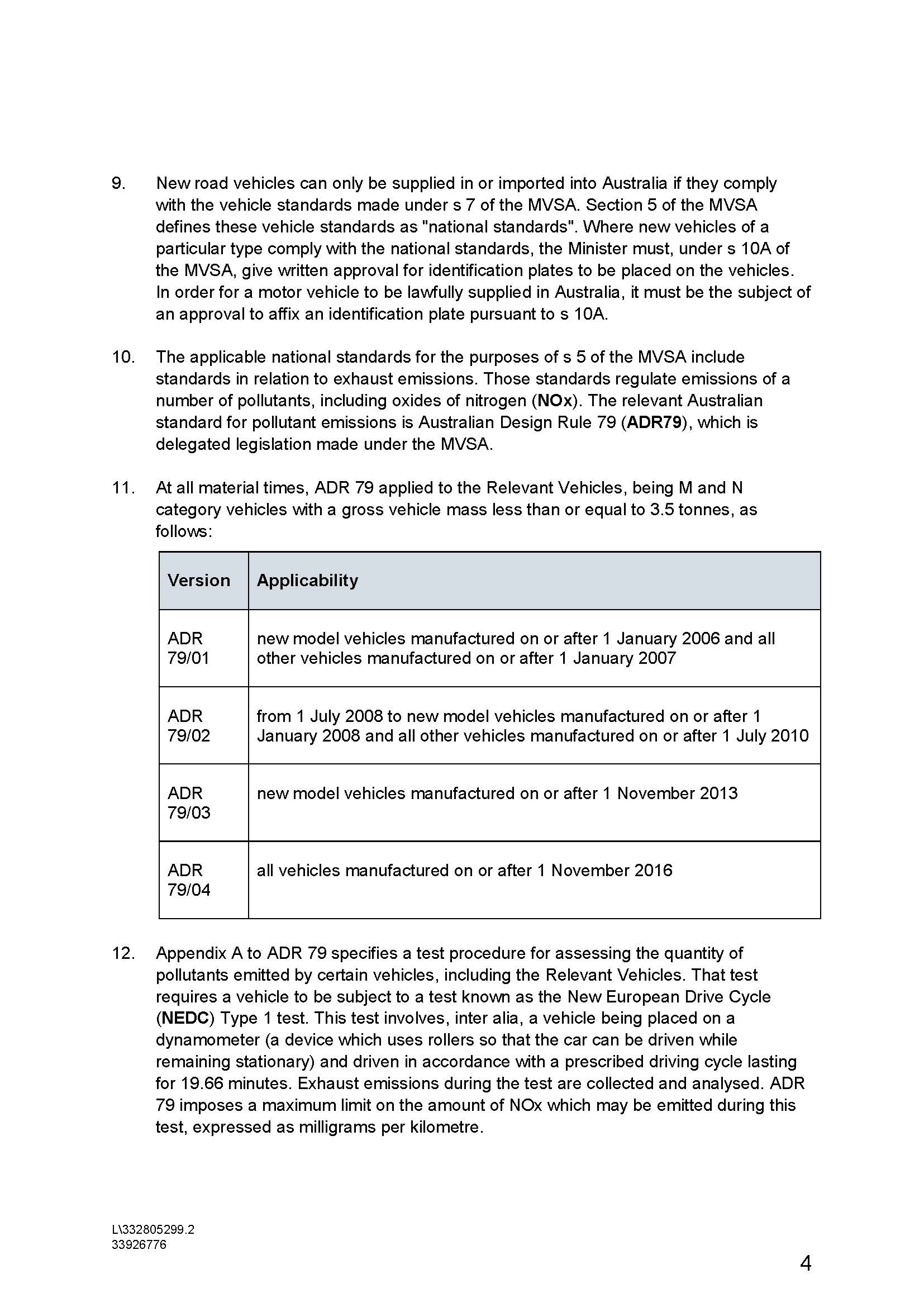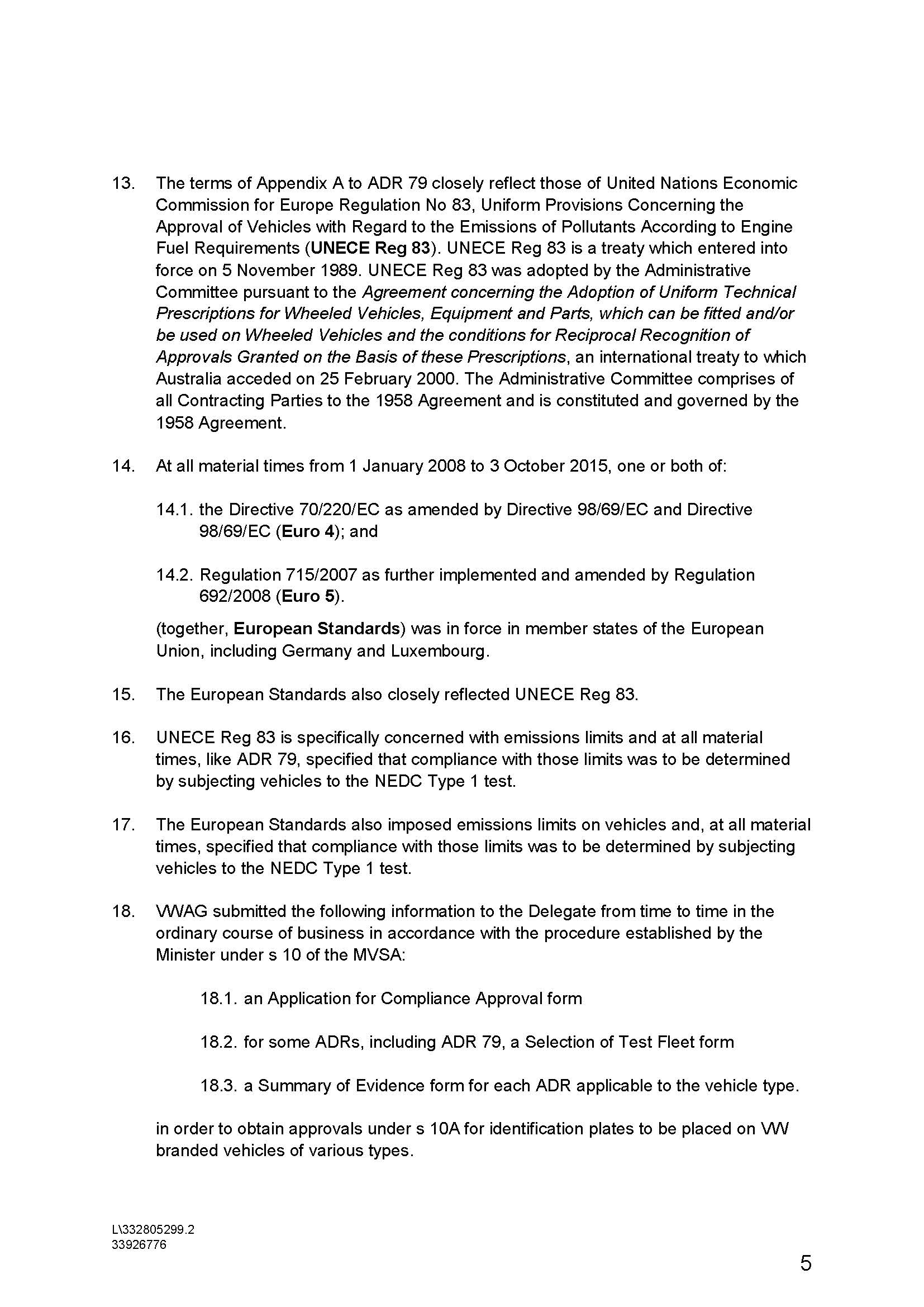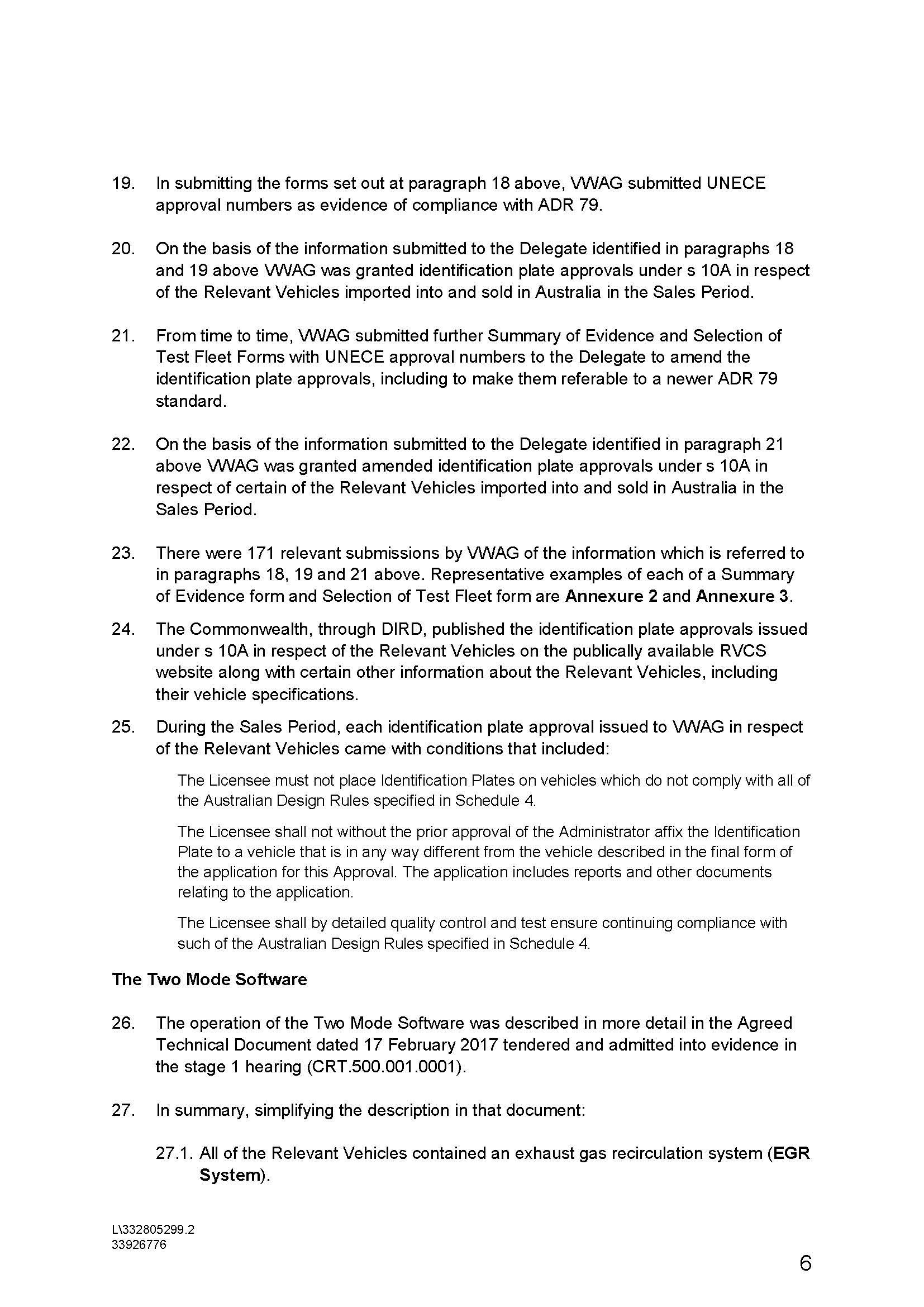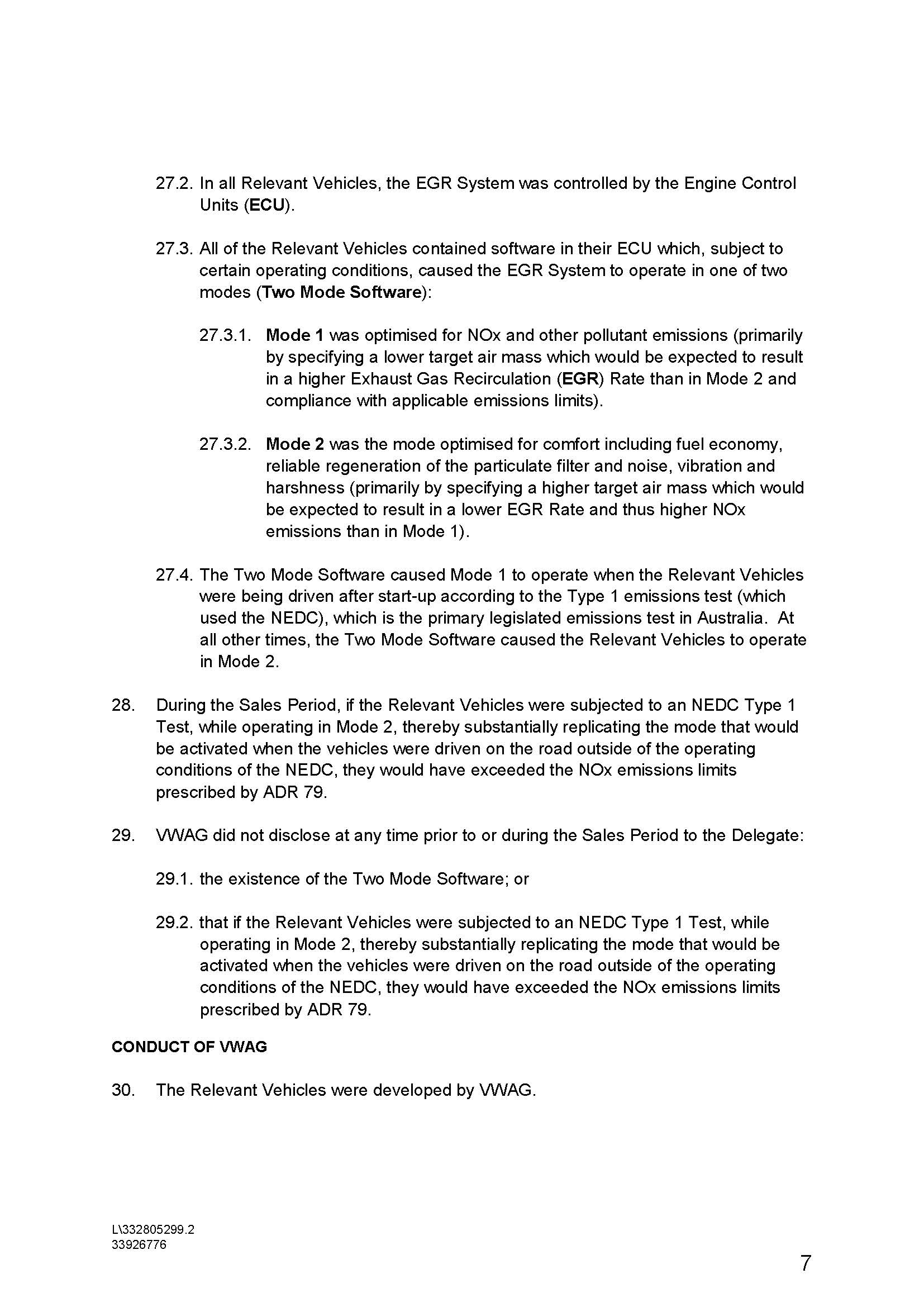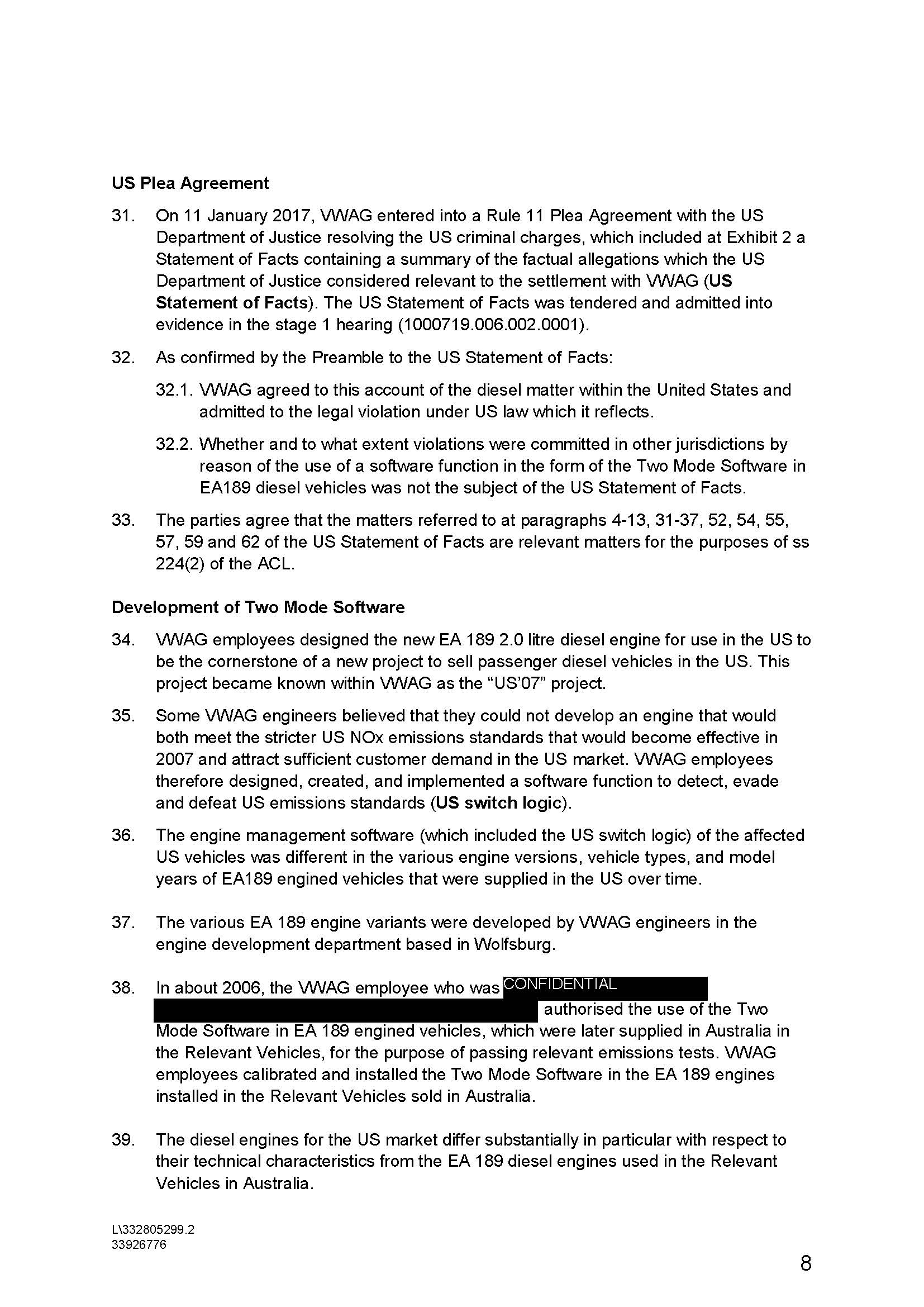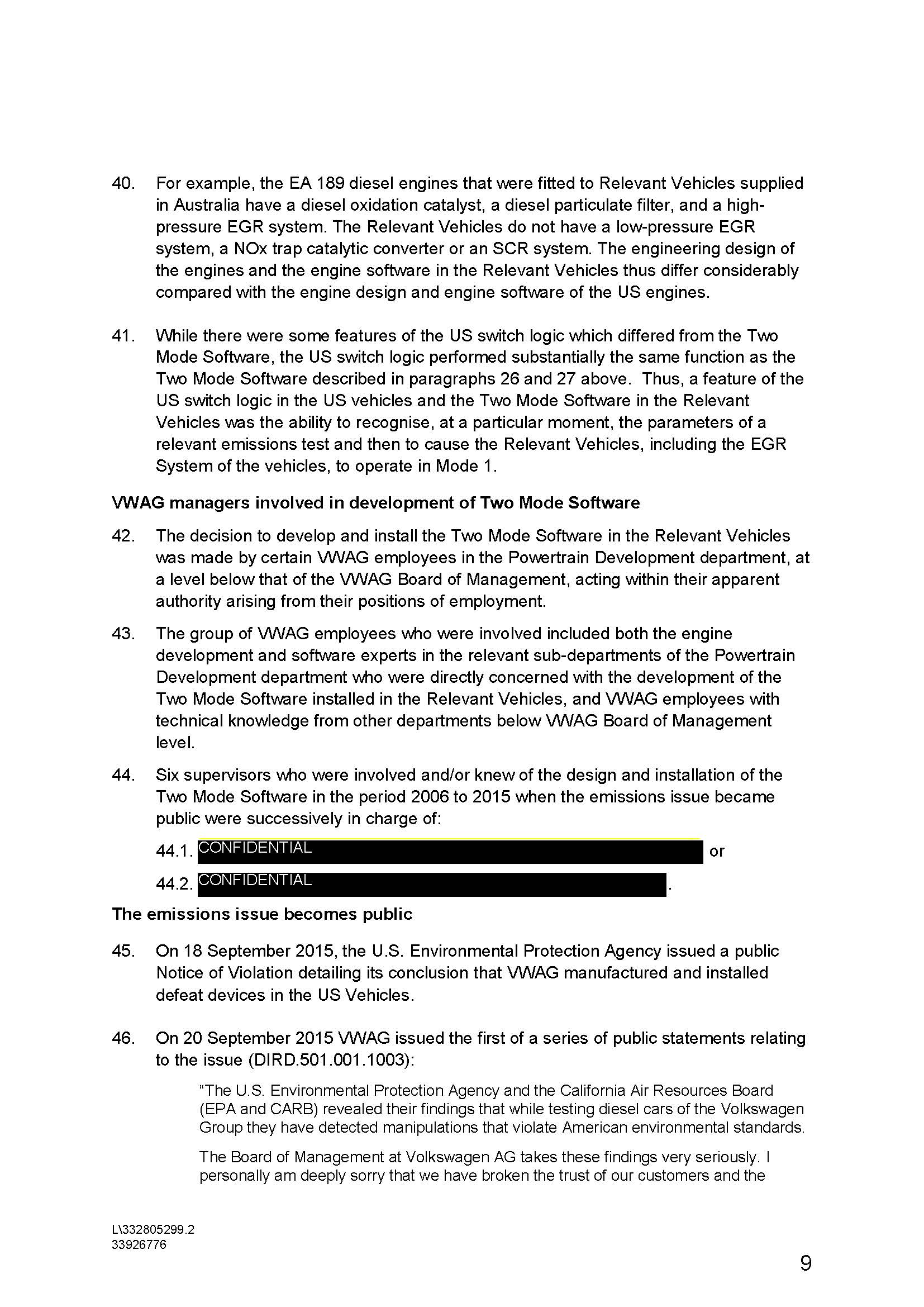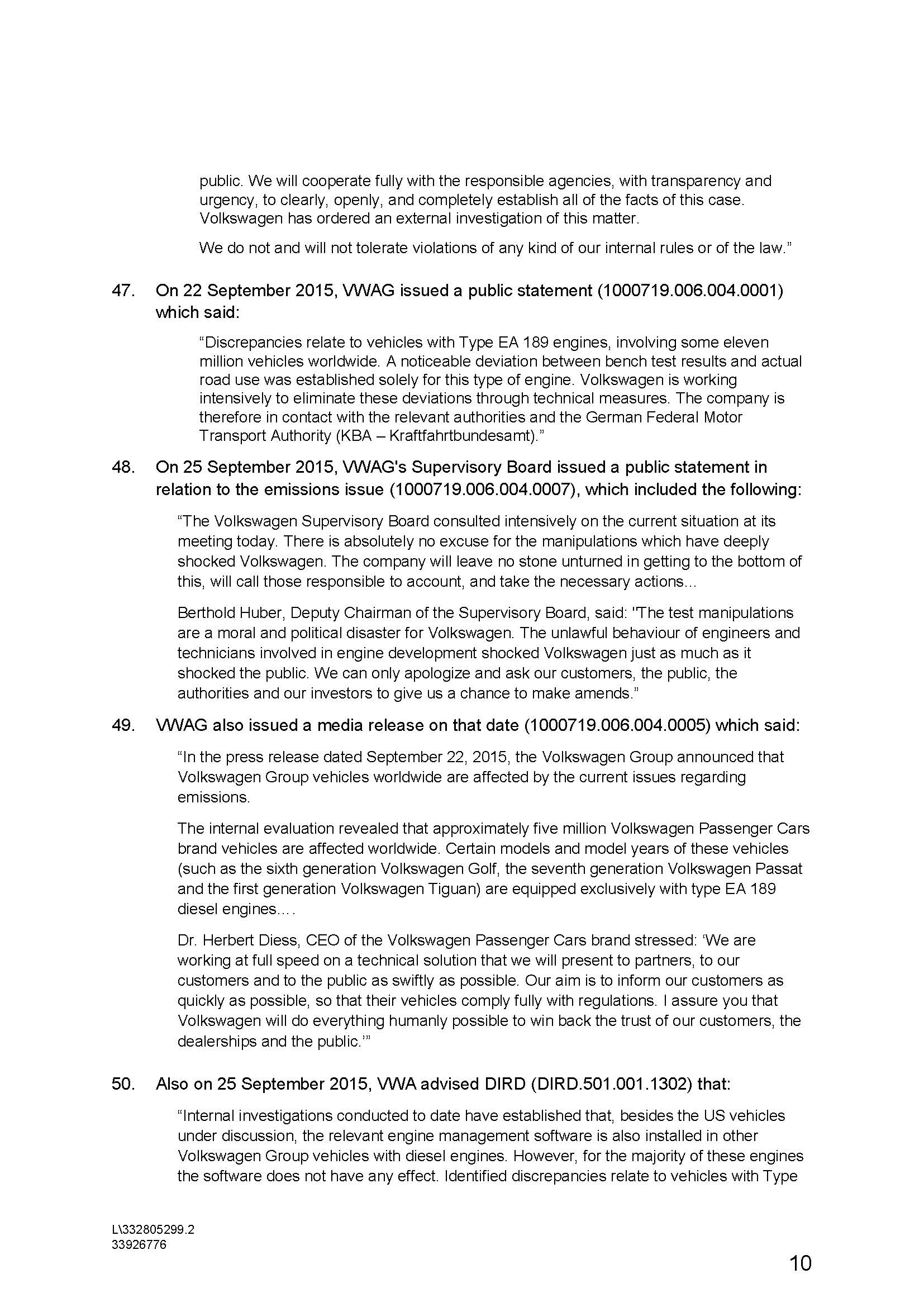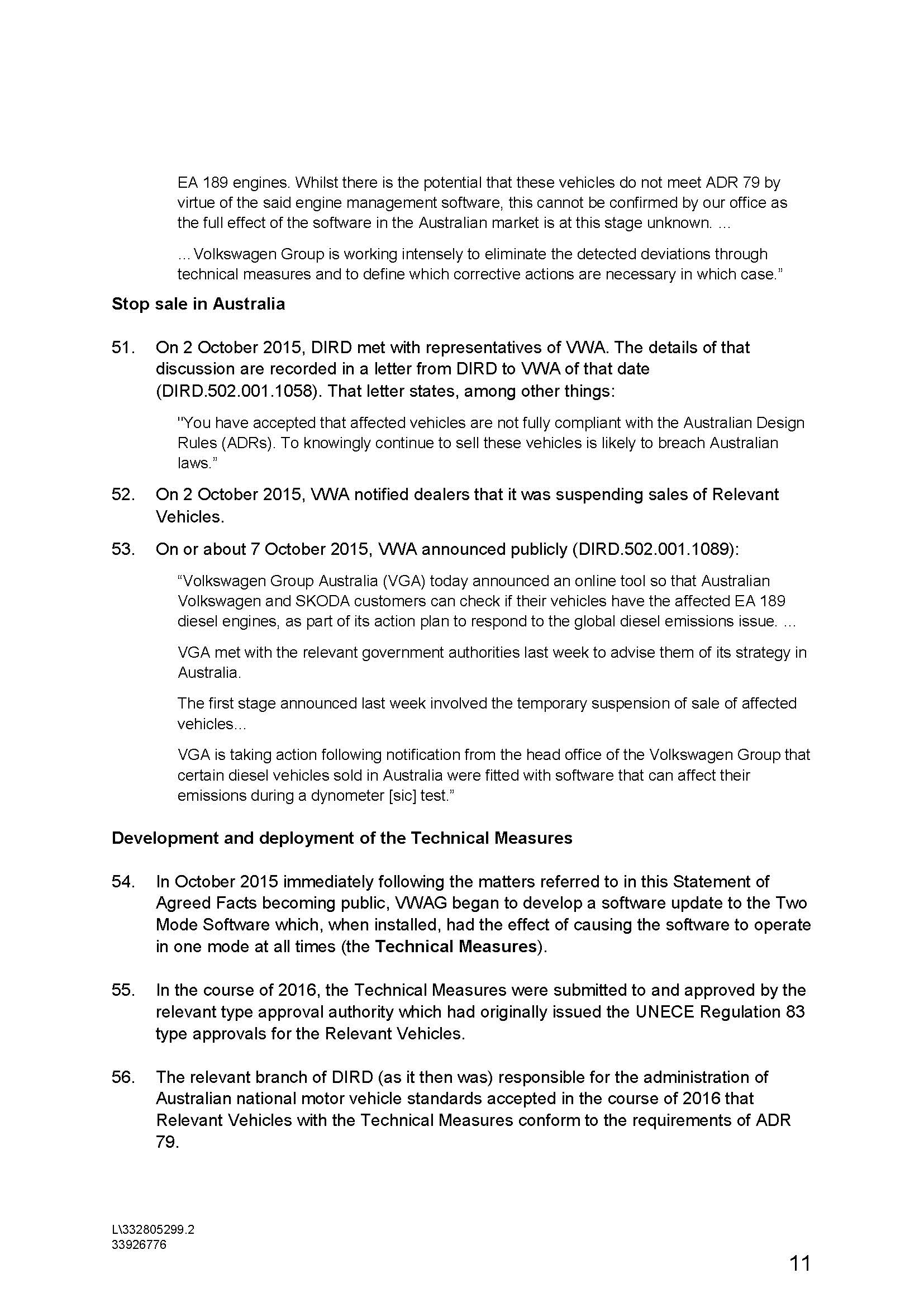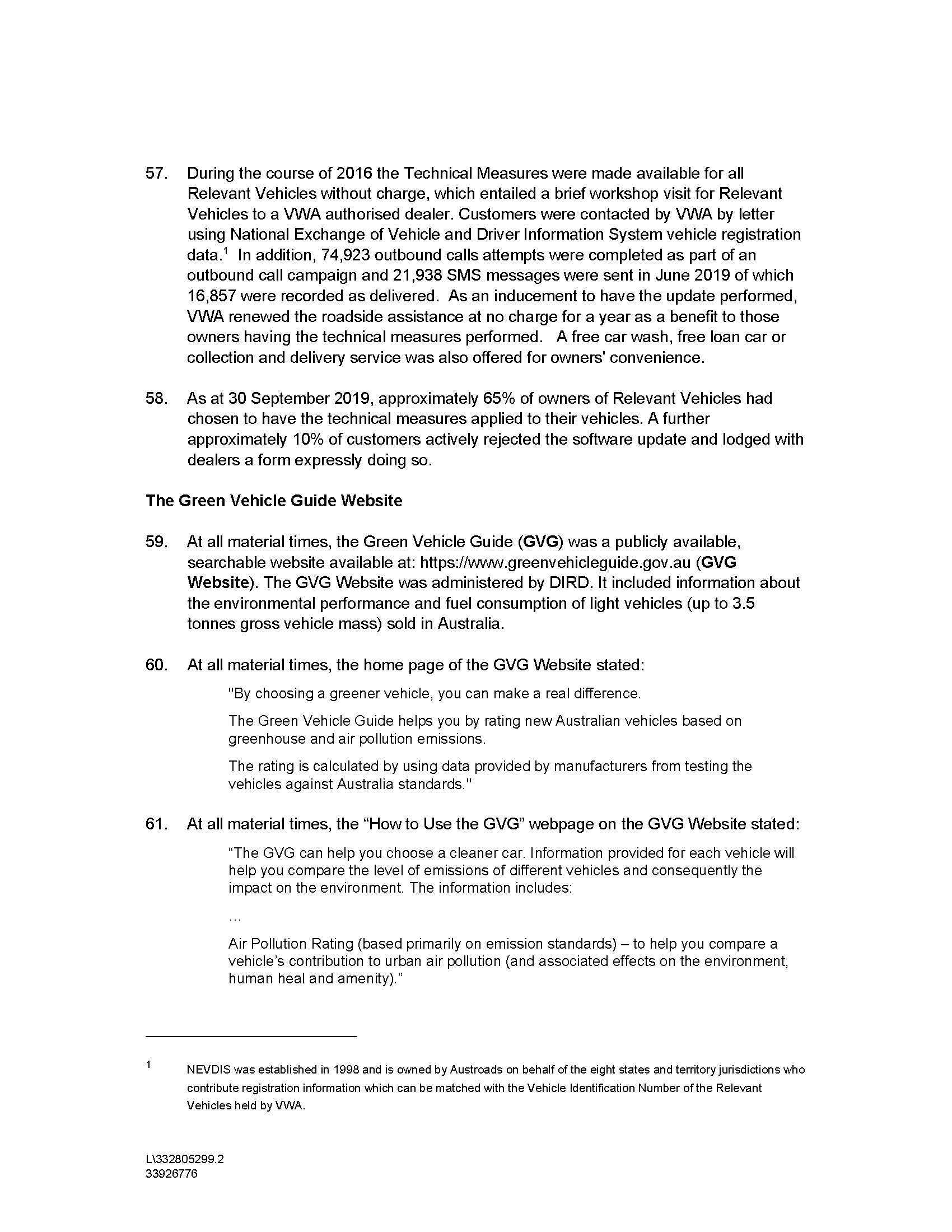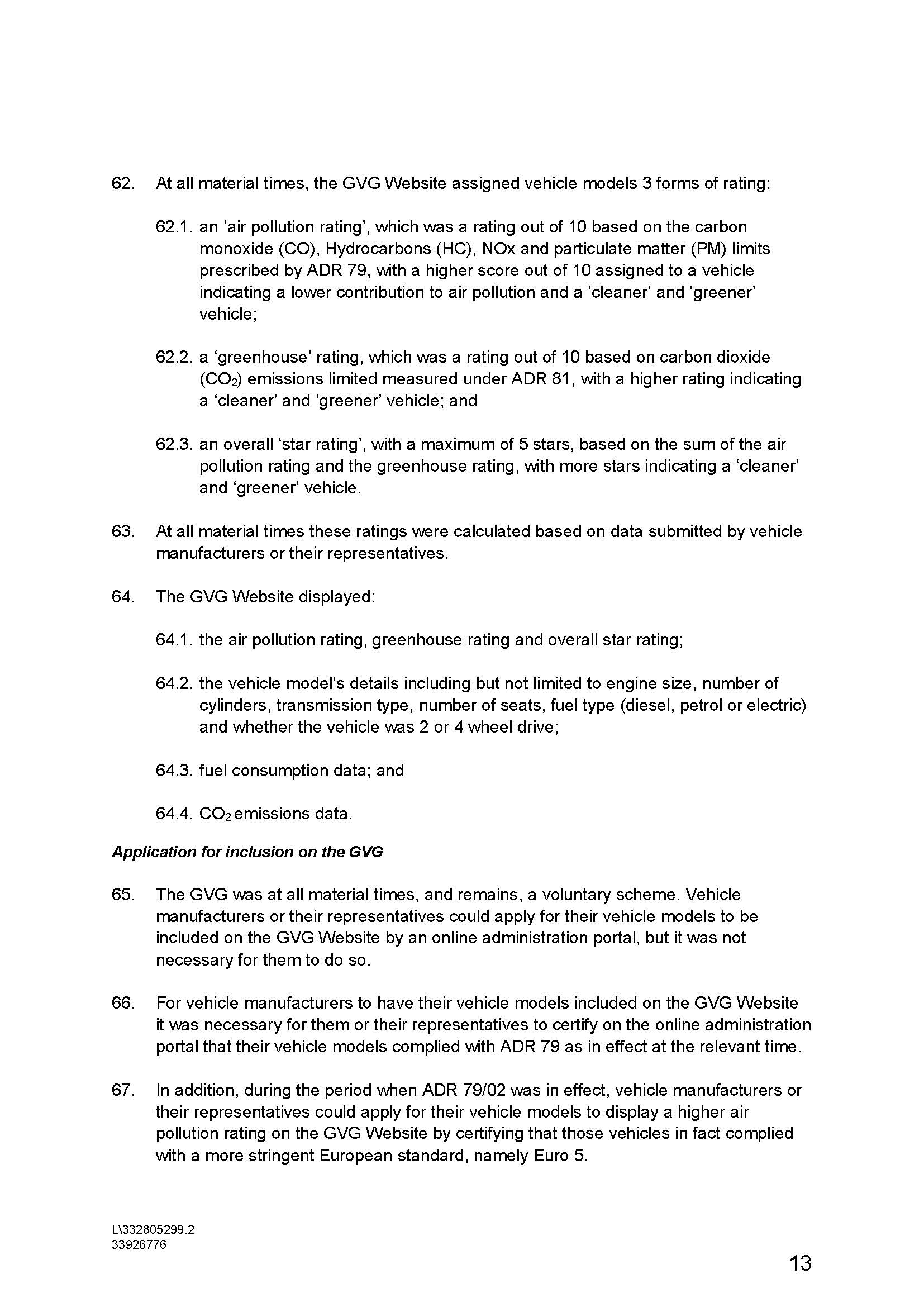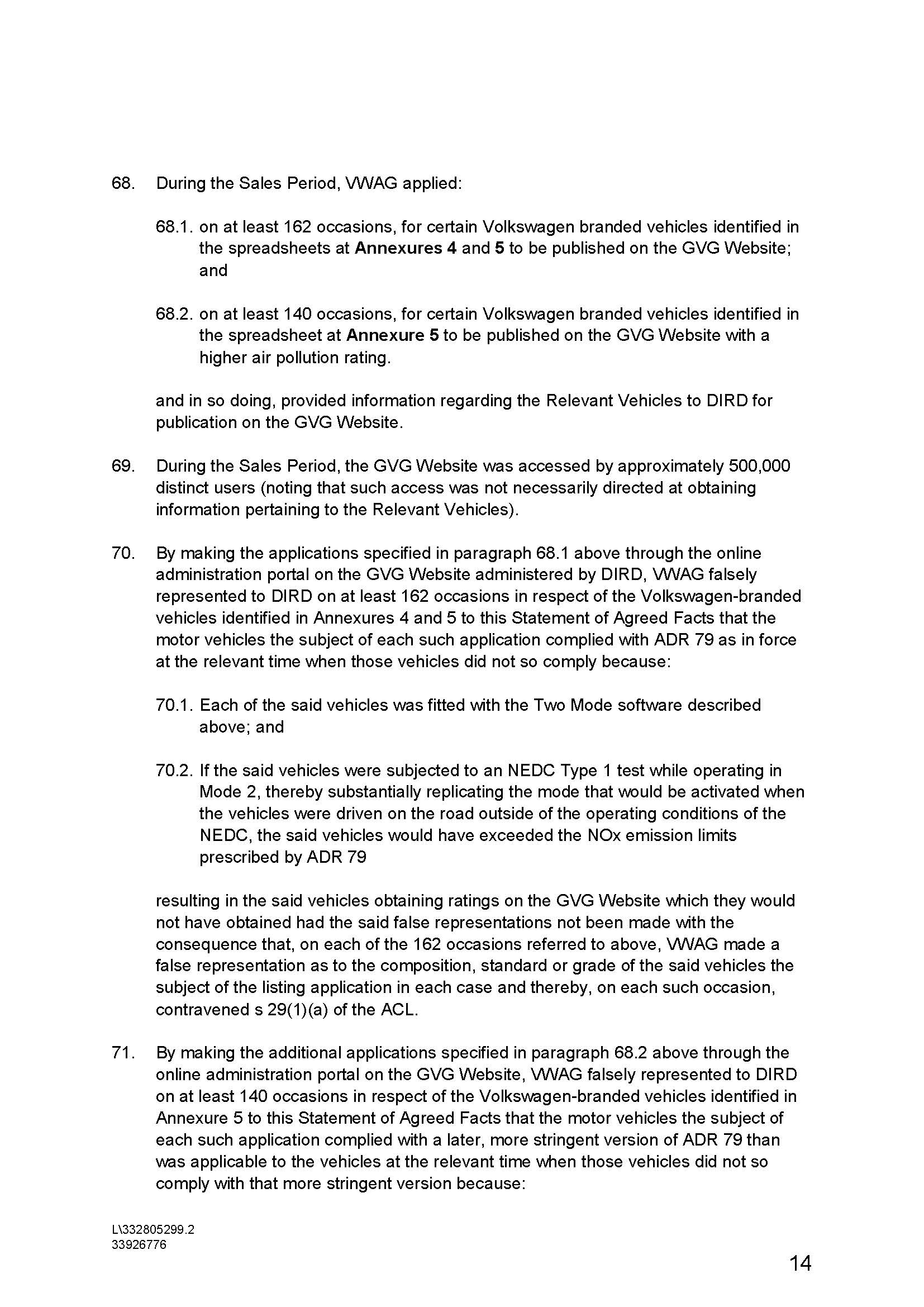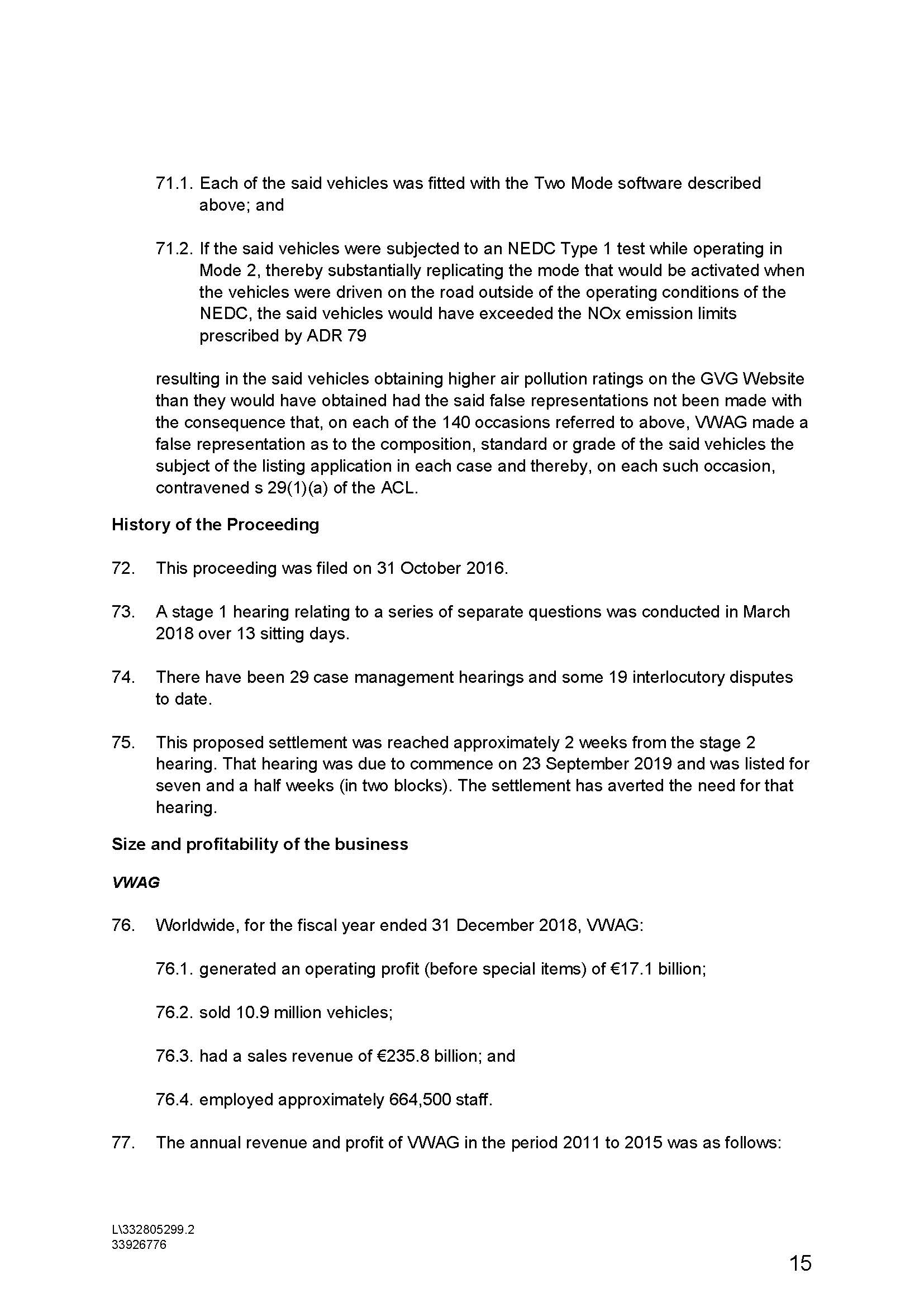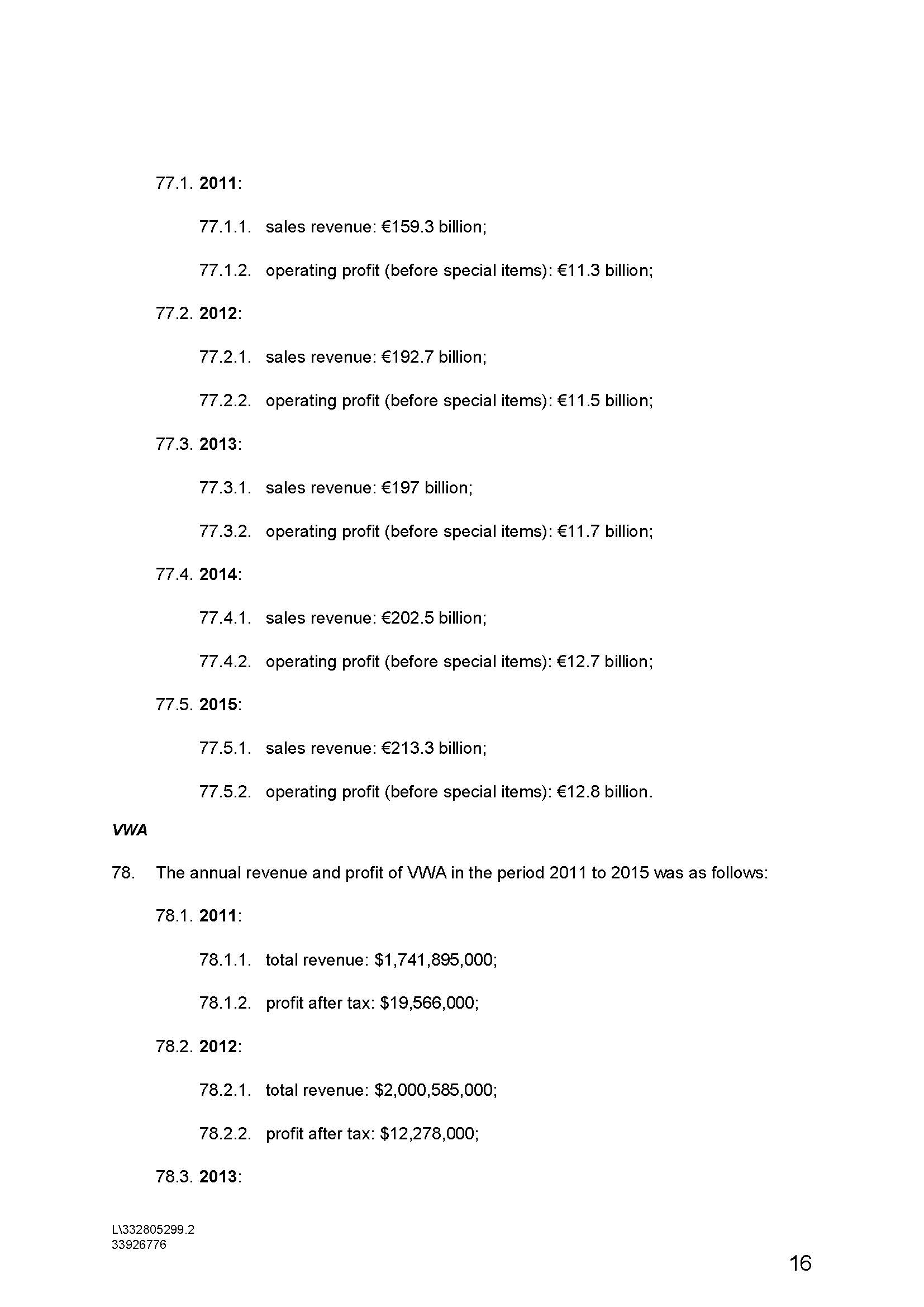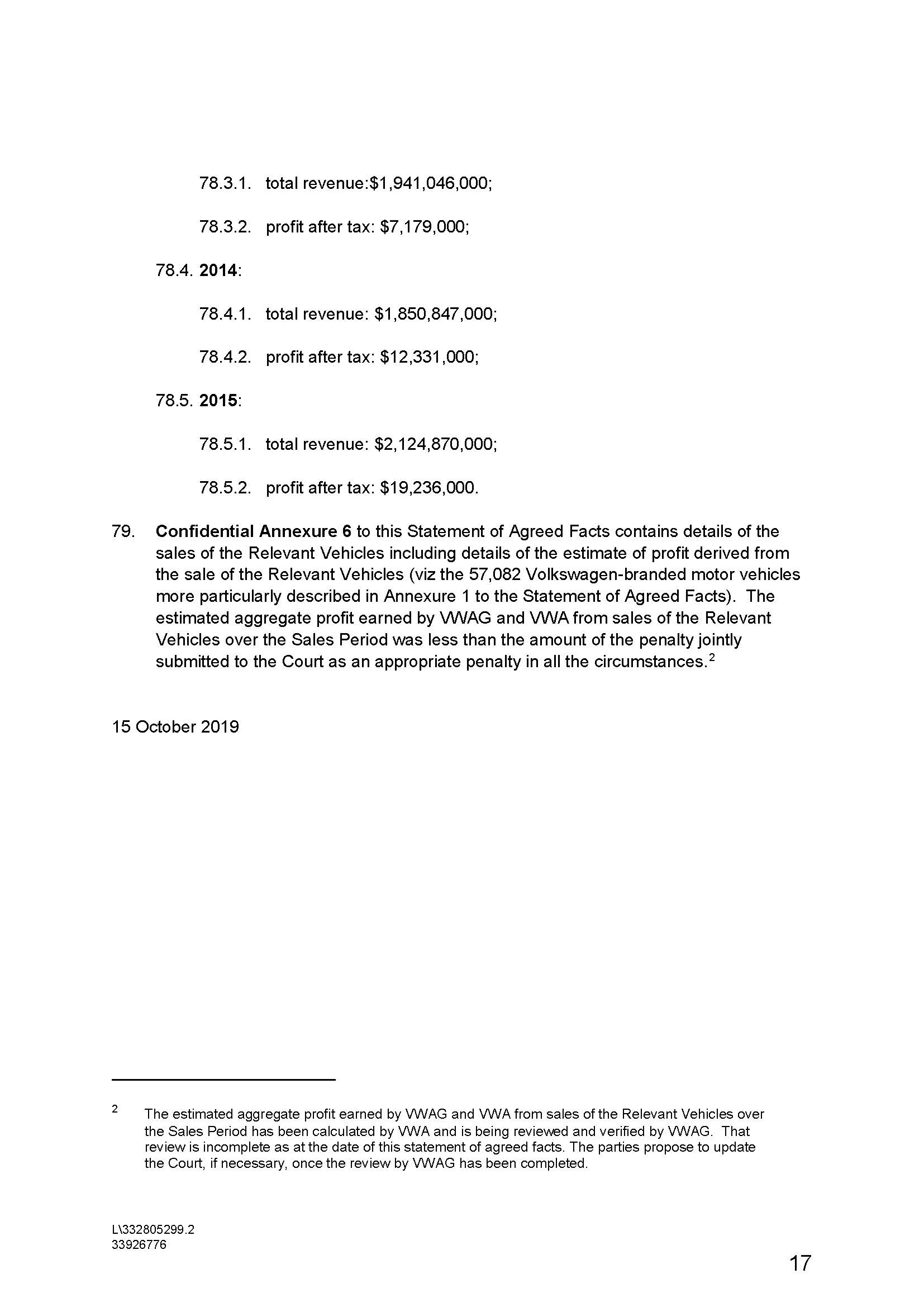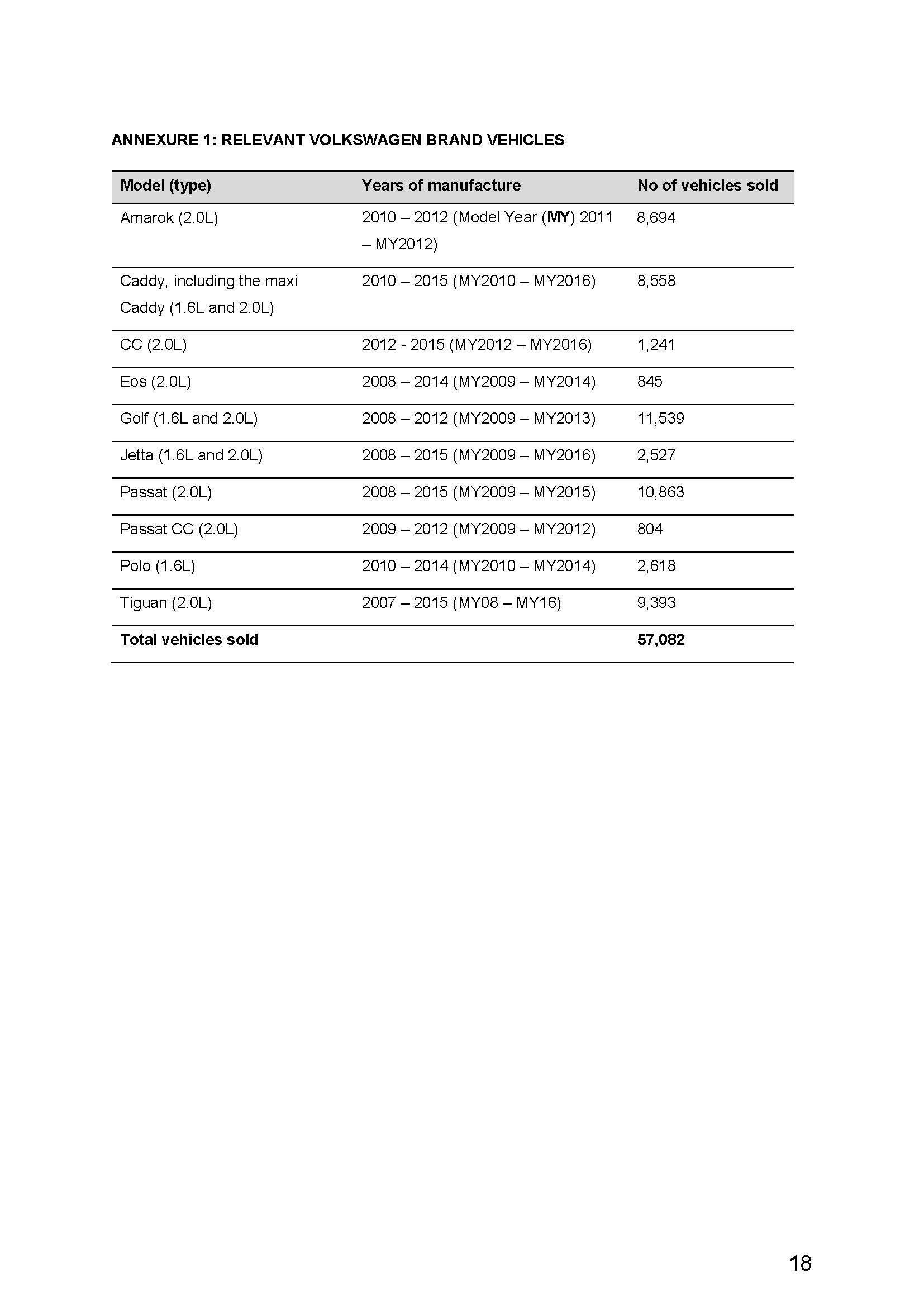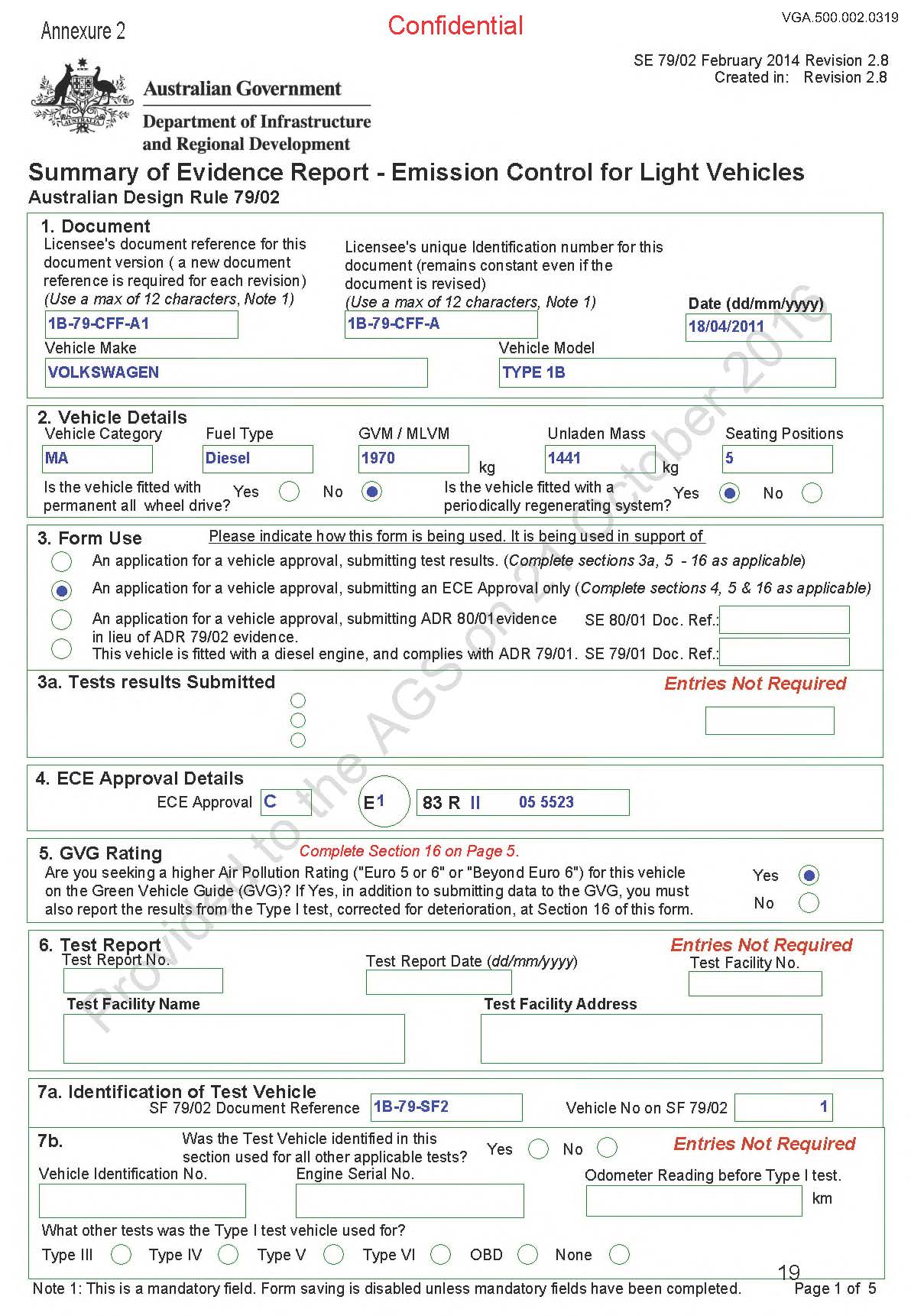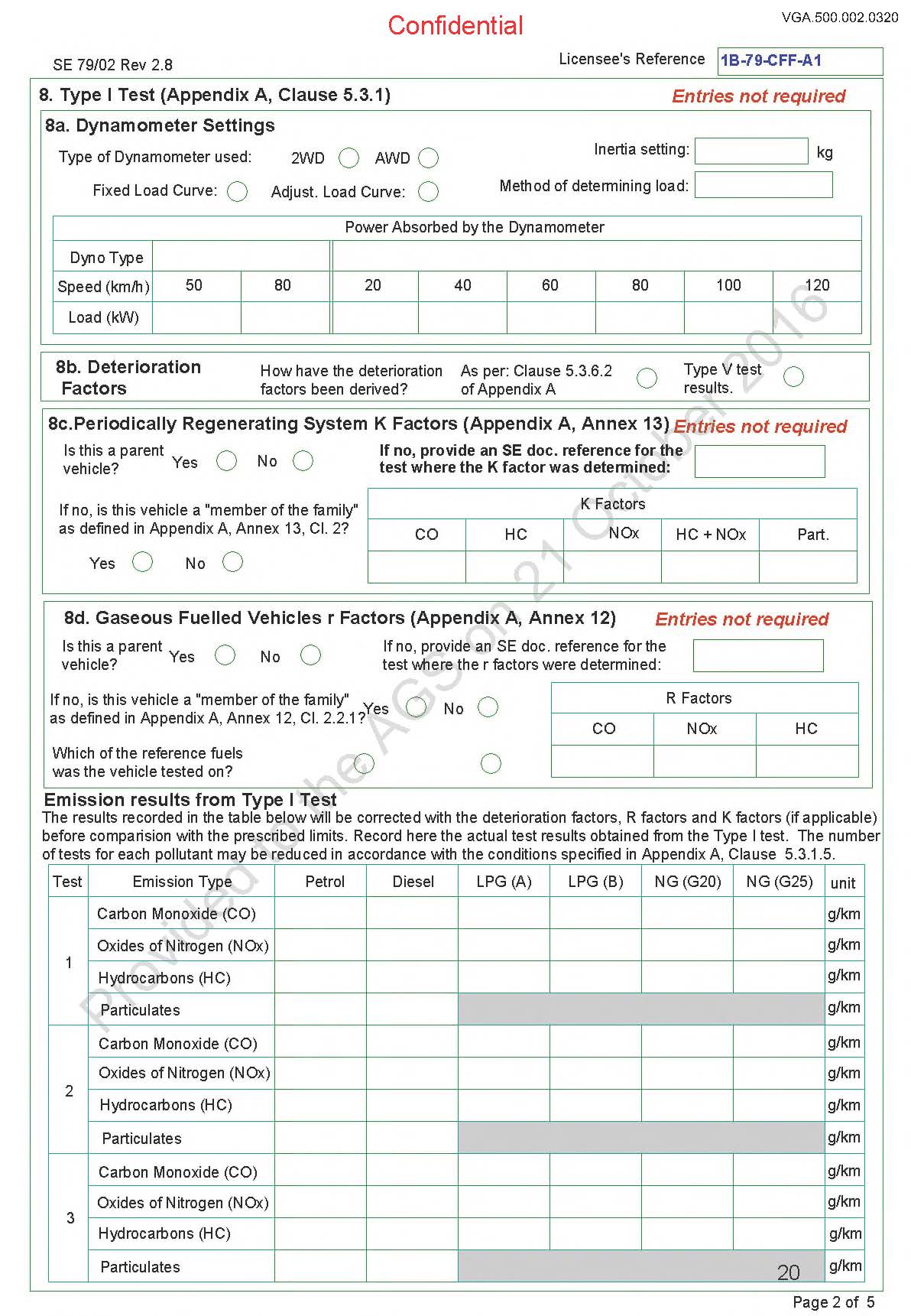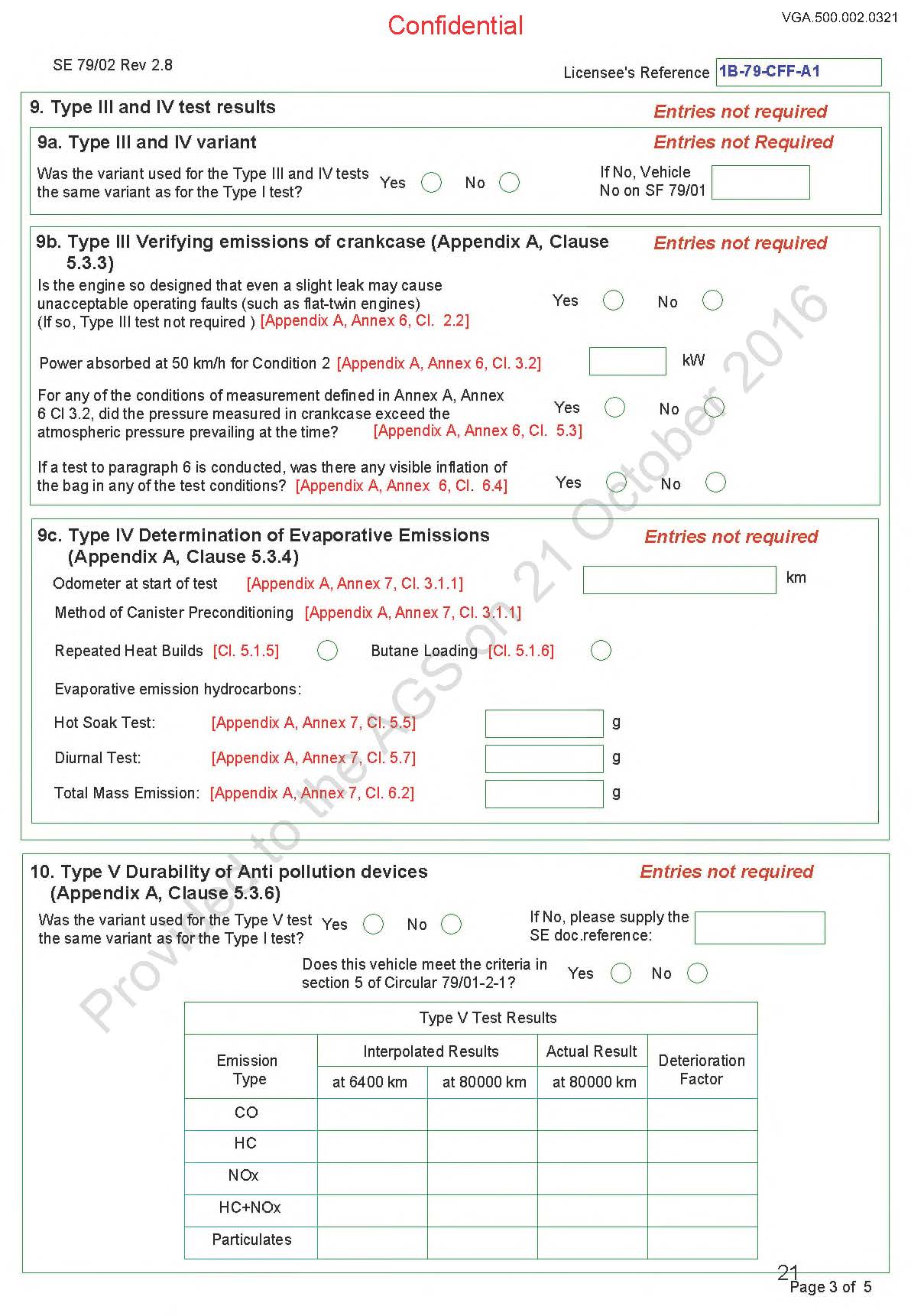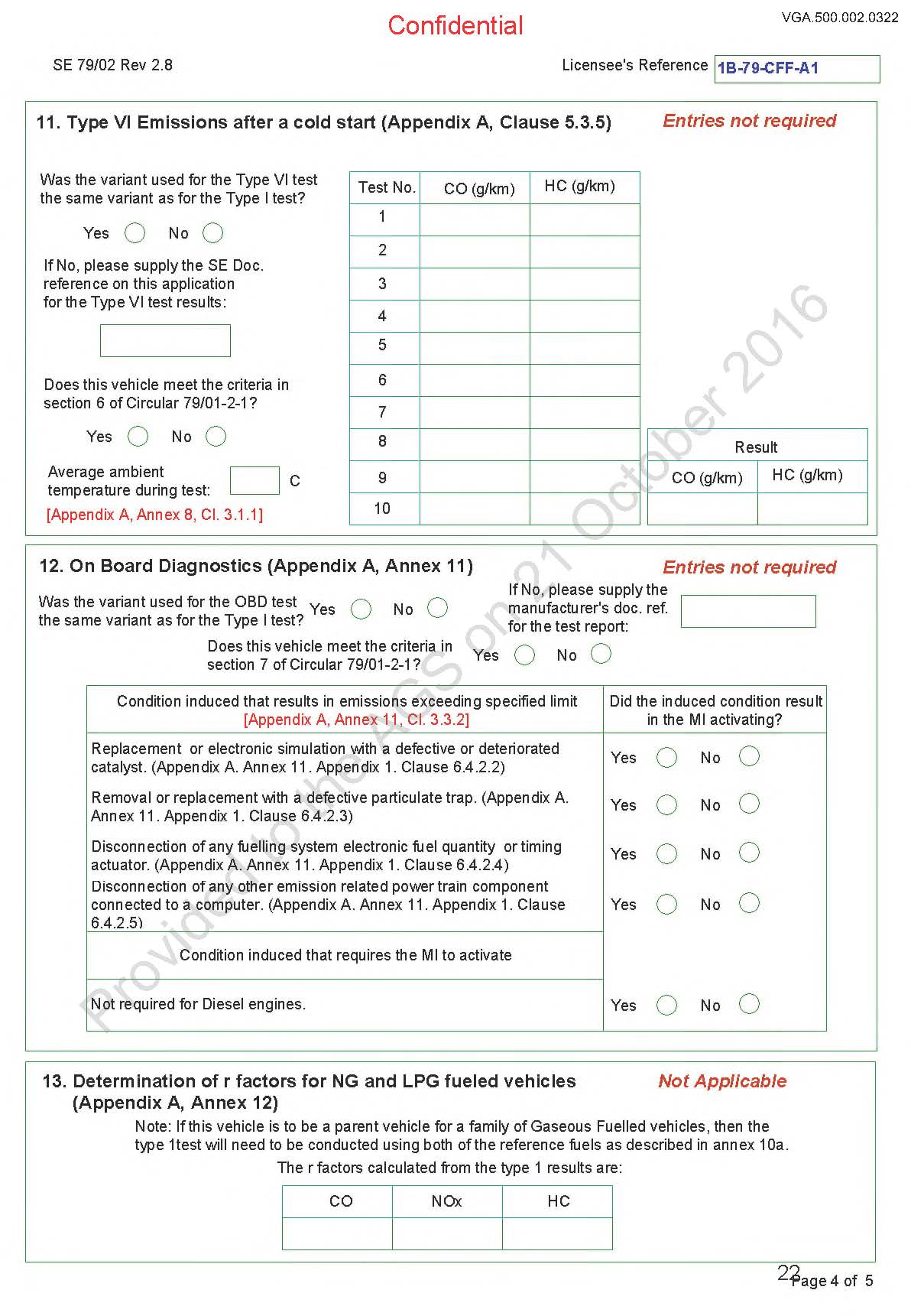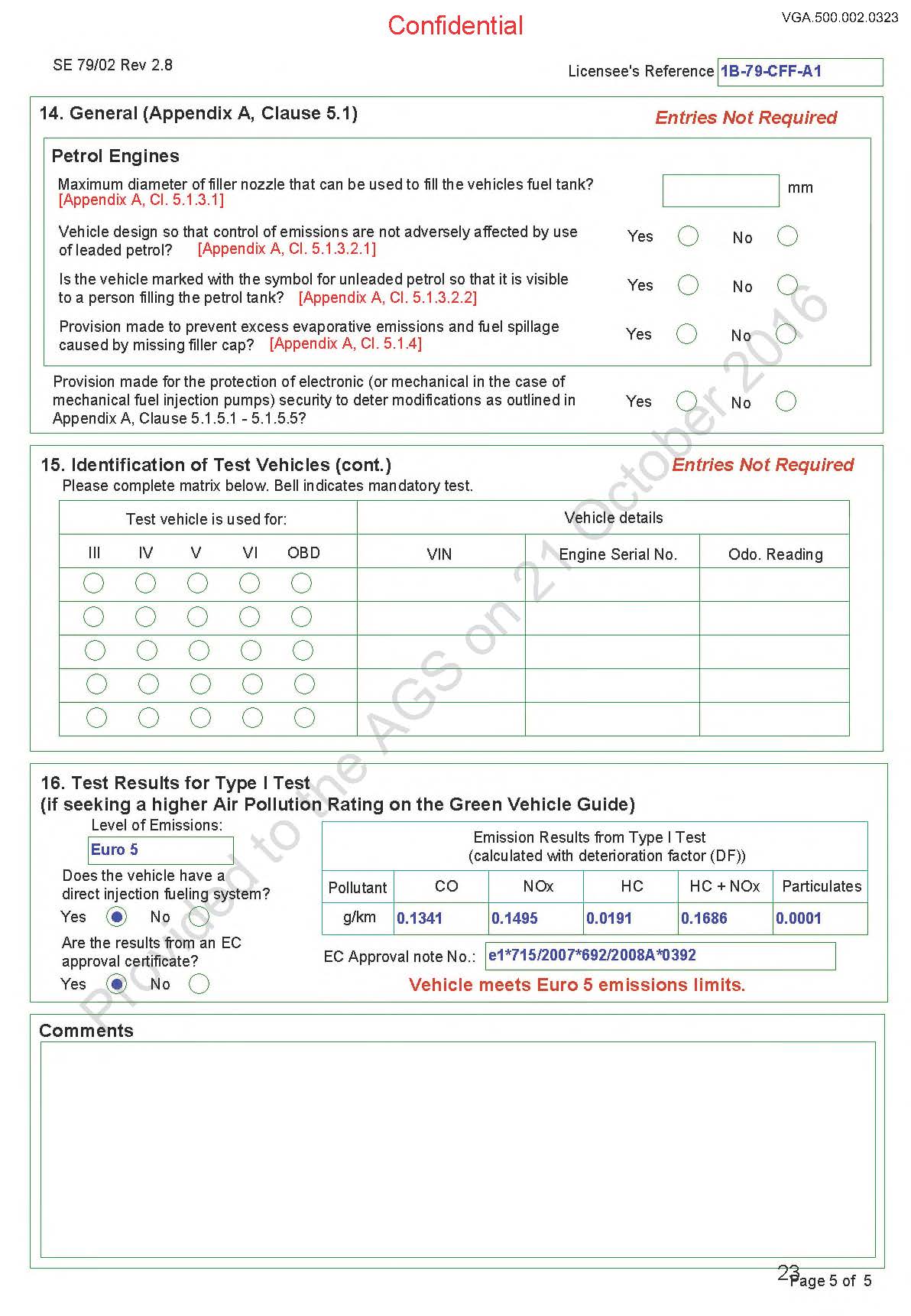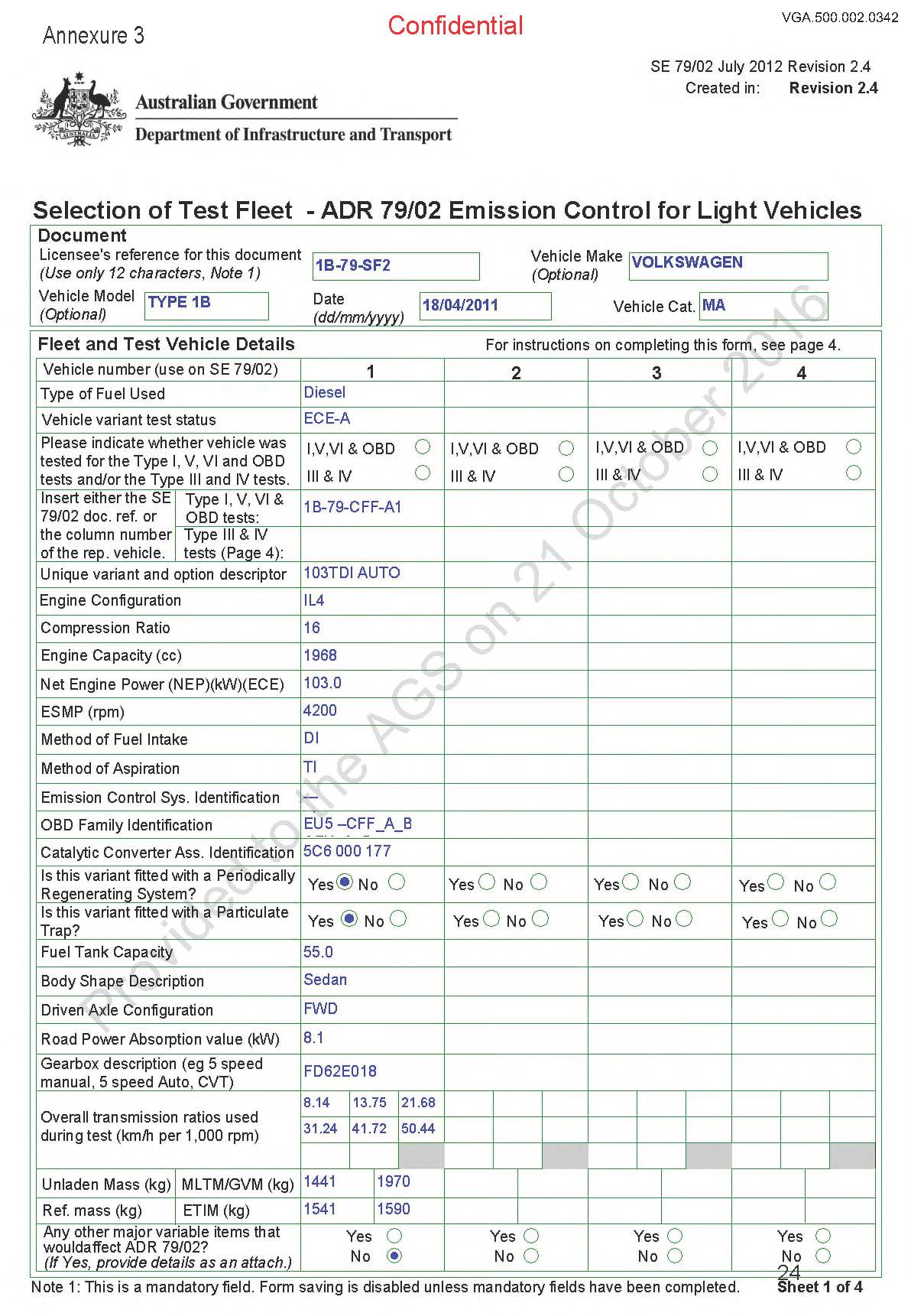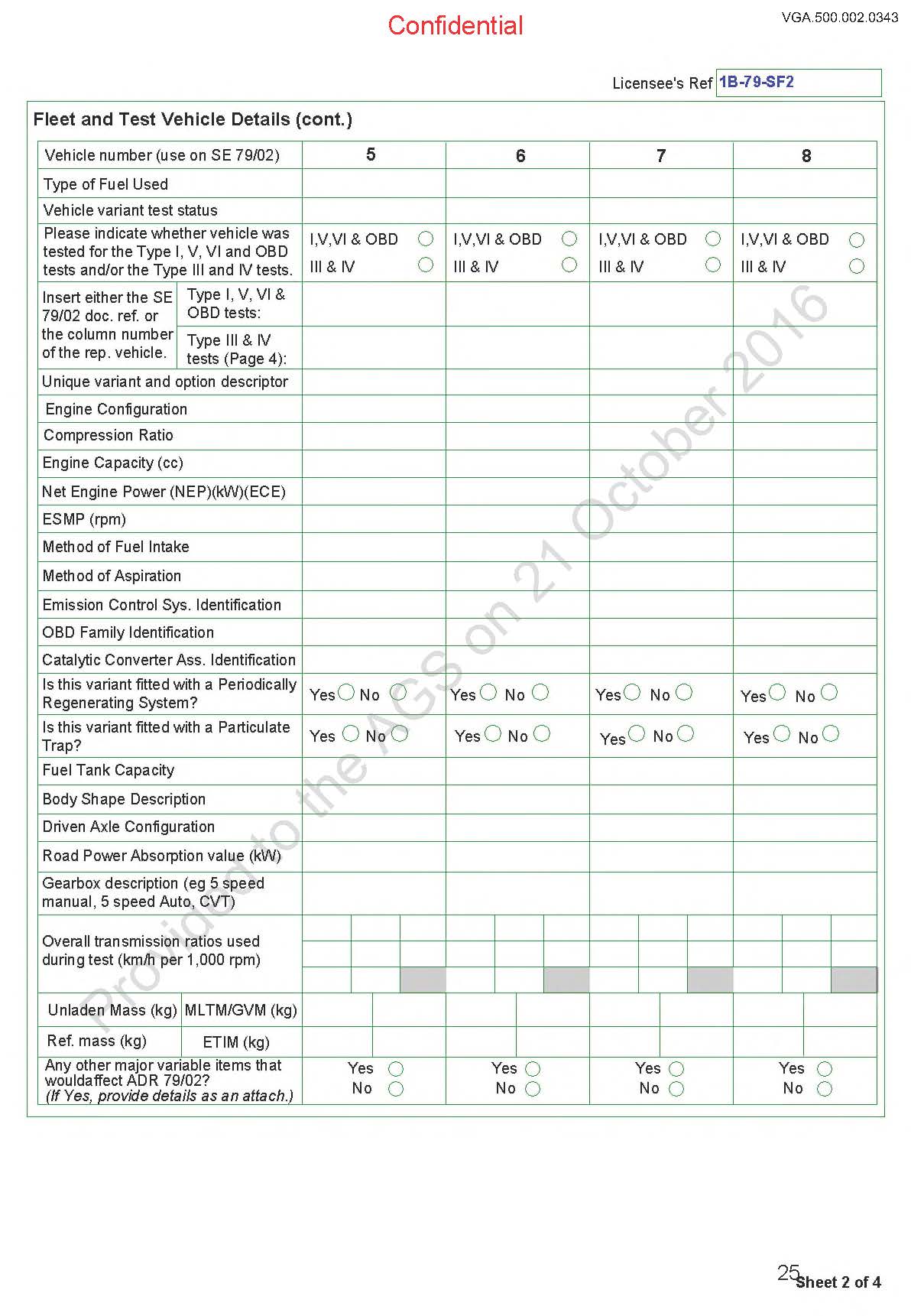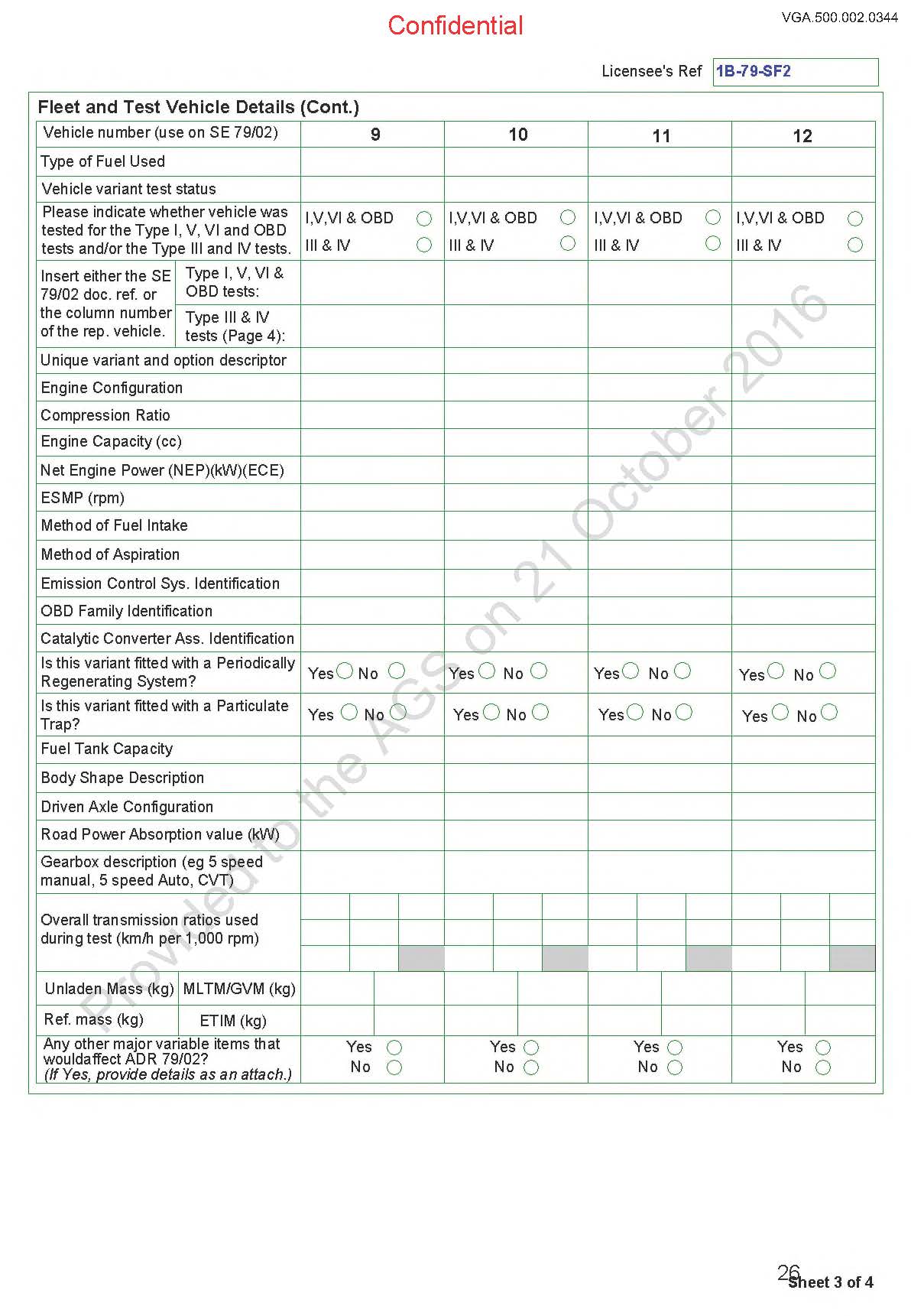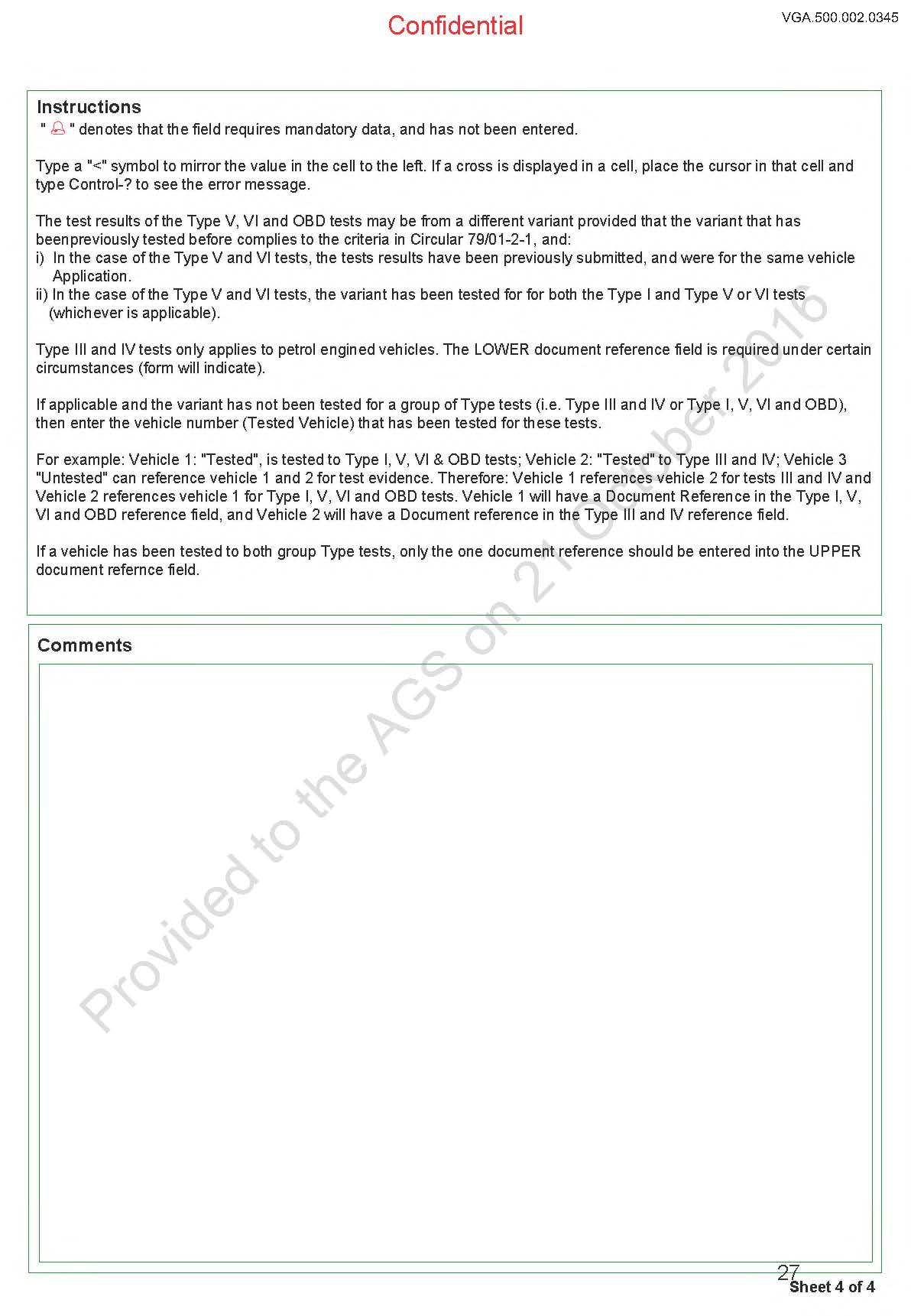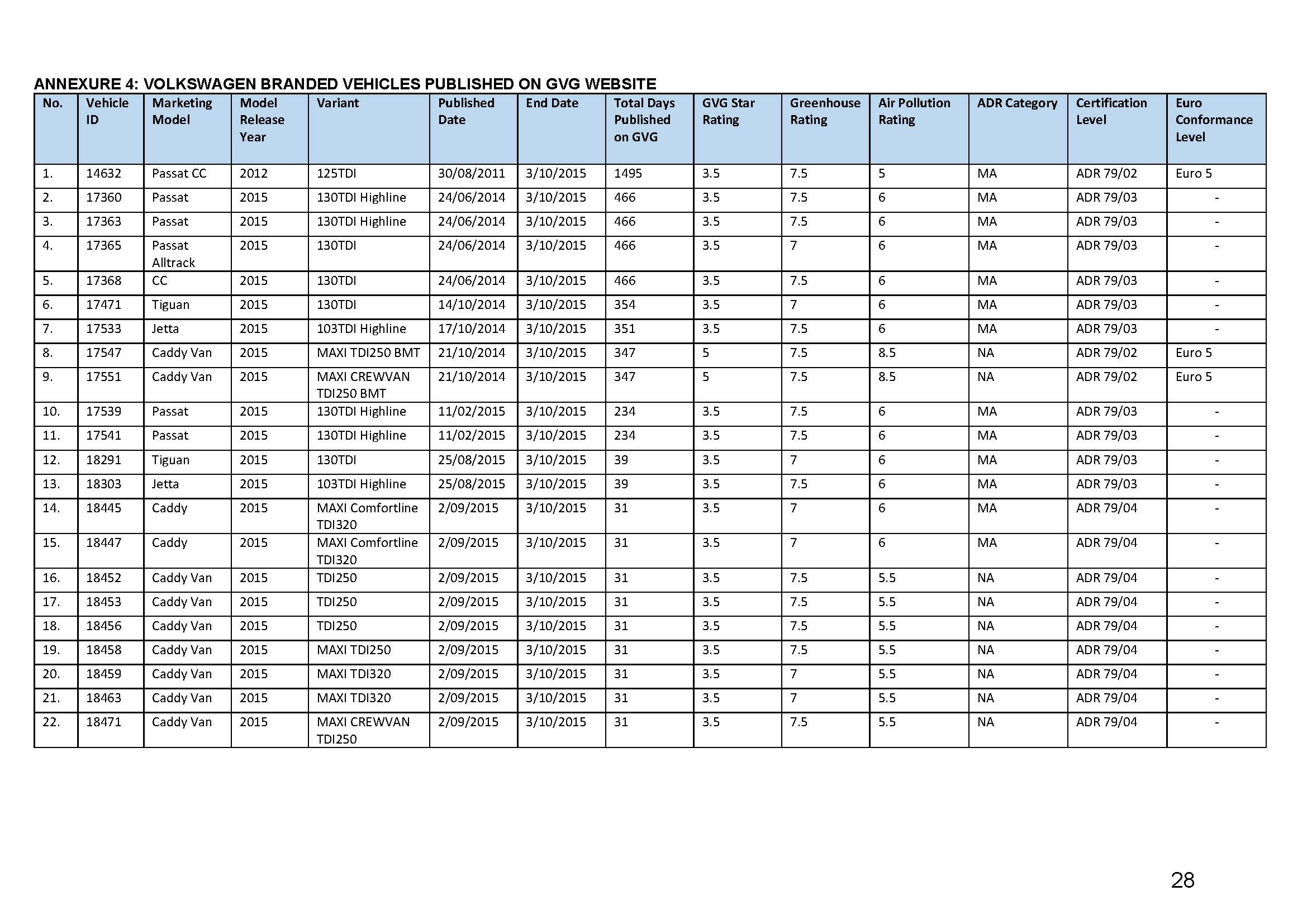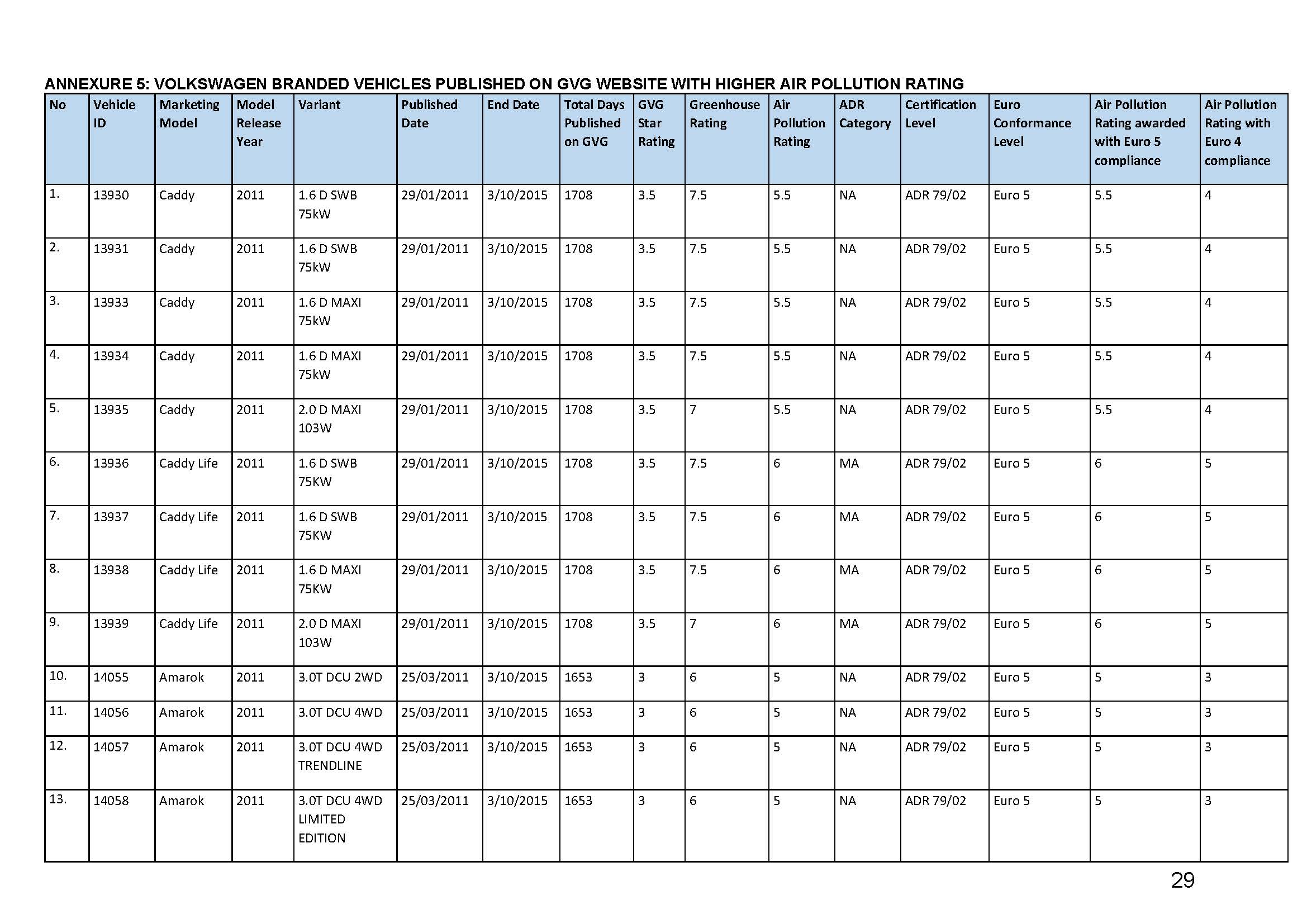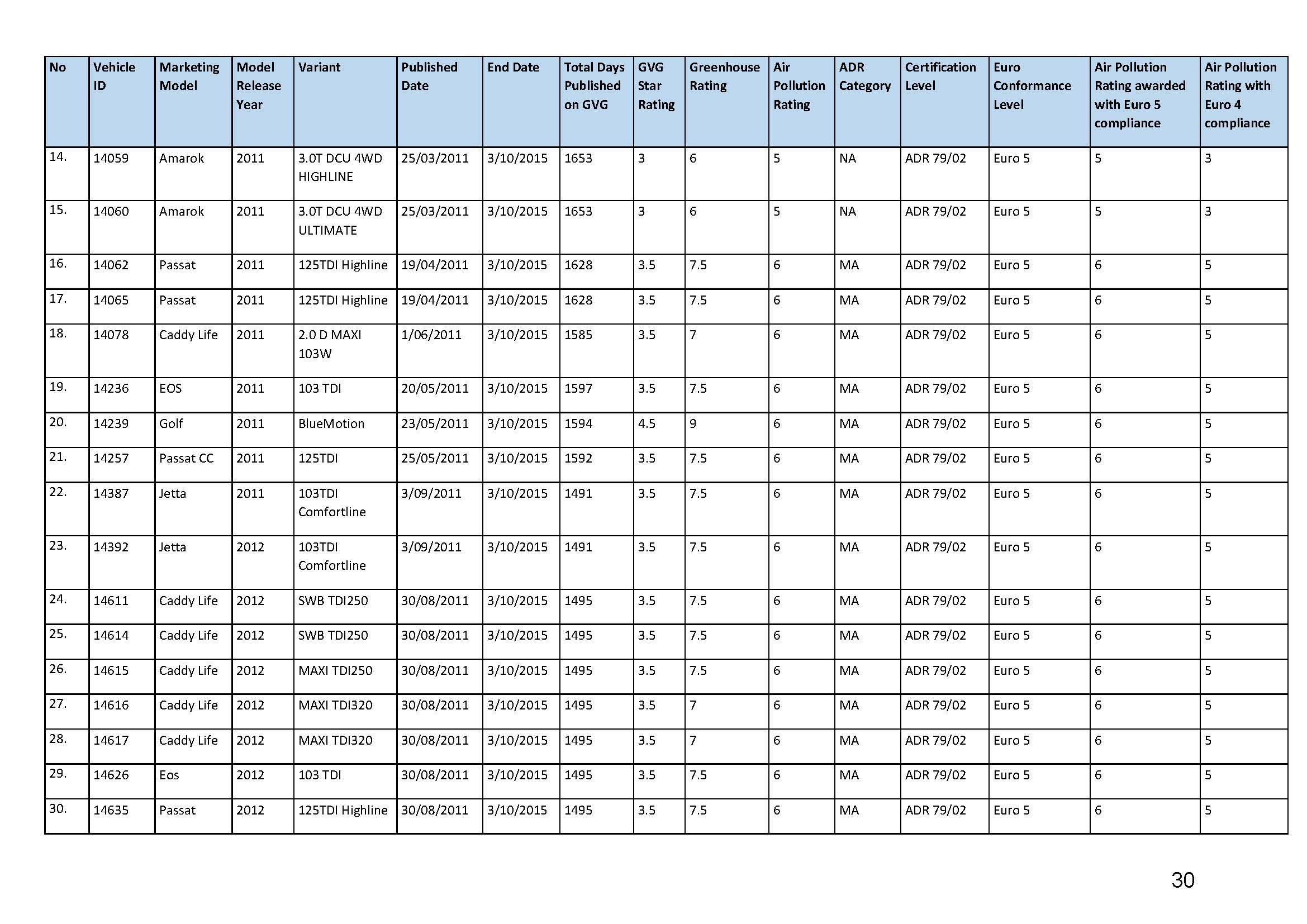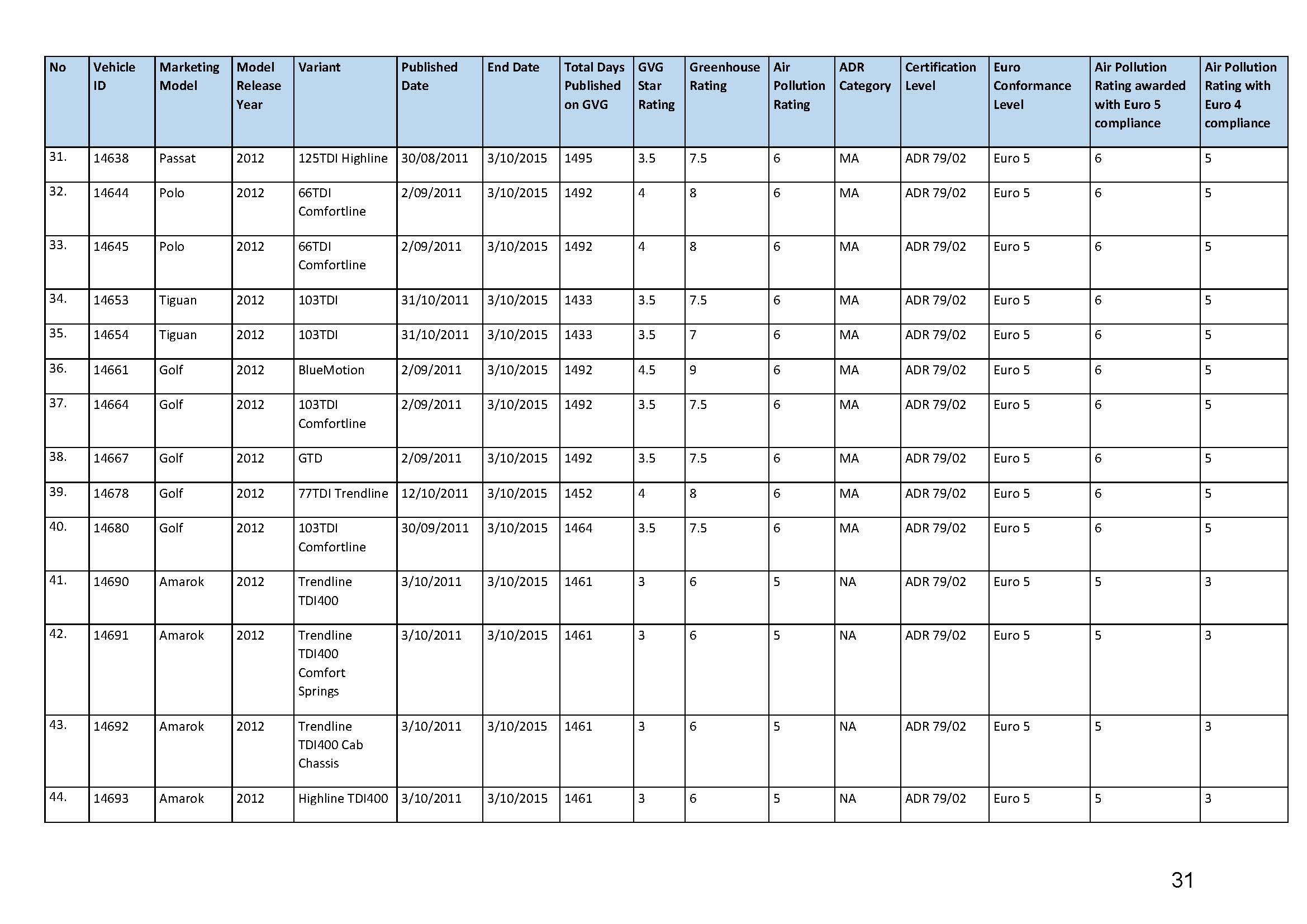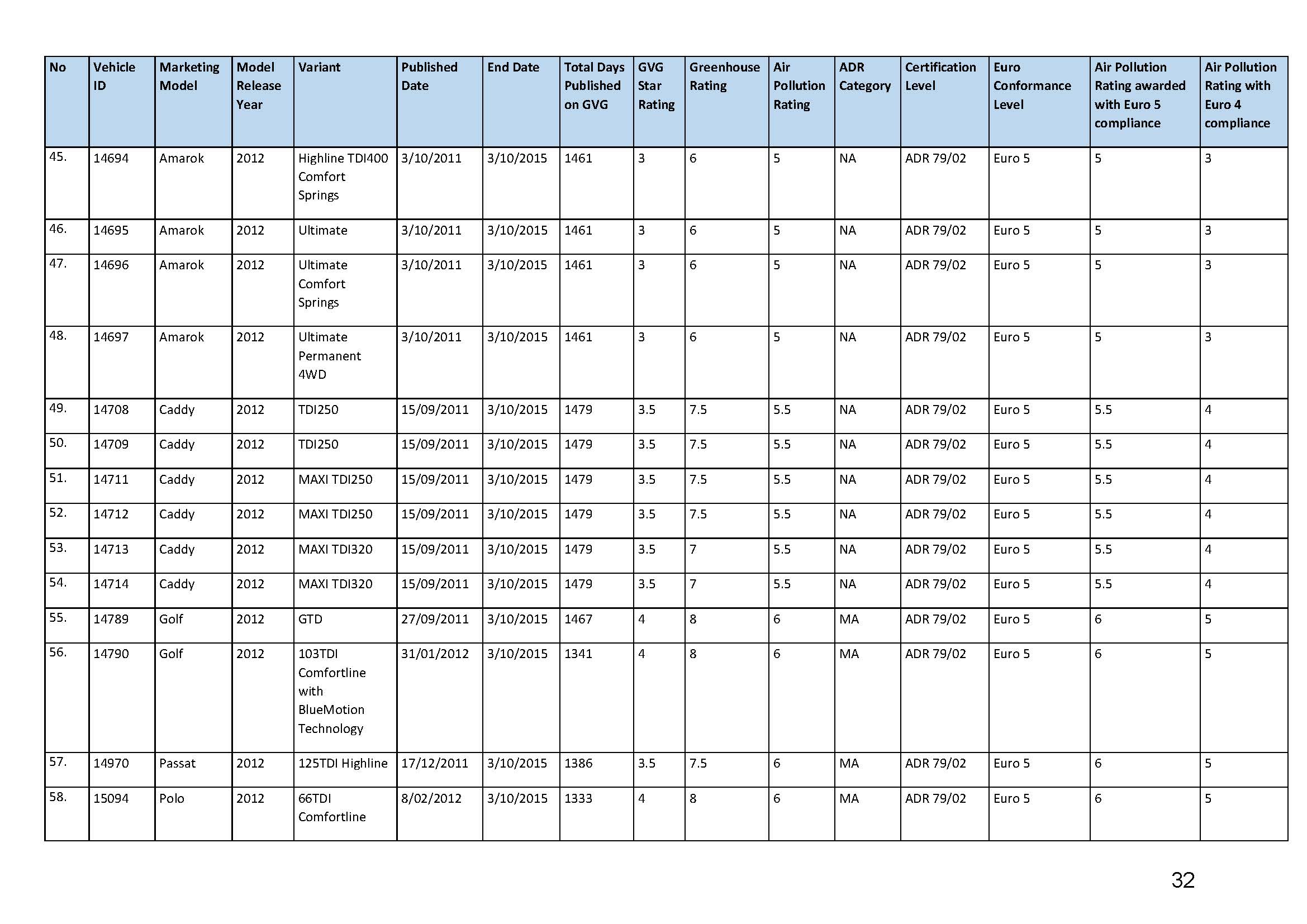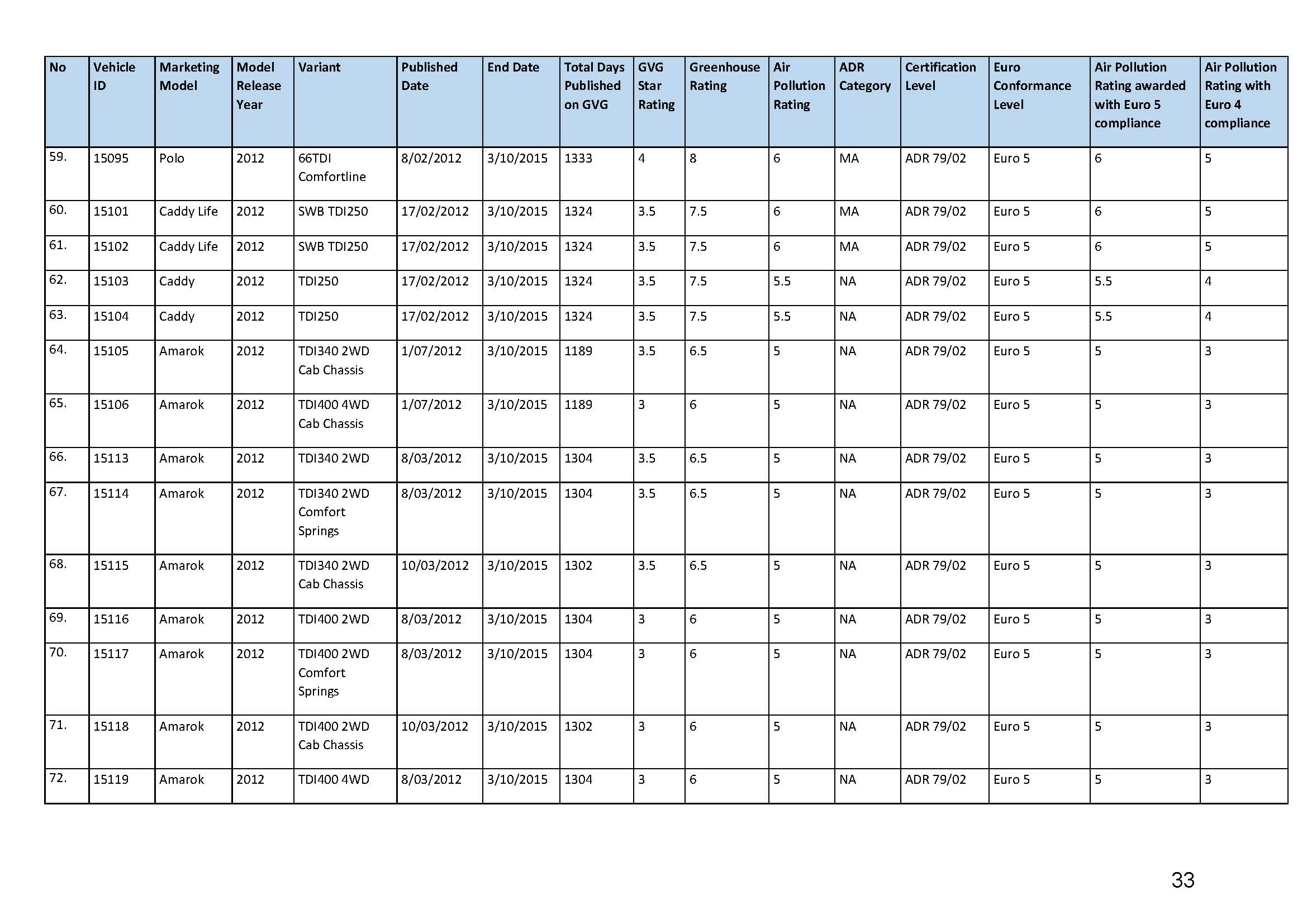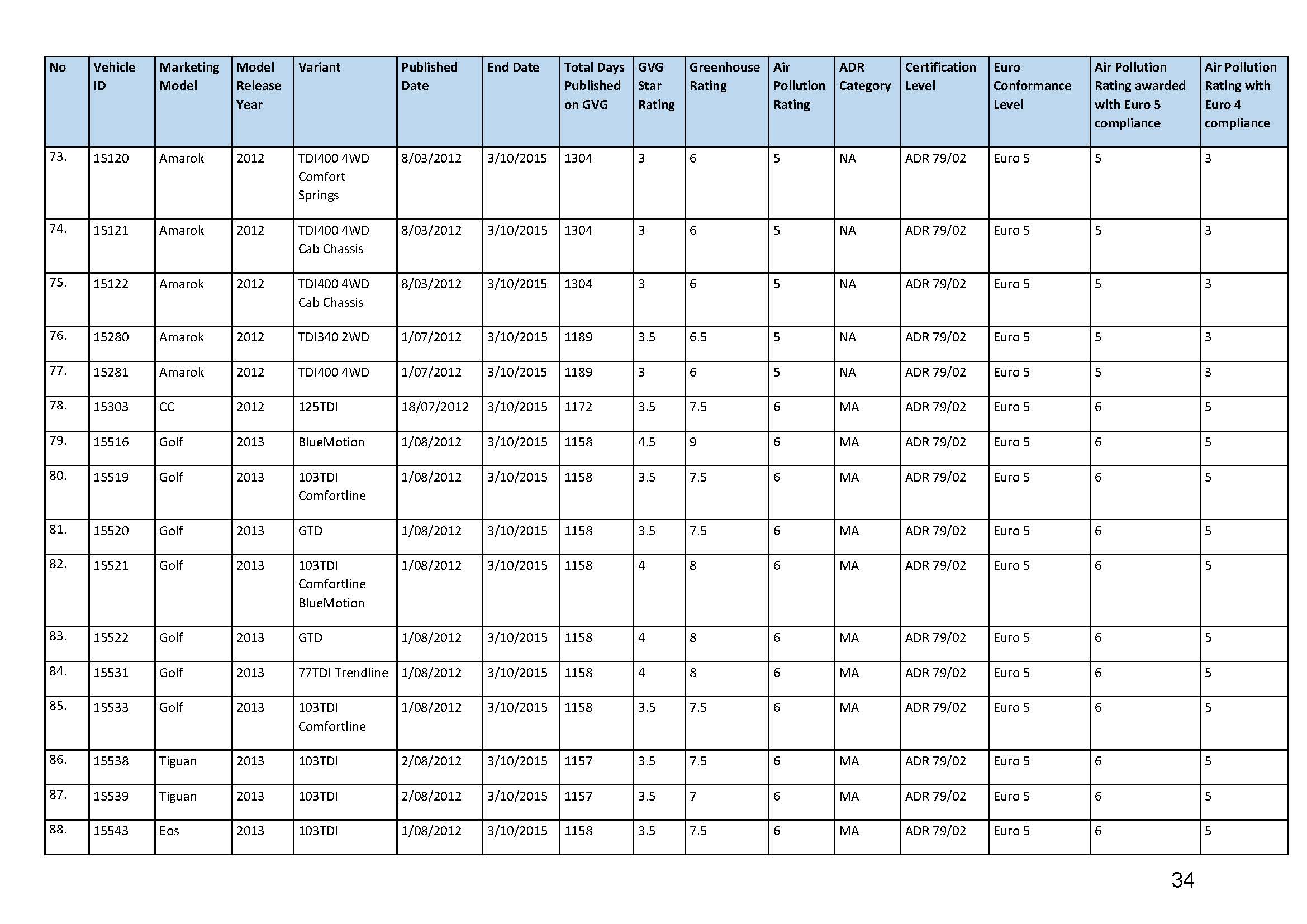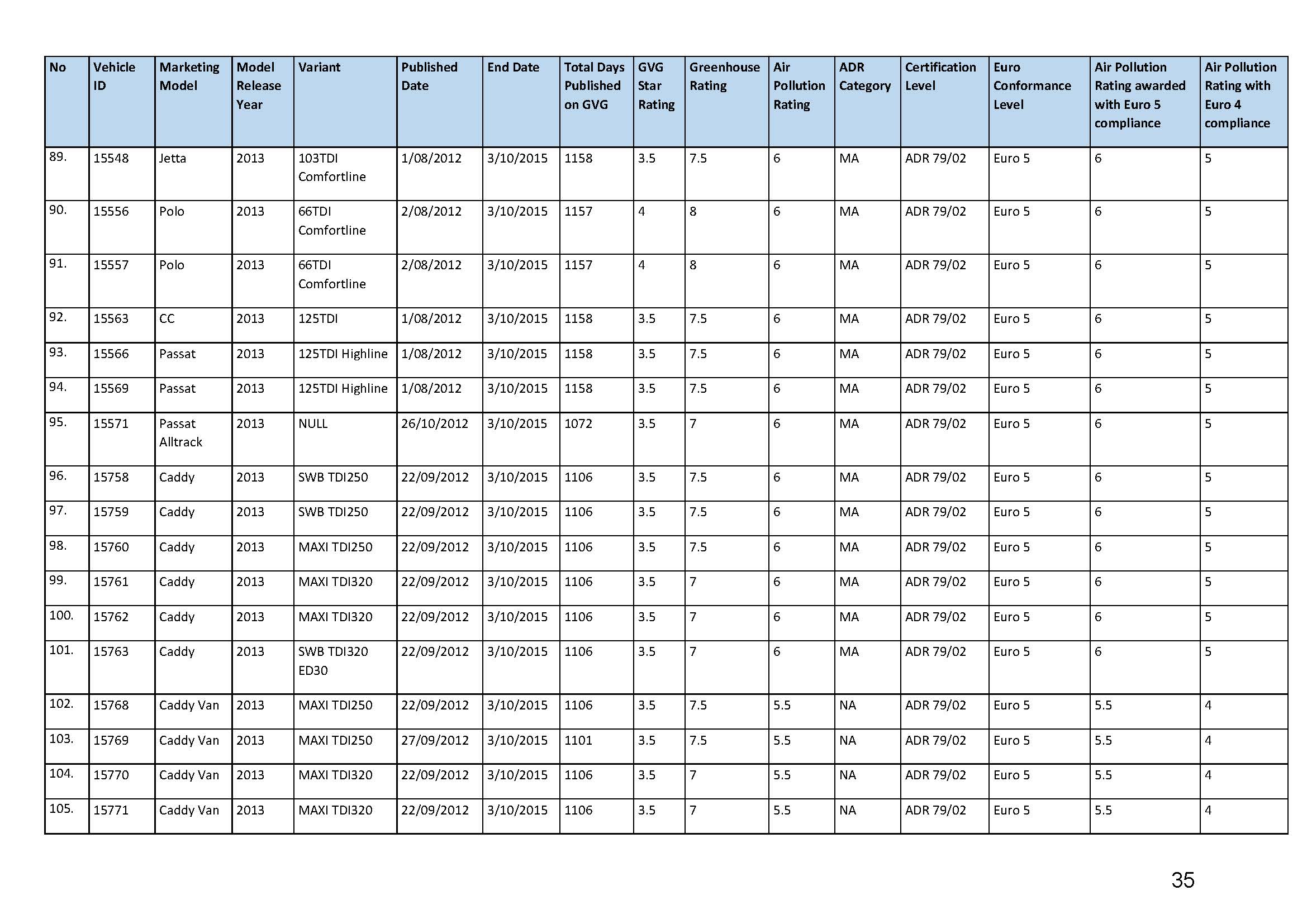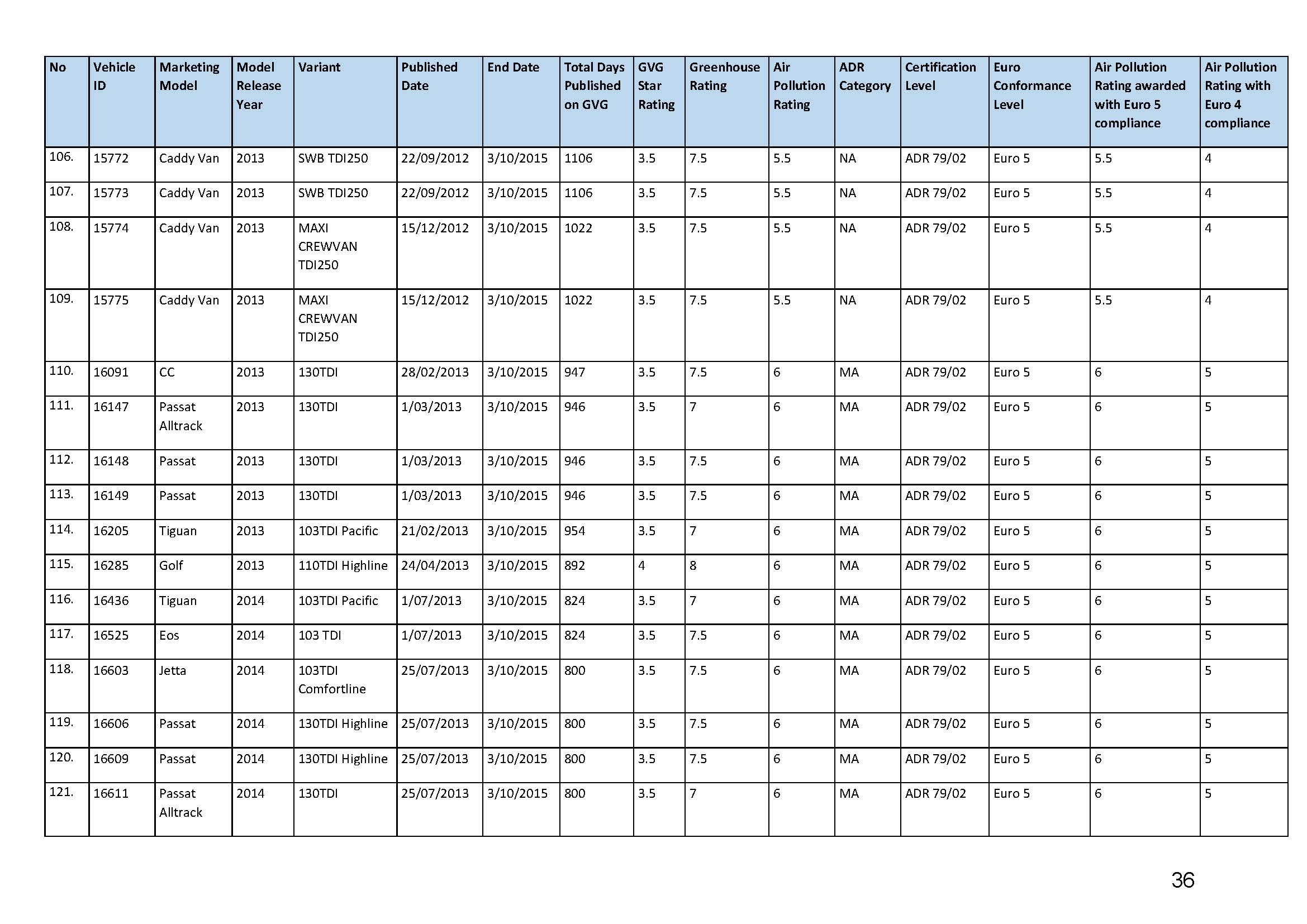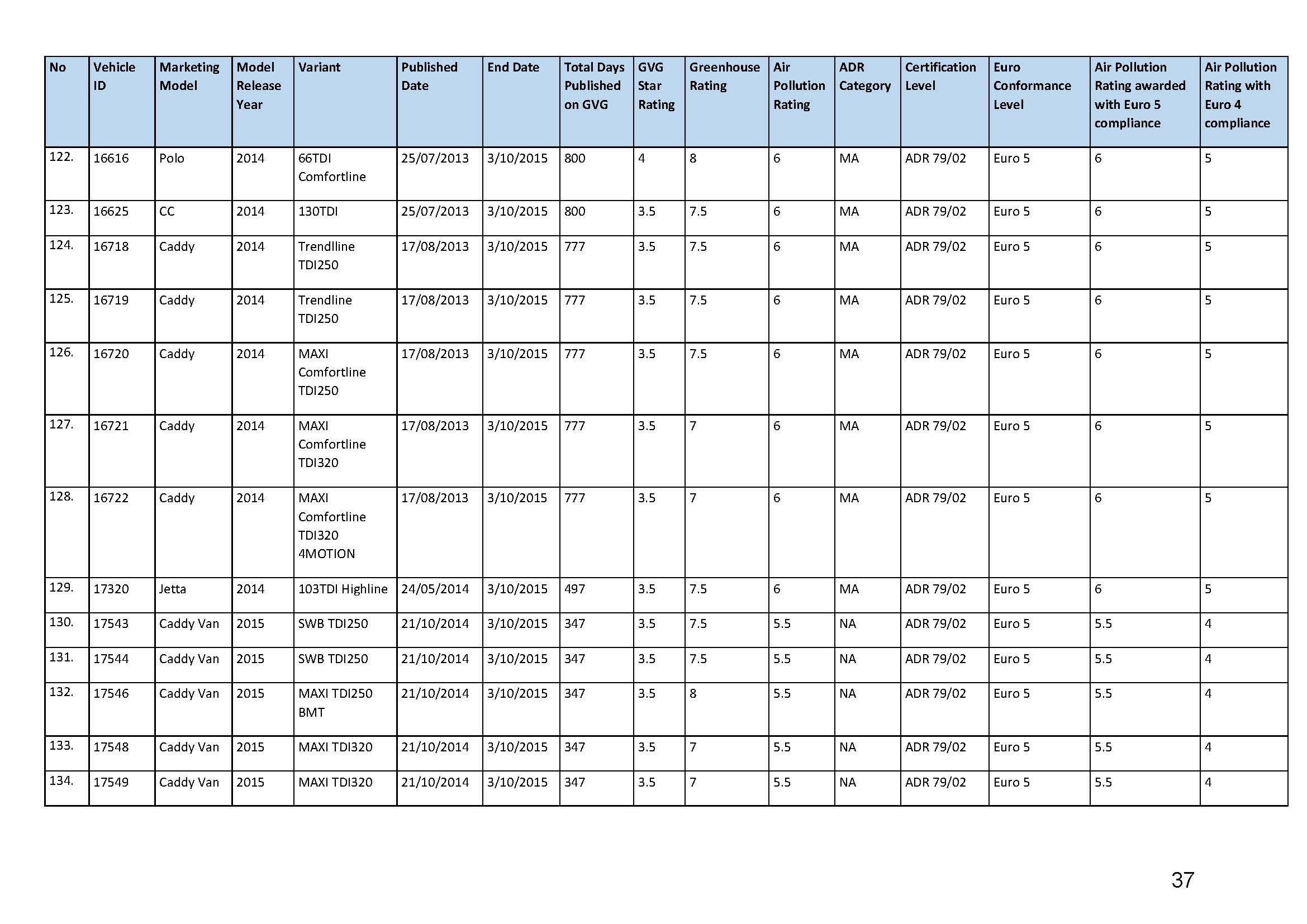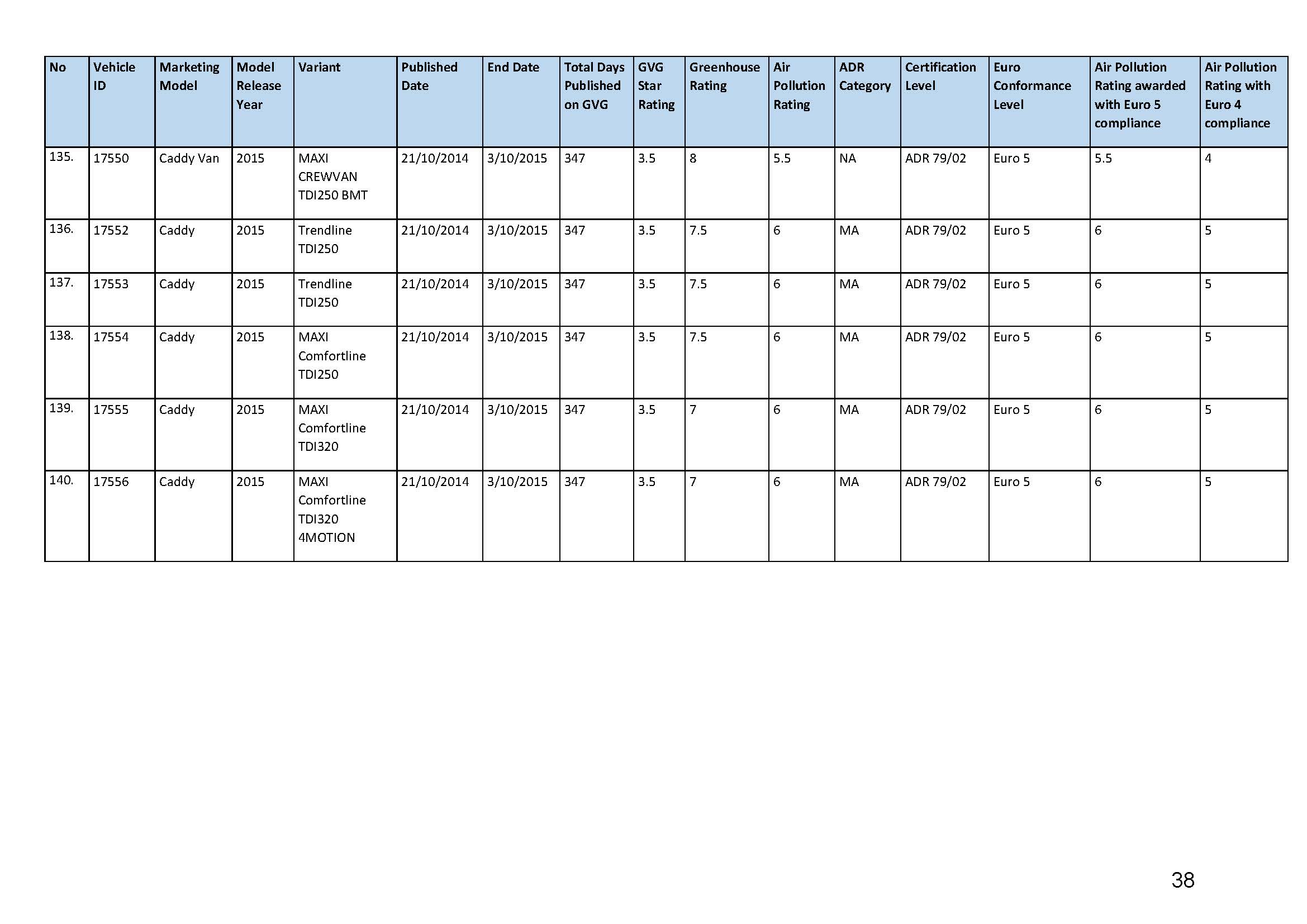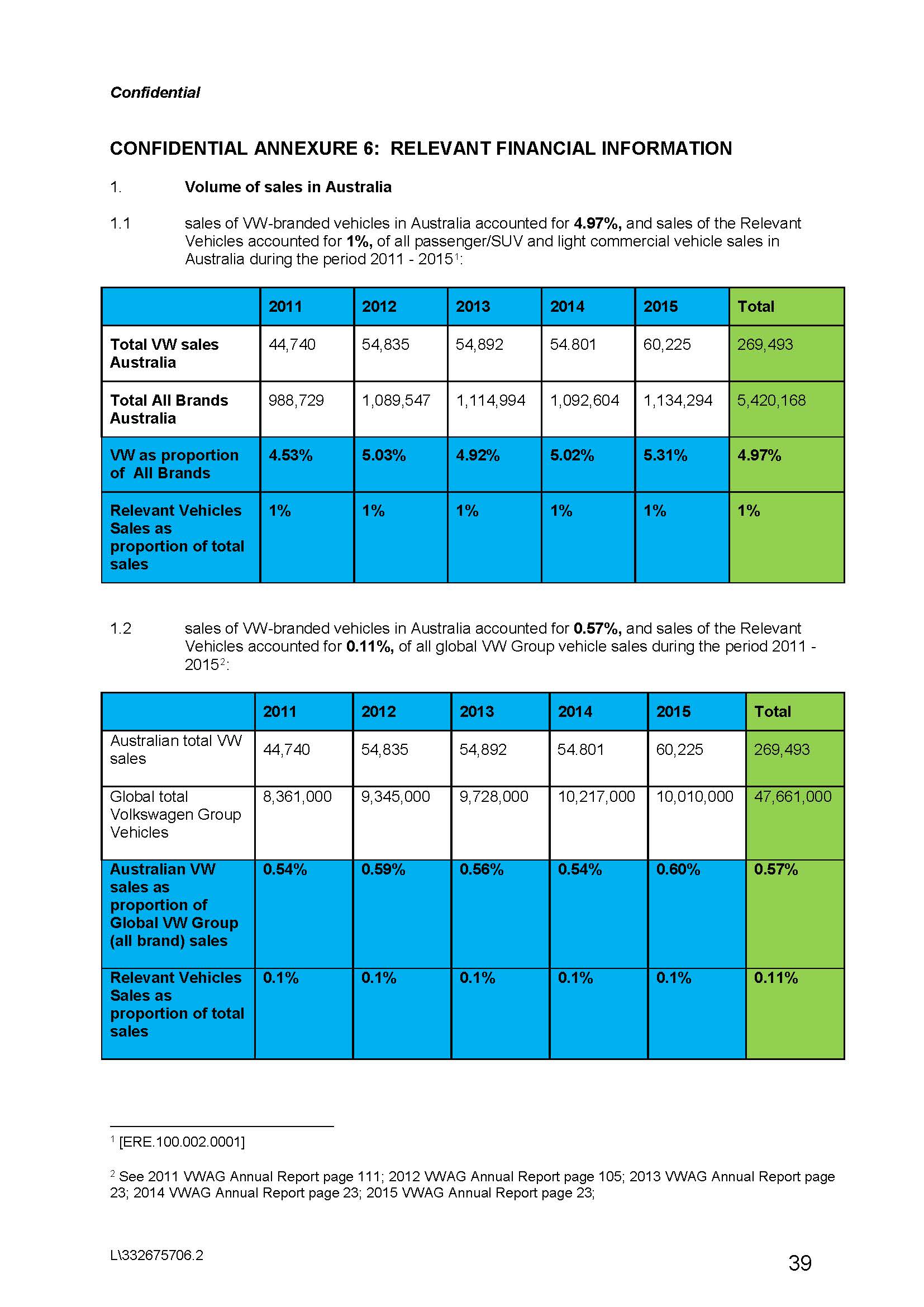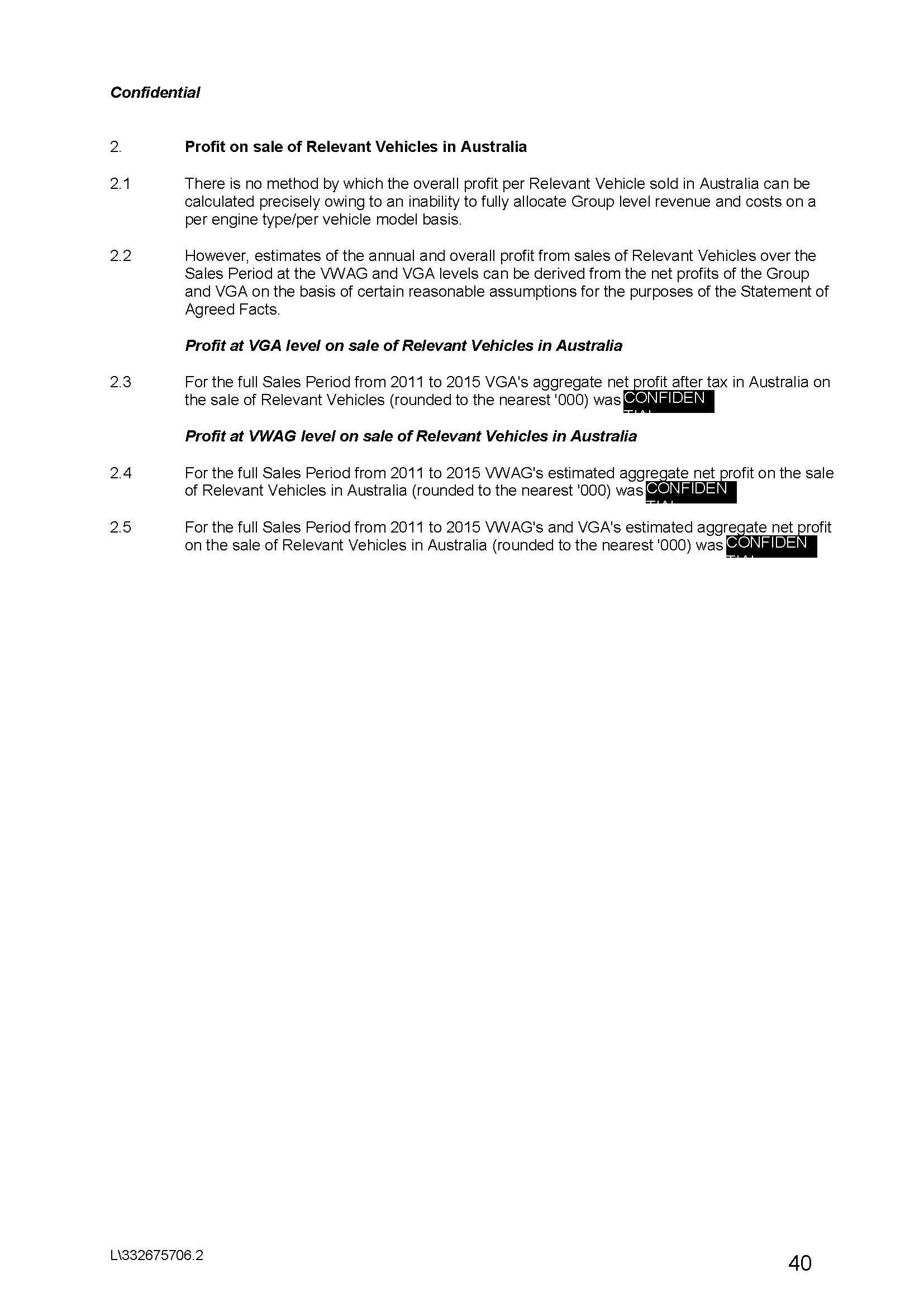FEDERAL COURT OF AUSTRALIA
Australian Competition and Consumer Commission v Volkswagen Aktiengesellschaft [2019] FCA 2166
Table of Corrections | |
29 January 2020 | In paragraph 272, replace the third last word (“conducted”) with the word “conduct”. |
In the second sentence of paragraph 273, replace the word “various” where it appears before the words “serious deception” with the word “very”. |
ORDERS
AUSTRALIAN COMPETITION AND CONSUMER COMMISSION Applicant | ||
AND: | First Respondent VOLKSWAGEN GROUP AUSTRALIA PTY LIMITED (ACN 093 117 876) Second Respondent | |
DATE OF ORDER: |
UPON the basis of the matters set out in the Statement of Agreed Facts dated 15 October 2019 (Ex C in the penalty hearing) (SOAF) and upon the basis of other material admitted into evidence at the penalty hearing and having considered the Joint Written Submissions of the parties dated 15 October 2019 and filed herein and the oral submissions made by the parties on 16 October 2019 and on 13 November 2019
THE COURT DECLARES THAT:
1. On 171 separate occasions in the period from 1 January 2011 to 3 October 2015 (Sales Period), in respect of 57,082 Volkswagen-branded motor vehicles more particularly described in Schedule 1 hereto (Relevant Vehicles), the first respondent (VWAG) submitted to the Delegate (delegate) of the Minister for Infrastructure and Regional Development the documents more particularly described in Schedule 2 hereto (approval applications) in order to obtain approvals under s 10A of the Motor Vehicle Standards Act 1989 (Cth) (MVSA) so that motor vehicles covered by the said approvals might be lawfully imported into Australia and supplied for use as road vehicles in Australia.
2. On each of the 171 occasions referred to in Declaration 1 above, by submitting the approval applications to the delegate, in all the circumstances and in the regulatory context in which such submissions were made, VWAG impliedly represented to the delegate that each of the Relevant Vehicles would, when imported into Australia and when supplied in Australia, comply with Australian Design Rule 79 (which is delegated legislation under the MVSA) (ADR 79) as in force from time to time during the Sales Period.
3. VWAG was granted identification plate approvals in respect of all of the Relevant Vehicles upon the basis of the information provided by it in or with the approval applications submitted to the delegate.
4. Each of the implied representations specified in Declaration 2 above was false because, in the events which happened, the Relevant Vehicles did not comply with ADR 79 when imported into Australia and when supplied in Australia in that:
(a) Each of the Relevant Vehicles was fitted with the Two Mode software more particularly described in Schedule 3 hereto (the contravening software); and
(b) If the Relevant Vehicles had been subjected to a New European Drive Cycle (NEDC) Type 1 test while operating in Mode 2, thereby substantially replicating the mode that would have been activated when the vehicles were driven on the road, the Relevant Vehicles would have exceeded the NOx emission limits prescribed by ADR 79,
with the consequence that, on each of the 171 occasions referred to in Declarations 1 and 2 above, in trade or commerce, in connection with the supply or possible supply of goods, namely, the Relevant Vehicles, VWAG made a false representation as to the composition, standard or grade of the vehicles the subject of the approval application in each case and thereby, on each such occasion, contravened s 29(1)(a) of the Australian Consumer Law (ACL), being Sch 2 to the Competition and Consumer Act 2010 (Cth).
5. By making the applications specified in Schedule 4 hereto from time to time in the Sales Period through the online administration portal on the GVG Website administered by the Department of Infrastructure and Regional Development (DIRD), VWAG falsely represented to DIRD on at least 162 occasions in respect of the Volkswagen-branded vehicles identified in Annexures 4 and 5 to the SOAF that the motor vehicles the subject of each such application complied with ADR 79 as in force at the relevant time when, in fact, those vehicles did not so comply because:
(a) The engine in each of the said vehicles was fitted with the contravening software; and
(b) If the said vehicles had been subjected to an NEDC Type 1 test while operating in Mode 2, thereby substantially replicating the mode that would have been activated when the vehicles were driven on the road, the said vehicles would have exceeded the NOx emission limits prescribed by ADR 79,
resulting in the said vehicles obtaining ratings on the GVG Website which they would not have obtained had the said false representations not been made with the consequence that, on each of the 162 occasions referred to above, in trade or commerce, in connection with the supply or possible supply of goods, namely the Relevant Vehicles, or in connection with the promotion of the supply or use of the said goods, VWAG made a false representation as to the composition, standard or grade of the said vehicles the subject of the listing application in each case and thereby, on each such occasion, contravened s 29(1)(a) of the ACL.
6. By making the additional applications specified in Schedule 5 hereto from time to time in the Sales Period, through the online administration portal on the GVG Website, VWAG falsely represented to DIRD on at least 140 occasions in respect of the Volkswagen-branded vehicles identified in Annexure 5 to the SOAF that the motor vehicles the subject of each such application complied with a later, more stringent version of ADR 79 than was applicable to the vehicles at the relevant time when, in fact, those vehicles did not so comply with that more stringent version because:
(a) The engine in each of the said vehicles was fitted with the contravening software; and
(b) If the said vehicles had been subjected to an NEDC Type 1 test while operating in Mode 2, thereby substantially replicating the mode that would have been activated when the vehicles were driven on the road, the said vehicles would have exceeded the NOx emission limits prescribed by ADR 79,
resulting in the said vehicles obtaining higher air pollution ratings on the GVG Website than they would have obtained had the said false representations not been made with the consequence that, on each of the 140 occasions referred to above, in trade or commerce, in connection with the supply or possible supply of goods, namely the Relevant Vehicles, or in connection with the promotion of the supply or use of the said goods, VWAG made a false representation as to the composition, standard or grade of the said vehicles the subject of the listing application in each case and thereby, on each such occasion, contravened s 29(1)(a) of the ACL.
AND THE COURT ORDERS THAT:
7. Pursuant to s 224(1) of the ACL, within twenty-eight (28) days of the making of this Order, VWAG pay to the Commonwealth of Australia a pecuniary penalty of $125,000,000 (One Hundred and Twenty-Five Million Dollars) in respect of the contraventions of the ACL declared at Declarations 4, 5 and 6 above.
8. Within twenty-eight (28) days of the making of this Order, VWAG pay the applicant’s costs of and incidental to this proceeding agreed in the amount of $4,000,000 (Four Million Dollars).
9. The remaining claims for relief made by the applicant in this proceeding (including all claims for relief made in any Interlocutory Applications which have not been determined as at the date hereof) be dismissed.
Note: Entry of orders is dealt with in Rule 39.32 of the Federal Court Rules 2011.
SCHEDULE 1
RELEVANT VOLKSWAGEN BRANDED VEHICLES
Model (type) | Years of manufacture | No of vehicles sold |
Amarok (2.0L) | 2010–2012 (Model Year (MY) 2011 – MY2012) | 8,694 |
Caddy, including the maxi Caddy (1.6L and 2.0L) | 2010–2015 (MY2010 – MY2016) | 8,558 |
CC (2.0L) | 2012–2015 (MY2012 – MY2016) | 1,241 |
Eos (2.0L) | 2008–2014 (MY2009 – MY2014) | 845 |
Golf (1.6L and 2.0L) | 2008–2012 (MY2009 – MY2013) | 11,539 |
Jetta (1.6L and 2.0L) | 2008–2015 (MY2009 – MY2016) | 2,527 |
Passat (2.0L) | 2008–2015 (MY2009 – MY2015) | 10,863 |
Passat CC (2.0L) | 2009–2012 (MY2009 – MY2012) | 804 |
Polo (1.6L) | 2010–2014 (MY2010 – MY2014) | 2,618 |
Tiguan (2.0L) | 2007–2015 (MY2008 – MY2016) | 9,393 |
Total vehicles sold | 57,082 |
SCHEDULE 2
Documents submitted to the Delegate of the Minister for Infrastructure and Regional Development in order to obtain approvals under s 10A of the Motor Vehicle Standards Act 1989 (Cth):
(i) Application for Compliance Approval Forms;
(ii) In some cases, Selection Test Fleet Forms; and
(iii) Summary of Evidence Forms.
SCHEDULE 3
The Two Mode Software
(a) The operation of the Two Mode Software is described in more detail in the Agreed Technical Document dated 17 February 2017 tendered and admitted into evidence in the Stage 1 hearing (CRT.500.001.0001). The text of the said Agreed Technical Document (excluding annexures and appendices) was admitted into evidence in the penalty hearing as Exhibit A.
(b) In summary, simplifying the description in that document:
(i) All of the Relevant Vehicles contained an exhaust gas recirculation system (EGR System).
(ii) In all Relevant Vehicles, the EGR System is controlled by the Engine Control Units (ECU).
(iii) All of the Relevant Vehicles contained software in their ECU which, subject to certain operating conditions, caused the EGR System to operate in one of two modes (Two Mode Software):
(A) Mode 1 was optimised for NOx and other pollutant emissions (primarily by specifying lower target air mass which would be expected to result in a higher Exhaust Gas Recirculation (EGR) Rate and compliance with applicable emissions limits).
(B) Mode 2 was the mode optimised for comfort including fuel economy, reliable regeneration of the particulate filter and noise, vibration and harshness (primarily by specifying a higher target air mass which would be expected to result in a lower EGR Rate), which would result in higher NOx emissions than in Mode 1.
(iv) The Two Mode Software caused Mode 1 to operate when the Relevant Vehicles were being driven after start-up according to the Type 1 emissions test (which used the NEDC), which is the primary legislated emissions test in Australia. At all other times, the Two Mode Software caused the Relevant Vehicles to operate in Mode 2.
SCHEDULE 4
Applications to have the Volkswagen-branded vehicles more particularly described in Annexures 4 and 5 to the SOAF included on the GVG Website.
SCHEDULE 5
Applications to have the vehicles more particularly described in Annexure 5 to the SOAF given a higher air pollution rating on the GVG Website.
ORDERS
NSD 322 of 2017 | ||
BETWEEN: | AUSTRALIAN COMPETITION AND CONSUMER COMMISSION Applicant | |
AND: | AUDI AKTIENGESELLSCHAFT First Respondent AUDI AUSTRALIA PTY LIMITED (ACN 077 092 776) Second Respondent VOLKSWAGEN AKTIENGESELLSCHAFT Third Respondent | |
JUDGE: | FOSTER J |
DATE OF ORDER: | 20 december 2019 |
BY CONSENT, THE COURT ORDERS THAT:
1. The Originating Application be dismissed.
2. There be no orders as to the costs of this proceeding.
THE COURT NOTES THAT:
3. The above Consent Orders have been made at the request of all parties to this proceeding as part of the overall settlement reached among the parties to this proceeding and the parties to proceeding NSD 1462 of 2016 (two of whom, the Australian Competition and Consumer Commission and Volkswagen Aktiengesellschaft, are parties to both this proceeding and proceeding NSD 1462 of 2016) and notwithstanding the fact that all of the diesel engines installed in the Audi-branded vehicles the subject of this proceeding were equipped with the Two Mode Software described in Schedule 3 to the Orders made this day in proceeding NSD 1462 of 2016.
Note: Entry of orders is dealt with in Rule 39.32 of the Federal Court Rules 2011.
[1] | |
THE HEARING OF THE JOINT SETTLEMENT APPLICATION | [34] |
VW’S EA189 DIESEL ENGINE AND THE RELEVANT EMISSIONS STANDARDS | [41] |
THE IDENTIFICATION PLATE SYSTEM IN AUSTRALIA | [72] |
THE ACCC’S PLEADED CASES | [75] |
THE ADMITTED CONTRAVENTIONS | [85] |
THE US PLEA AGREEMENT | [101] |
The Terms of the Plea Agreement | [103] |
The USSOF | [117] |
The US Plea Agreement and the Australian Position as Agreed in the SOAF | [133] |
CONSIDERATION (PECUNIARY PENALTY) | [138] |
The Relevant Legislative Provisions | [138] |
The Relevant Authorities | [147] |
The Correct Approach | [147] |
The Significance of the Amount of the Maximum Penalty | [197] |
Deterrence | [198] |
Instinctive Synthesis | [203] |
The Course of Conduct Principle | [206] |
The Totality Principle | [215] |
Parity | [217] |
Decision | [219] |
Some Preliminary Matters | [219] |
The Nature and Extent of the Act or Omission and any Loss or Damage Suffered as a Result of the Act or Omission (s 224(2)(a)) | [232] |
The Maximum Penalty | [239] |
The Remedial Technical Measures | [244] |
Harm to Public Health and the Environment | [248] |
Harm to the Public and Competitors | [251] |
Compensation to Consumers | [253] |
The Circumstances in which the Act or Omission Took Place (s 224(2)(b) of the ACL) | [254] |
The Appropriate Penalty | [261] |
FOSTER J:
Introduction
1 There have been filed in the Court seven sets of proceedings which concern the global corporate scandal involving Volkswagen AG (VWAG), a German corporation which carries on a multinational business of designing, manufacturing and selling motor vehicles under the brands “Volkswagen”, “Audi” and “Skoda”, among others, and certain of its subsidiaries and affiliates, which has become known as “dieselgate” or “the VW global emissions scandal” or “the VW global emissions issue”. In these Reasons, I shall refer to that matter as “the emissions issue”. Approximately 10.7 million to 11.5 million vehicles were affected by the emissions issue worldwide, including almost 100,000 vehicles sold in Australia.
2 Although the litigation in this Court addresses most particularly the impact of the emissions issue on Australian consumers, it is necessary to pay some regard to events which took place outside Australia, especially in Europe and in the United States of America, in the period 2006–2015. The motor vehicles the subject of the Australian litigation were manufactured in the period 2007–2015.
3 The emissions issue was initially publicly revealed on 3 September 2015 when, according to a statement made on 8 October 2015 by Michael Horn, the then President and CEO of Volkswagen Group of America Inc (VW America) to a US Congressional Committee, representatives of VWAG disclosed at a meeting with representatives of the California Air Resources Board (CARB) and the US Environmental Protection Agency (EPA) that emissions software in certain four cylinder diesel engines manufactured by VWAG and its affiliates in the years 2009–2015 contained a “defeat device” in the form of hidden software which could recognise whether a vehicle was being operated in a test laboratory or on the road. The deployment of this software resulted in the motor vehicles fitted with the affected diesel engines emitting significantly higher levels of nitrogen oxides (NOx) when driven on the road than when tested in the laboratory. NOx is harmful to humans and to the environment. This is a generally accepted fact among scientists who work in the relevant fields and among many governmental authorities around the world charged with regulating emissions from motor vehicles. In many countries, including in Europe, the US and Australia, the emission of NOx into the atmosphere from motor vehicles is closely controlled.
4 Throughout the period 2006–2015, the installation of such a defeat device in vehicles to be sold in the US was prohibited under US law. That has remained the position at all times after 2015. By early September 2015, VWAG had acknowledged that it had installed a defeat device in the affected vehicles in the US and that, by so doing, it had broken US law.
5 On or about 7 October 2015, after suspending sales of affected vehicles in Australia, Volkswagen Group Australia Pty Ltd (VW Australia) announced that it had made available online a tool so that customers of VW and Skoda Auto a.s. (Skoda) who had purchased vehicles in Australia could check if their vehicles had been fitted with the affected diesel engines as part of VWAG’s action plan to respond to “the global emissions issue”. I infer that the reference to the “global emissions issue” in that announcement was a reference to the capacity of the software in the affected diesel engines to cause those engines to emit lower levels of NOx when being tested in the laboratory than would have been emitted when the same vehicles were driven on the road. No mention was made in that announcement that Audi-branded diesel vehicles were also affected by the emissions issue.
6 On 30 October 2015, Bannister Law, as solicitors on the record, commenced two class actions in this Court—Cantor v Audi Australia Pty Ltd (Audi Australia) (NSD 1307 of 2015) and Tolentino v VW Australia (NSD 1308 of 2015)—in which the applicant in each of those proceedings claimed relief in respect of the emissions issue.
7 On 20 November 2015, Maurice Blackburn, as solicitors on the record, commenced a class action in this Court—Dalton v VWAG and VW Australia (NSD 1459 of 2015). On 22 November 2015, Maurice Blackburn commenced two further class actions in this Court—Richardson v Audi AG, Audi Australia and VWAG (NSD 1472 of 2015) and Roe v Skoda, VW Australia and VWAG (NSD 1473 of 2015).
8 The claims made in the five class actions referred to at [6] and [7] above relate to approximately 100,000 motor vehicles. The five class actions cover Volkswagen, Audi and Skoda-branded vehicles.
9 On 1 September 2016, the Australian Competition and Consumer Commission (ACCC) commenced a proceeding against VWAG and VW Australia (NSD 1462 of 2016) in which it sought declaratory relief, pecuniary penalties, corrective advertising and other relief in respect of allegedly false and misleading conduct and false representations concerning 57,605 VW-branded diesel vehicles sold in Australia in the period from 1 January 2011 to 3 October 2015. All of the vehicles the subject of this proceeding were powered by a version of Volkswagen’s EA189 diesel engine—either 1.6 L or 2.0 L. The allegations made in this proceeding all relate to the emissions issue. VW Australia is a wholly-owned subsidiary of VWAG. The number of vehicles the subject of proceeding NSD 1462 of 2016 was later revised downwards slightly to 57,082.
10 On 8 March 2017, the ACCC commenced a similar proceeding against VWAG, Audi AG and Audi Australia in respect of 12,368 Audi diesel vehicles sold in Australia in the period from 1 January 2011 to 3 October 2015 (NSD 322 of 2017) in which it claimed relief against those corporations in substantially the same terms as it had claimed against VWAG and VW Australia in proceeding NSD 1462 of 2016. All of the vehicles the subject of proceeding NSD 322 of 2017 were powered by a version of the EA189 diesel engine. All of the allegations made in this proceeding also relate to the emissions issue. Audi AG is a subsidiary of VWAG. VWAG holds more than 99% of the issued capital of Audi AG. Audi Australia is a wholly-owned subsidiary of Audi AG.
11 The total number of vehicles covered by the two proceedings brought by the ACCC to which I have referred at [9] and [10] above (the regulatory proceedings) is 69,450. The difference between that number of vehicles and the number of vehicles covered by the five class actions is explained by the fact that the class actions include Skoda vehicles whereas the regulatory proceedings do not and by the additional fact that the class actions cover vehicles manufactured and sold over a period which is longer than that pleaded in the regulatory proceedings.
12 In these Reasons, I shall refer to the 69,450 Volkswagen and Audi vehicles the subject of the regulatory proceedings as “the affected vehicles”. Schedule 2 to each of the pleadings filed in the regulatory proceedings contains particulars of the VW and Audi models in which the impugned software had been installed. In those schedules, the ACCC also specified the number of each model so affected.
13 Until quite recently, the seven proceedings referred to at [6]–[10] above have been case managed together.
14 In addition to the above proceedings, Complete Taxi Management Pty Limited and others instituted a separate proceeding against VW Australia in the Supreme Court of Queensland involving some of the same issues as had been raised in the seven proceedings commenced in this Court. That proceeding was transferred to this Court on 7 March 2017 and became proceeding NSD 510 of 2017 in this Court. It was dismissed by consent on 15 September 2017.
15 In all of the class actions, the applicants allege that:
(a) The software in the EA189 diesel engines installed in the vehicles covered by those actions is a “defeat device” within the meaning of the Australian Design Rules applicable to those vehicles and within the meaning of the Australian Vehicle Emissions Standards; and
(b) The vehicles covered by those actions failed to comply with the requirements of the Australian Vehicle Emissions Standards, which prohibit the use of “defeat devices” to cause vehicles to operate an emission control system differently in the test environment from the way in which that system functions when operating in normal use on the road.
16 The applicants in all of the class actions allege that the respondents in those actions engaged in misleading and deceptive conduct and made false and misleading representations in respect of the vehicles covered by those actions by representing that those vehicles complied with the applicable Australian Vehicle Emissions Standards when, in truth, they did not comply with those Standards. They also allege that the vehicles were not of acceptable quality and did not comply with applicable safety standards.
17 The applicants in the three Maurice Blackburn class actions make additional allegations to the effect that the European and Australian companies named as respondents in those actions engaged in unconscionable conduct, deceit and general law misrepresentation and also failed to comply with an express warranty provided to their customers.
18 The applicants in the class actions seek, among other things, compensation on behalf of the owners of and interest holders in the vehicles covered by those actions for the alleged diminution in value of those vehicles which they contend has been caused by the respondents’ conduct.
19 The respondents in the class actions deny all of the above allegations on various grounds.
20 In February 2017, in an endeavour to hear and determine all of the above proceedings (except proceeding NSD 322 of 2017 which had not been commenced by then) expeditiously, efficiently and fairly, I ordered that eight important separate questions which arose in all of the first six proceedings be determined separately from and before all other questions in those proceedings. Those common questions were later amended and supplemented and proceeding NSD 322 of 2017 was included in this separate questions approach. Ultimately, twelve separate questions went to trial in all seven proceedings. These twelve separate questions are set out in Orders made by me on 10 November 2017. A question of central importance was whether the diesel engines installed in the vehicles covered by all seven proceedings had been fitted with a “defeat device” within the meaning of the relevant Australian Design Rules and Emissions Standards.
21 In addition, soon after the class actions were commenced, I took steps to require the parties to agree upon the terms of a detailed Technical Document in which the workings of the EA189 diesel engines would be explained. Particular emphasis was to be placed in that document upon the design and functionality of the software to which I have referred at [3] above.
22 In March and May 2018, I conducted a hearing of the twelve separate questions to which I have referred at [20] above (Stage 1 Hearing). At the conclusion of the Stage 1 Hearing, I reserved my judgment in respect of those questions. In light of the settlements to which I will shortly refer, the parties to all seven proceedings no longer require that judgment to be delivered. The need for the judgment has been overtaken by subsequent events.
23 Shortly before the commencement of the Stage 1 Hearing, the parties finalised the Agreed Technical Document. That document became Exhibit A in the Stage 1 Hearing and was given the following electronic exhibit number (CRT.500.001.0001) at that hearing. I shall refer to that document as “the ATD”. A copy of the main text of the ATD without appendices is annexed to these Reasons for Judgment and marked as “Attachment A”.
24 Throughout 2018 and 2019 (up to mid-September 2019), the parties prepared for a further joint hearing of most of the issues remaining in all seven proceedings. That further hearing was called “the Stage 2 Hearing”. The Stage 2 Hearing was fixed to commence on Monday 23 September 2019 with an estimate of six weeks. Further dates in December 2019 were also allocated to the Stage 2 Hearing.
25 The issues to be determined at the Stage 2 Hearing were, for the most part, again common to all seven proceedings.
26 It was envisaged by the Court and by the parties that there would be one final set of hearings after the Stage 2 Hearing which would most likely require the remaining issues in the five class actions to be dealt with separately from the remaining issues in the regulatory proceedings.
27 On 6 September 2019, my Associate was informed by the parties to the five class actions that those proceedings had settled in principle. Subsequently, the parties to the class actions have informed the Court that VWAG has agreed to pay group members a figure in a range between $87 million and $127.1 million, depending upon the number of members who register for the purposes of the settlement. The $87 million is a minimum payment and the $127.1 million is the maximum payment which VWAG will be liable to make. The payment of the class actions settlement amount is on a “without admissions” basis. VWAG has also agreed to pay the applicants’ costs.
28 On 16 September 2019, with the consent of all parties in all seven proceedings, I vacated the Stage 2 Hearing. As at that date, I had been informed that the ACCC and VWAG were still negotiating a settlement of the regulatory proceedings and that a settlement of those proceedings was likely to be reached in the near future.
29 Subsequently, on 23 September 2019, I was informed that the regulatory proceedings had also settled in principle. On the same day, I fixed 10.15 am on 3 October 2019 for the hearing of a joint application to be made by the parties to the regulatory proceedings for the making of declarations and the imposition of an appropriate pecuniary penalty in proceeding NSD 1462 of 2016. For reasons which I will explain below, on 27 September 2019, I vacated that date and re-fixed the hearing of that application at 10.15 am on 16 October 2019. That hearing proceeded on 16 October 2019. A further hearing took place on 13 November 2019.
30 Under the settlement of the regulatory proceedings, the ACCC and VWAG have agreed to the making of certain declarations, to the payment to the Commonwealth of a pecuniary penalty of $75 million and to the payment of the ACCC’s costs agreed between the ACCC and VWAG at $4 million. It has also been agreed between the ACCC and VWAG that these declarations and orders are all to be made in proceeding NSD 1462 of 2016. In effect, VWAG, as the parent corporation and as the entity where the misconduct mostly occurred, is to take sole responsibility for all VW obligations under the settlement. As part of the overall settlement, the ACCC, VWAG, Audi AG and Audi Australia have agreed that the Audi regulatory proceeding (NSD 322 of 2017) is to be dismissed with no order as to costs. This is so notwithstanding that the Audi vehicles the subject of that proceeding were all fitted with a variant of the EA189 diesel engine in which the software to which I have referred at [3] above had been installed. As I have already mentioned, Audi AG is a subsidiary of VWAG which is almost wholly-owned by VWAG.
31 At subsequent listings of the class actions, the Court has been informed that the settlement of those actions is proceeding. Arrangements have been made for the hearing of an application by the parties to those actions for orders approving that settlement, for orders approving the mechanisms for effecting that settlement and for other ancillary orders.
32 By these Reasons for Judgment, I determine the appropriate pecuniary penalty to be imposed upon VWAG in proceeding NSD 1462 of 2016, the appropriate declarations and other orders to be made against VWAG in that proceeding and the appropriate orders to be made in the proceeding brought by the ACCC against VWAG, Audi AG and Audi Australia (NSD 322 of 2017) in light of the relief granted in proceeding NSD 1462 of 2016 and in light of the settlement reached between the ACCC, VWAG, VW Australia, Audi AG and Audi Australia in respect of both of the regulatory proceedings.
33 I will address the settlement of the five class actions in a separate judgment in due course.
The Hearing of the Joint Settlement Application
34 At the hearing before me on 16 October 2019, the following materials were tendered and admitted into evidence on that occasion:
(a) The text of the ATD without the appendices thereto (Exhibit A).
(b) Rule 11 Plea Agreement dated 11 January 2017 filed in proceeding No 16-CR-20394 in the United States District Court, Eastern District of Michigan between the United States of America, as plaintiff, and VWAG, as defendant (the US plea agreement or the plea agreement) (Exhibit B).
(c) A Statement of Agreed Facts dated 15 October 2019 (SOAF) (Exhibit C). A complete copy of the SOAF (including all six Annexures thereto) with a small number of redactions for confidentiality is attached to these Reasons as “Attachment B”.
(d) Press release issued by VWAG in which reference is made to the imposition of a fine upon VWAG by the Braunschweig District Court, Germany, in 2018 (Exhibit D).
35 In the SOAF, VWAG has made a number of express admissions of contraventions of the Australian Consumer Law (ACL) and the parties have set out with particularity an agreement between the ACCC and VWAG as to certain relevant facts for the purposes of s 191 of the Evidence Act 1995 (Cth).
36 The SOAF is not signed by the ACCC or by VWAG or by the legal representatives of either of them. For this reason, s 191(3)(a) (which provides that the benefits specified in s 191(2) do not apply unless the agreed facts are stated in an agreement in writing signed by the parties or their lawyers) is not engaged. However, the SOAF was tendered by consent at the hearing before me on 16 October 2019 in circumstances which probably engage s 191 by reason of the operation of s 191(3)(b) which refers to facts being stated in open court with the agreement of all parties. In any event, both parties proceeded at that hearing upon the basis that I should treat the document as containing agreed facts having the status of s 191 “agreed facts” for the purposes of proceeding NSD 1462 of 2016. That is, the facts in the SOAF are to be regarded as facts which the parties have agreed are not, for the purposes of proceeding NSD 1462 of 2016, to be disputed. In addition, the parties have agreed that they are not required to adduce evidence to prove the existence of any of the agreed facts specified in the SOAF. They have also agreed that neither party is permitted to adduce evidence to contradict or qualify any of those agreed facts. I shall proceed in accordance with the parties’ agreement as to these matters.
37 In the SOAF, at pars 6, 42, 43 and 44 in particular, VWAG made clear that it accepts that it is liable in law for the conduct of its supervisors, employees and engineers more particularly described in the SOAF which constituted the contravening conduct the subject of the admissions as to liability specified in pars 3, 68, 69, 70 and 71 of the SOAF. That is the conduct which must now be the subject of appropriate relief.
38 Although the executives employed by VWAG who devised and implemented the installation of the Two Mode Software had a status or employment standing below the Board of Management of VWAG, they were nonetheless very senior employees. This is made clear by the description of the culprits set out at pars 7 to 13 of the Statement of Agreed Facts forming part of the US plea agreement to which I will refer in detail later in these Reasons. In particular, Supervisor A referred to in that plea agreement was a very senior employee with significant managerial responsibilities.
39 The evidence which I have described at [34] above was supplemented on 13 November 2019. On that occasion, VWAG was given leave to re-open its case and to read and rely upon an affidavit of Jens Heinemann sworn on 28 October 2019. The ACCC did not oppose VWAG being given leave to re-open its case for the purpose of reading and relying upon that affidavit. The ACCC did not object to any part of that affidavit. The ACCC did not seek to cross-examine Mr Heinemann. Mr Heinemann’s evidence was intended to provide to the Court evidence of the aggregate value in Australian dollars of the net profit earned by the relevant business units of VWAG from the sale in Australia of the Volkswagen-branded affected vehicles during the relevant period.
40 The parties also relied upon a Joint Written Submission dated 15 October 2019 and oral submissions made on 16 October 2019 and on 13 November 2019. That Joint Written Submissions document has been filed and, subject to several words and figures being redacted, is available for inspection.
VW’s EA189 Diesel Engine and the Relevant Emissions Standards
41 The evidence as to the design and operation of VW’s EA189 diesel engine is found in the text of the ATD (Attachment A to these Reasons), in pars 26 to 28 and 34 to 44 of the SOAF and in the US plea agreement which is referred to in detail later in these Reasons (at [101]–[132]). A version of this engine was installed in all of the vehicles sold in Australia which were affected by the emissions issue. This engine is the only engine with which the Australian litigation is concerned.
42 The description of VW’s EA189 diesel engine which follows in this section of these Reasons is taken from Attachment A. I have quoted from Attachment A from time to time, not for the sake of repetition but rather in order to ensure that important material from that Attachment is appropriately included in the text of these Reasons. That is not to say that the balance of Attachment A is not important. Attachment A should be carefully studied and considered by all those who read these Reasons as it contains a detailed (and agreed) exposition of the design and operation of VW’s EA189 diesel engine an understanding of which is a vital part of gaining an accurate and adequate appreciation of the Two Mode Software described in that document, in the SOAF and in these Reasons, and of the purpose for which that software was created and deployed in the engines installed in the affected vehicles.
43 A diesel engine is a combustion engine powered by the combustion of diesel fuel.
44 With the combustion of the fuel in the combustion chamber of the engine, gases are created. These combustion gases are appropriately described as combustion gases until there is a material change in their chemical composition such as the change produced by an after-treatment device. Combustion gases are primarily nitrogen, carbon dioxide, water and oxygen with small amounts of pollutants such as NOx, carbon monoxide, hydrocarbons and particulate matter (combustion gases).
45 NOx is the collective term for the sum of the chemical compounds, nitric oxide (NO) and nitrogen dioxide (NO2). NOx is created in the combustion chamber of the engine by the reaction of nitrogen with surplus oxygen at high pressure and high temperature.
46 Particulates (fine dust or soot) are also created during the combustion process.
47 Once created, combustion gases and particulates must exit the combustion chamber.
48 The engine control unit (ECU) in vehicles fitted with the EA189 diesel engine is a computer that controls the vehicle’s engine and exhaust function.
49 One system that can be adjusted by the ECU is the exhaust gas recirculation system (EGR system). Exhaust gas recirculation (EGR) involves recirculating combustion gases produced in an engine during the combustion process back into the combustion chamber.
50 VWAG has consistently used EGR systems in its turbo charged direct injection (TDI) diesel engines to prevent or impede the creation of NOx. The EGR system deployed in the engines installed in the affected vehicles is one variant of such EGR systems.
51 The EGR system in the Australian affected vehicles is the same as the EGR system in the corresponding European vehicles manufactured by VWAG.
52 There is an EGR cooler in the EGR system. That hardware component in the engine reduces the temperature of the recirculated gas with the use of a heat exchanger.
53 The software component of the EGR system is contained in the ECU and affects the functioning of the EGR system. The ECU also controls other aspects of the engine’s operations, for example, the common rail diesel injection system which regulates the air-fuel mixture formation in the combustion chamber by controlling the fuel rail pressure, the timing of fuel injection and the number of fuel injection events per stroke (injection characteristics).
54 NOx forms when a mixture of nitrogen and oxygen is subjected to high temperature. The lower combustion temperature caused by EGR cooling reduces the amount of NOx created during combustion. As a result of the temperature drop, a greater mass of combustion gas can be fed back into the combustion process. This allows the combustion temperatures and consequently the creation of NOx during the engine warm-up phase to be reduced further. This leads to the same volume of combustion gas but more mass.
55 The “EGR Rate” is used as a means of quantifying the extent to which the EGR system is used by the engine. However, it is not a value that is measured by the engine or in vehicle testing at any point in time. Rather, it is a theoretical target value that, in its most general terms, refers to the amount of recirculated gases in place of fresh air in the combustion chamber. A high EGR Rate indicates that there is more recirculated gas and less fresh air being used by the EGR system at any given point in time and a low EGR Rate indicates that there is less recirculated gas and more fresh air at any given point in time.
56 The EGR Rate is controlled according to various engine operating maps in the ECU.
57 The software of the EGR system is part of the ECU and consists of input values (mainly RRP/revolutions per minute, torque, intake air temperature, coolant temperature, boost pressure, atmospheric temperature and current air mass) and output values (the EGR vent position).
58 The EGR Rate, together with the fuel injection timing, charge air pressure (and other engine variables) affects the amount of combustion gases and particulates created in the combustion chamber.
59 A higher EGR Rate reduces the temperature of the combustion zone. At lower temperatures, less NOx is created in the combustion chamber but more particulates are created.
60 On the other hand, a lower EGR Rate, or no EGR, results in a higher temperature in the combustion zone. At higher temperatures, more NOx is created in the combustion chamber but fewer particulates are created. This is illustrated in the following diagram:

61 Within the ECU, key quantities for emissions are fuel quantity injected per stroke, RPM and target fresh air mass. Calibration data include maps of target fresh air mass, injection timing, injection characteristic, injection pressure and intake port flap actuation. There are corrections to target air mass for ambient pressure, engine temperature and the charge air temperature (T22).
62 The diesel particulate filter (DPF) regeneration cycle is determined by two different means:
(a) A soot model using variables including injection quantity and air mass. The soot model is calibrated using experimental data, primarily from Mode 2 operation; and
(b) Input from the DPF delta pressure sensor.
63 The two mode operation of the EGR system is addressed in detail at pars 91 to 108 of the ATD. The effect of those paragraphs is summarised at pars 26 to 28 of the SOAF which are in the following terms:
26. The operation of the Two Mode Software was described in more detail in the Agreed Technical Document dated 17 February 2017 tendered and admitted into evidence in the stage 1 hearing (CRT.500.001.0001).
27. In summary, simplifying the description in that document:
27.1. All of the Relevant Vehicles contained an exhaust gas recirculation system (EGR System).
27.2. In all Relevant Vehicles, the EGR System was controlled by the Engine Control Units (ECU).
27.3. All of the Relevant Vehicles contained software in their ECU which, subject to certain operating conditions, caused the EGR System to operate in one of two modes (Two Mode Software):
27.3.1. Mode 1 was optimised for NOx and other pollutant emissions (primarily by specifying a lower target air mass which would be expected to result in a higher Exhaust Gas Recirculation (EGR) Rate than in Mode 2 and compliance with applicable emissions limits).
27.3.2. Mode 2 was the mode optimised for comfort including fuel economy, reliable regeneration of the particulate filter and noise, vibration and harshness (primarily by specifying a higher target air mass which would be expected to result in a lower EGR Rate and thus higher NOx emissions than in Mode 1).
27.4. The Two Mode Software caused Mode 1 to operate when the Relevant Vehicles were being driven after start-up according to the Type 1 emissions test (which used the NEDC), which is the primary legislated emissions test in Australia. At all other times, the Two Mode Software caused the Relevant Vehicles to operate in Mode 2.
28. During the Sales Period, if the Relevant Vehicles were subjected to an NEDC Type 1 Test, while operating in Mode 2, thereby substantially replicating the mode that would be activated when the vehicles were driven on the road outside of the operating conditions of the NEDC, they would have exceeded the NOx emissions limits prescribed by ADR 79.
64 The presence of this Two Mode software in the ECU of the relevant engines was consciously and deliberately concealed by VWAG from the relevant Australian regulatory authorities, from the public and from Australian consumers.
65 I shall refer to this concealed software as the “Two Mode Software”.
66 To the above summary, the following may be added:
(a) Generally, the EGR Rate is higher in Mode 1 than in Mode 2 (see par 100 of the ATD);
(b) Because the EGR Rate influences the level of NOx and the level of particulates produced in the engine:
(i) When the EGR Rate is higher, as in Mode 1, less NOx is produced in the engine but more particulates are produced in the engine; and
(ii) Correlatively, when the EGR rate is lower, as in Mode 2 (the mode engaged for normal driving conditions on the road), more NOx is produced in the engine and fewer particulates are produced in the engine;
(see par 101 of the ATD);
(c) The EGR System for Australian Affected Vehicles (as defined in the ATD) operates in Mode 1 when the vehicles are driven in a manner that accords with the prescribed emissions testing framework, including the New European Drive Cycle (NEDC) Type 1 test distance-time corridor, cold start, and ambient pressure requirements (see par 103 of the ATD);
(d) The NEDC Type 1 test is a distance-time-corridor. This means that it measures vehicles over a certain distance across a certain time. Vehicles that travel a specified distance over a certain time will fall within the distance-time-corridor. In other words, they will be operating in the prescribed NEDC Type 1 test “test conditions” (see par 104 of the ATD);
(e) The Australian Affected Vehicles start in Mode 1, and continue to operate in Mode 1 as long as they are driven in a manner which accords with the NEDC Type 1 test (that is, as long as they stay within the NEDC distance-time-corridor) (see par 105 of the ATD); and
(f) If the vehicles are driven in a manner that is not in accordance with the NEDC Type 1 test (that is, they do not stay within the NEDC distance-time-corridor), the mapping (programming) in the ECU directs the EGR System to operate in Mode 2 (see par 106 of the ATD).
67 The parties addressed the applicable emissions standards for NOx at pars 122 to 149 of the ATD.
68 At pars 129 and 130 of the ATD, the parties set out a summary of the maximum permitted levels of exhaust emissions for the affected vehicles when driven in Australia.
69 Throughout the relevant period, the approval of vehicles imported into Australia by VWAG and its associated companies for sale and use in Australia generally occurred via “ECE Approval”. That is, for the purposes of the Australian market, the Australian authorities recognised the authorised use of such vehicles in Europe (see par 131 of the ATD).
70 At pars 132 to 134 of the ATD, the parties described the relevance of European test results to the Australian testing requirements in the following terms:
132. For each vehicle and engine gearbox variant there is a separate ECE approval with all relevant exhaust emission values.
133. Testing determines whether a vehicle meets the Standards. The vehicle runs with a defined speed curve while the exhaust emission values are measured. Compliance with the numerical emission limits is a necessary, but not sufficient, condition for type approval.
134. If a model fulfils the required specifications during its testing type, then every vehicle in the series is certified for the relevant emission standard.
71 At pars 135 to 149 of the ATD, the parties described in some detail the NEDC Type 1 test environment and its relationship to the way in which motor vehicles will generally behave in ordinary driving conditions or conditions of normal use. Those paragraphs are in the following terms:
NEDC emissions testing, “ordinary driving conditions” and “normal use”
135. [Deleted]
136. The prescribed testing environment for ECE approval is the NEDC, described in paragraphs 103 to 107 above. The NEDC is a driving cycle, where vehicle speed is specified as a function of time (also known as a distance-time-corridor). It measures vehicle performance over a certain distance over a certain time. This is so regardless of whether or not the vehicles are in a laboratory, on a dynamometer, in ‘test conditions’, or on the road.
137. Individual vehicles of identical models do not exhibit uniform test results, including exhaust emissions test results, even when operating in the NEDC test.
138. The Standards prescribe requirements for how a vehicle must be operated during testing. By way of example, this includes:
(a) requirements for how the vehicle is placed on the chassis dynamometer;
(b) detailed descriptions and provisions for the test procedure for exhaust emissions on the dynamometer, for example, test cell temperature, humidity and atmospheric pressure, dilution and sampling system temperatures, exhaust dilution system and a large number of other ambient and test conditions;
(c) a requirement to drive in accordance with the NEDC. The NEDC is a vehicle based test that is performed in a purpose built vehicle emissions laboratory. The laboratory consists of a chassis dynamometer (also known as a “roller bench”). The vehicle is secured onto the dynamometer which provides a controlled load onto the driven wheels. The vehicle is then driven over a defined distance-time-corridor which is known as the NEDC. All exhaust emissions are collected and analysed to give a cycle result of grams per kilometre for a range of pollutants, including NOx. The driver must drive in accordance with a synthetic driving cycle with a running time of 19.66 minutes (where Part 1 is 4 x 195 seconds and Part 2 is 1 x 400 seconds).
(i) Part 1 of the NEDC involves 15 elementary urban cycles (idling, acceleration, steady speed and deceleration). They consist of four identical operating curves with a duration of 195 seconds, each of which must be driven four times in a row with a specified pause in between. For each operating curve there are then three separate operating curves with precisely specified time and speed: the first up to 15 km/h, the second up to 40 km/h, the third up to 50 km/h and, with decreasing speed, some seconds at 35 km/h. The distance covered is 4.052 kilometres, the maximum speed is 50 km/h and the total running time is 13 minutes.
(ii) Part 2 of the NEDC involves 13 extra-urban cycles (idling, acceleration, steady speed and deceleration). First, the driver accelerates to 70 km/h and continues at that speed for a specified number of seconds. Then the driver reduces the speed according to the driving line displayed on the monitor to 50 km/h and continues at that speed for a period again specified to the second. The driver then accelerates again to 70 km/h, remains at the line displayed on the monitor for 42 seconds, then further accelerates to 100 km/h and, after a short time, to 120 km/h, and then rapidly reduces speed to 0 km/h. The distance covered is 6.955 kilometres, the maximum speed is 120 km/h and the total running time is 6.66 minutes.
139. There are tolerances in the Standards that relate to how a vehicle must be operated during testing. For example, the Standards stipulate that:
A tolerance of plus or minus 2 km/hr shall be allowed between the indicated speed and the theoretical speed during acceleration, during steady speed, and during deceleration when the vehicle’s brakes are used…speed tolerances greater than those prescribed shall be accepted during phase changes provided that the tolerances are never exceeded for more than 0.5 s on any one occasion.
140. The Standards also contain tolerances relating to the test conditions (including factors such as ambient temperature and humidity) and test equipment (including factors such as measurement accuracy of laboratory equipment).
141. Conducting the NEDC in a laboratory has two principle [sic] advantages: repeatability and comparability of results. Laboratory conditions mean that various sources of variability, such as temperature and air pressure can be controlled. This means that the results of the NEDC are highly reproducible and, because the NEDC is consistent, the exhaust emissions values of one vehicle are directly comparable to the exhaust emissions values of every other vehicle under test conditions.
142. [Deleted]
143. On the road, if the same vehicle is driven in the same manner, over the same distance-time-corridor, and the conditions are the same as those under which it is tested in the laboratory, the exhaust emissions, including engine NOx emissions, will be similar. However, because you cannot control every variable affecting engine performance and emissions, the results of any two tests will never be identical.
144. Given the highly specific nature of the NEDC requirements, it is unlikely that a vehicle driven in normal use will be driven at the same speeds, for the same time and in the same conditions as the conditions specified by the Standards.
145. Relevant factors that may influence fuel consumption and exhaust emissions are:
(a) related to the driver: the driver’s fitness on the day, acceleration behaviour, switching point/gear-shifting speed and driving dynamics.
(b) related to traffic: amount of traffic/traffic jams, traffic light stops (quantity, duration), speed profile, and acceleration profile.
(c) related to external conditions: temperature, wind, rain and road conditions (wet, dry etc.); and
(d) related to the vehicle condition: correction of quantity of fuel injection according to software update (new training), DPF regeneration in a cycle, use of heating/air condition, and consumer comforts (fan, windscreen wipers etc.).
146. [Deleted]
147. [Deleted]
148. The difference between vehicle emissions under normal driving conditions and laboratory conditions is attributable to 4 main factors:
(a) the NEDC testing procedures were first developed in the 1970s and were designed to represent typical driving conditions of busy European cities at that time. The NEDC was last updated in 1990 to try to better represent more demanding, high speed driving modes. There is currently an initiative to further update the testing procedures. In 2007, a working group of the United Nations Economic Commission for Europe (UN/ECE) began to develop a worldwide harmonized test procedure for light vehicles that has become known as the “Worldwide Harmonized Light Vehicles Test Procedure” (the WLTP). The WLTP includes a new test cycle that is designed to be more representative of average modern-day driving behaviour and limits the tolerances in and related to the NEDC. It is expected that the WLTP will replace in the NEDC in 2017;
(b) there are tolerances in the current procedures regarding the assessment of vehicles before they are tested under the NEDC. Before a vehicle can be tested under the NEDC, and in order to simulate normal driving conditions, the level of resistance of the dynamometer must be set to simulate the level of resistance the vehicle would experience if driven on the road. This resistance setting, known as the “road load” is adjusted for each specific vehicle that is tested and can be determined using different methods;
(c) there are tolerances in the current procedures regarding the testing of vehicles under the NEDC. This may include things such as the reference mass of the vehicle, the choice of wheels and tyres, how the laboratory instruments are calibrated, the temperature of the test cell, use of higher gears and the driving technique of the individual driver; and
(d) factors relating to vehicle operation. This includes the use of on-board electrical equipment, such as air conditioning and entertainment systems as well as other external factors such as driving style, fuel quality, weather conditions and road surface.
149. For example, a diesel engine vehicle operating in the NEDC distance-time-corridor must be operated in an environment with a temperature between 20 and 30 degrees Celsius. If the same vehicle is operated in a 10 degrees centigrade environment, even if it otherwise remains within the parameters of the NEDC test, its exhaust emissions will be different
The Identification Plate System in Australia
72 New motor vehicles can only be supplied in or imported into Australia if those vehicles comply with the vehicle standards made under s 7 of the Motor Vehicle Standards Act 1989 (Cth) (MVSA), which is legislation administered by the Department of Infrastructure and Regional Development (as that Department was called at all relevant times) (DIRD). Section 5 of the MVSA defines these vehicle standards as “national standards”. Where new vehicles of a particular type comply with the national standards, the Minister must, under s 10A of the MVSA, give written approval for identification plates to be placed on the relevant vehicles. In order for a motor vehicle to be lawfully imported into and supplied in Australia, it must be the subject of an approval to affix an identification plate pursuant to s 10A.
73 At all material times during the relevant period between 1 January 2011 and 3 October 2015, it was an offence to supply a new vehicle to the market that was either “nonstandard” (by which is meant that the vehicle did not comply with national standards) or which did not have an identification plate affixed to it (see s 14 of the MVSA). Section 18 of the MVSA similarly made it an offence to import a road vehicle into Australia that was either “nonstandard” or which did not have an identification plate affixed to it.
74 Vehicle Standard (Australian Design Rule 79—Emission Control for Light Vehicles) (ADR 79) is and was at all material times a vehicle standard made under s 7 of the MVSA and was therefore a “national standard” as defined in s 5 of the MVSA. ADR 79 prescribed at all material times a maximum emissions of NOx that vehicles could emit while undergoing a standardised testing procedure, namely the NEDC Type 1 test.
The ACCC’s Pleaded Cases
75 In the current iteration of its Originating Application in proceeding NSD 1462 of 2016 viz the Further Amended Originating Application filed on 18 September 2017, the ACCC claims seven specific declarations that VWAG and VW Australia in a number of particular ways contravened ss 18(1), 29(1)(a), 29(1)(g), 33 and 106 of the ACL. It also claims orders for pecuniary penalties pursuant to s 224 of the ACL, corrective advertising pursuant to s 246 of the ACL and other relief.
76 In the current iteration of its Statement of Claim in proceeding NSD 1462 of 2016 viz the Second Further Amended Statement of Claim filed on 15 March 2019, the ACCC alleges that engines in the VW-branded affected vehicles had been fitted with software (the Two Mode Software) which constituted a “defeat device” within the meaning of the various applicable versions of ADR 79, which is delegated legislation under the MVSA; that VWAG engaged in misleading and deceptive conduct by concealing the existence of that defeat device from the Commonwealth of Australia and its various regulatory emanations, the public and consumers; that it made false and misleading representations in relation to ADR 79 and the applicable motor vehicle emissions limits; and that, by supplying, manufacturing or possessing the VW-branded affected vehicles, it contravened a safety standard as defined in Pt 3.3 of the ACL. Substantially the same allegations were made against VWAG, Audi AG and Audi Australia in proceeding NSD 322 of 2017.
77 In all relevant versions of ADR 79, the use of a defeat device in a motor vehicle is prohibited. In cl 2.16 of Appendix A to all relevant versions of ADR 79, “defeat device” is defined as follows:
2.16 “Defeat device” means any element of design which senses temperature, vehicle speed, engine rotational speed, transmission gear, manifold vacuum or any other parameter for the purpose of activating, modulating, delaying or deactivating the operation of any part of the emission control system, that reduces the effectiveness of the emission control system under conditions which may reasonably be expected to be encountered in normal vehicle operation and use. Such an element of design may not be considered a defeat device if:
2.16.1. The need for the device is justified in terms of protecting the engine against damage or accident and for safe operation of the vehicle; or
2.16.2. The device does not function beyond the requirements of engine starting; or
2.16.3. Conditions are substantially included in the Type I or Type VI test procedures.
78 The definition of “defeat device” in ADR 79 reproduces the definition of “defeat device” found in UNECE Reg 83. In that instrument, the use of a “defeat device” in a motor vehicle is also prohibited.
79 The full title of UNECE Reg 83 is United Nations Economic Commission for Europe Regulation 83, Uniform Provisions Concerning the Approval of Vehicles with Regard to the Emission of Pollutants According to Engine Fuel Requirements, which is an international instrument given legal effect in Australia through ADR 79.
80 In both regulatory proceedings, in addition to claiming that the Two Mode Software constituted a defeat device, the ACCC also alleges that:
(a) The affected vehicles did not comply with the applicable NOx limits set by par 5.3.1.4 of Appendix A to ADR 79 and UNECE Reg 83 (and s 5.3.1.4 of Annex 1 to Euro 4 and Art 10 and Table 1 of Annex 1 to Euro 5), except by reason of the use of a “defeat device”, which was prohibited by par 5.1.2.1 of Appendix A to ADR 79 and UNECE Reg 83 (and s 5.1.1 of Annex 1 of Euro 4 and Art 5(2) of Euro 5);
(b) The components of the affected vehicles liable to affect the emission of pollutants from those vehicles were not so designed, constructed and assembled as to enable them, in normal use, to comply with the provisions of ADR 79 as required by par 5.1.1 of Appendix 1 to ADR 79, and to comply with Euro 5, as required by Art 5(1) of Euro 5; and
(c) In the alternative, the Two Mode Software constituted a defeat device equivalent which defeated the objectives of ADR 79 and UNECE Reg 83.
81 Euro 4 and Euro 5 are particular European regulatory instruments prescribing limits for the emission of pollutants from motor vehicles when driven in certain specific parts of Europe.
82 The particular allegations pleaded against VWAG, VW Australia, Audi AG and Audi Australia in the regulatory proceedings were adequately and accurately summarised by the ACCC at pars 27 to 31 of its Closing Written Submissions filed and relied upon by it at the Stage 1 Hearing in the following terms (footnotes omitted):
It is also alleged that from 2008 to 2015, VWAG and Audi AG sought inclusion of the Vehicles in the Green Vehicle Guide at the time of seeking Identification Plate Approval. During that period, the GVG rating system scored a higher rating out of 10 (being a rating of 6 out of 10) to vehicles that complied with Euro 5 emission limits, including NOx emissions limits. Under the GVG rating system, the applicant [here VWAG and/or VW Australia, Audi AG and/or Audi Australia] was required to report results from the Type 1 Test showing compliance with Euro 5 emission limits. VWAG and Audi AG sought this rating and submitted Type 1 test results to the Commonwealth, which were Euro 5 type approvals. It is alleged that VWAG and Audi AG submitted these results stating that the Vehicles met the Euro 5 NOx emissions limits even though the results were obtained by reason of the Defeat Software.
So far as VWAG is concerned, six categories of conduct are alleged against it:
(a) Prior to and during the Sales Period, VWAG deliberately concealed from the Commonwealth and the public certain matters, including the existence and effect of the Defeat Software, and that the Vehicles failed to comply with applicable legal requirements for road vehicles (including ADR 79), giving rise to contraventions of ss.18 and 33 of the ACL.
(b) VWAG represented to the Commonwealth in respect of each Vehicle type that all Vehicles of that type (i) had been properly approved in accordance with the requirements of UNECE Reg 83 (“VWAG UNECE Approval Representation”); (ii) complied with ADR 79 (“VWAG ADR 79 Representation”); and/or (iii) had not been modified to operate in a different mode from that used in normal driving conditions when undergoing testing for compliance with emissions standards (“VWAG Non-Modification Representation”); and further/alternatively, (iv) complied with NOx emissions limits in Euro 5 (“VWAG Euro 5 Representation”), all of which were not the case, giving rise to contraventions of s.18(1), s.29(1)(a) (goods were of a particular standard, quality, grade or composition), and s.29(1)(g) of the ACL (goods had approval, performance characteristics, uses or benefits which they did not have).
(c) VWAG represented to consumers that the Vehicles (i) complied with all applicable legal requirements for road vehicles, including ADR 79; (ii) had properly been given Identification Plate Approvals; and (iii) did not contain a Defeat Device or Defeat Device Equivalent, when this was not the case (“VWAG Compliance Conduct”), giving rise to contraventions of ss.18(1), 29(1)(a), 29(1)(g) and 33.
(d) VWAG represented to consumers that the Vehicles (i) complied with the NOx emissions limits specified by Euro 5; (ii) in normal use, or when driving in normal driving conditions, would produce NOx emissions at levels at or below the limits specified in Euro 5; and/or (iii) did not contain a Defeat Device or Defeat Device Equivalent (“VWAG GVG Conduct”), giving rise to contraventions of ss.18(1), 29(1)(a), 29(1)(g) and 33 of the ACL.
(e) VWAG contravened s.106 of the ACL during the Sales Period by supplying, offering to supply, manufacturing, possessing and controlling the Vehicles when those Vehicles did not comply with a safety standard (being ADR 79).
(f) VWAG was knowingly concerned in VWA’s [referring to VW Australia] contraventions.
So far as VWA [VW Australia] is concerned, four categories of conduct are pleaded against it:
(a) VWA represented to consumers that the Vehicles (i) complied with all applicable legal requirements for road vehicles, including ADR 79; (ii) had properly been given Identification Plate Approvals; and (iii) did not contain a Defeat Device or Defeat Device Equivalent, when this was not the case (“VWA Compliance Conduct”), giving rise to contraventions of ss.18(1), 29(1)(a), 29(1)(g) and 33 of the ACL.
(b) Through advertising material VWA represented to consumers that the Vehicles were (i) environmentally friendly, environmentally responsible or sustainable; (ii) had clean burning diesel engines; (iii) produced low emissions; (iv) complied with Euro 4 or Euro 5; and/or (v) in normal use, or when driven in normal driving conditions, would produce NOx emissions at levels at or below the limits specified by Euro 4 and/or Euro 5, when these matters were false and/or were misleading in view of the non-disclosure of the existence of the Defeat Software and related matters (“VWA Advertising Representations”), giving rise to contraventions of ACL ss.18(1), 29(1)(a), 29(1)(g) and 33.
(c) VWA represented to consumers that the Vehicles (i) complied with the NOx emissions limits specified by Euro 5; (ii) in normal use, or when driving in normal driving conditions, would produce NOx emissions at levels at or below the limits specified in Euro 5; and/or did not contain a Defeat Device or Defeat Device Equivalent (“VWA GVG Conduct”), which gave rise to contraventions of ss.18(1), 29(1)(a), 29(1)(g) and 33 of the ACL.
(d) VWA contravened s.106 of the ACL during the Sales Period by supplying, offering to supply, possessing and controlling the Vehicles when those Vehicles did not comply with a safety standard (being ADR 79).
The contraventions are alleged to have occurred during the “Sales Period”, which is defined as the period 1 January 2011 to 3 October 2015. In this period, VWA’s authorised dealers sold 57,605 Vehicles in Australia, and additionally, second-hand Vehicles were bought and sold. The position for Audi Australia is the same save that Audi Australia’s authorised dealers sold 12,368 vehicles during the Sales Period.
Contraventions essentially paralleling those against VWAG and VWA are alleged in proceedings NSD332/2017 against Audi AG and Audi Australia respectively, and in addition the Audi proceedings concern the SCR as another form of defeat device.
83 VWAG is also alleged to have been knowingly involved in the contraventions pleaded against VW Australia, Audi AG and Audi Australia.
84 All of the main allegations made by the ACCC against VWAG and VW Australia in proceeding NSD 1462 of 2016 were denied in those companies’ Defence, the latest version of which being the Further Amended Defence filed on 15 April 2019. VWAG, Audi AG and Audi Australia similarly denied all of the main allegations made against them in proceeding NSD 322 of 2017.
The Admitted Contraventions
85 At par 3 of the SOAF, VWAG admitted for the purposes of proceeding NSD 1462 of 2016 only, that:
3.1. On 171 separate occasions in the period from 1 January 2011 to 3 October 2015 (Sales Period), in respect of the 57,082 Volkswagen-branded motor vehicles more particularly described in Annexure 1 hereto (Relevant Vehicles), it submitted to the delegate of the Minister for Infrastructure and Regional Development (Delegate) the documents more particularly described in pars 18, 19 and 21 below (approval applications) in order to obtain approvals under s 10A of the Motor Vehicle Standards Act 1989 (Cth) (MVSA) so that motor vehicles covered by the said approvals might be lawfully imported and supplied for use as road vehicles in Australia;
3.2. On each of the 171 occasions referred to in subparagraph 3.1 above, by submitting the approval applications to the Delegate, in all the circumstances and in the regulatory context in which such submissions were made, it impliedly represented to the Delegate that each of the Relevant Vehicles would, when imported and supplied in Australia, comply with Australian Design Rule 79 (which is delegated legislation under the MVSA) (ADR 79) as in force from time to time during the Sales Period, where that representation was in substance made with respect to each of the 57,082 Relevant Vehicles supplied in Australia;
3.3. It was granted identification plate approvals in respect of the Relevant Vehicles as specified in pars 20 and 22 below upon the basis of the information provided by it in or with the approval applications submitted to the Delegate; and
3.4. Each of the implied representations specified at subparagraph 3.2 above was false because, in the events which happened, the Relevant Vehicles did not comply with ADR 79 when imported and supplied in Australia in that:
3.4.1. Each of the Relevant Vehicles was fitted with the Two Mode software described in pars 27 and 28 below; and
3.4.2. If the Relevant Vehicles were subjected to a New European Drive Cycle (NEDC) Type 1 test while operating in Mode 2, thereby substantially replicating the mode that would be activated when the vehicles were driven on the road outside of the operating conditions of the NEDC, the Relevant Vehicles would have exceeded the NOx emission limits prescribed by ADR 79,
with the consequence that, on each of the 171 occasions referred to in subpar 3.1 above, VWAG made a false representation as to the composition, standard or grade of the vehicles the subject of the approval application in each case and thereby, on each such occasion, contravened s 29(1)(a) of the Australian Consumer Law (ACL), being Schedule 2 to the Competition and Consumer Act 2010 (Cth) (CCA).
86 In addition to the above admissions, the parties agreed at par 29 of the SOAF that:
VWAG did not disclose at any time prior to or during the Sales Period to the Delegate:
29.1. the existence of the Two Mode Software; or
29.2. that if the Relevant Vehicles were subjected to an NEDC Type 1 Test, while operating in Mode 2, thereby substantially replicating the mode that would be activated when the vehicles were driven on the road outside of the operating conditions of the NEDC, they would have exceeded the NOx emissions limits prescribed by ADR 79.
87 The context in which the above admissions are made is further explained at pars 7 to 25 of the SOAF. At pars 18 to 25 of the SOAF, the parties stated:
18. VWAG submitted the following information to the Delegate from time to time in the ordinary course of business in accordance with the procedure established by the Minister under s 10 of the MVSA:
18.1. an Application for Compliance Approval form
18.2. for some ADRs, including ADR 79, a Selection of Test Fleet form
18.3. a Summary of Evidence form for each ADR applicable to the vehicle type
in order to obtain approvals under s 10A for identification plates to be placed on VW branded vehicles of various types.
19. In submitting the forms set out at paragraph 18 above, VWAG submitted UNECE approval numbers as evidence of compliance with ADR 79.
20. On the basis of the information submitted to the Delegate identified in paragraphs 18 and 19 above VWAG was granted identification plate approvals under s 10A in respect of the Relevant Vehicles imported into and sold in Australia in the Sales Period.
21. From time to time, VWAG submitted further Summary of Evidence and Selection of Test Fleet Forms with UNECE approval numbers to the Delegate to amend the identification plate approvals, including to make them referable to a newer ADR 79 standard.
22. On the basis of the information submitted to the Delegate identified in paragraph 21 above VWAG was granted amended identification plate approvals under s 10A in respect of certain of the Relevant Vehicles imported into and sold in Australia in the Sales Period.
23. There were 171 relevant submissions by VWAG of the information which is referred to in paragraphs 18, 19 and 21 above. Representative examples of each of a Summary of Evidence form and Selection of Test Fleet form are Annexure 2 and Annexure 3.
24. The Commonwealth, through DIRD, published the identification plate approvals issued under s 10A in respect of the Relevant Vehicles on the publically available RVCS website along with certain other information about the Relevant Vehicles, including their vehicle specifications.
25. During the Sales Period, each identification plate approval issued to VWAG in respect of the Relevant Vehicles came with conditions that included:
The Licensee must not place Identification Plates on vehicles which do not comply with all of the Australian Design Rules specified in Schedule 4.
The Licensee shall not without the prior approval of the Administrator affix the Identification Plate to a vehicle that is in any way different from the vehicle described in the final form of the application for this Approval. The application includes reports and other documents relating to the application.
The Licensee shall by detailed quality control and test ensure continuing compliance with such of the Australian Design Rules specified in Schedule 4.
88 VWAG also admitted that, by making applications to have many of its diesel powered vehicles included in the Commonwealth’s Green Vehicle Guide (GVG) website, it made additional false representations to the Department of Infrastructure and Regional Development (Commonwealth) (DIRD) in the terms of the admissions set out at pars 68 to 71 of the SOAF as follows:
68. During the Sales Period, VWAG applied:
68.1. on at least 162 occasions, for certain Volkswagen branded vehicles identified in the spreadsheets at Annexures 4 and 5 to be published on the GVG Website; and
68.2. on at least 140 occasions, for certain Volkswagen branded vehicles identified in the spreadsheet at Annexure 5 to be published on the GVG Website with a higher air pollution rating.
and in so doing, provided information regarding the Relevant Vehicles to DIRD for publication on the GVG Website.
69. During the Sales Period, the GVG Website was accessed by approximately 500,000 distinct users (noting that such access was not necessarily directed at obtaining information pertaining to the Relevant Vehicles).
70. By making the applications specified in paragraph 68.1 above through the online administration portal on the GVG Website administered by DIRD, VWAG falsely represented to DIRD on at least 162 occasions in respect of the Volkswagen-branded vehicles identified in Annexures 4 and 5 to this Statement of Agreed Facts that the motor vehicles the subject of each such application complied with ADR 79 as in force at the relevant time when those vehicles did not so comply because:
70.1. Each of the said vehicles was fitted with the Two Mode software described above; and
70.2. If the said vehicles were subjected to an NEDC Type 1 test while operating in Mode 2, thereby substantially replicating the mode that would be activated when the vehicles were driven on the road outside of the operating conditions of the NEDC, the said vehicles would have exceeded the NOx emission limits prescribed by ADR 79
resulting in the said vehicles obtaining ratings on the GVG Website which they would not have obtained had the said false representations not been made with the consequence that, on each of the 162 occasions referred to above, VWAG made a false representation as to the composition, standard or grade of the said vehicles the subject of the listing application in each case and thereby, on each such occasion, contravened s 29(1)(a) of the ACL.
71. By making the additional applications specified in paragraph 68.2 above through the online administration portal on the GVG Website, VWAG falsely represented to DIRD on at least 140 occasions in respect of the Volkswagen-branded vehicles identified in Annexure 5 to this Statement of Agreed Facts that the motor vehicles the subject of each such application complied with a later, more stringent version of ADR 79 than was applicable to the vehicles at the relevant time when those vehicles did not so comply with that more stringent version because:
71.1. Each of the said vehicles was fitted with the Two Mode software described above; and
71.2. If the said vehicles were subjected to an NEDC Type 1 test while operating in Mode 2, thereby substantially replicating the mode that would be activated when the vehicles were driven on the road outside of the operating conditions of the NEDC, the said vehicles would have exceeded the NOx emission limits prescribed by ADR 79
resulting in the said vehicles obtaining higher air pollution ratings on the GVG Website than they would have obtained had the said false representations not been made with the consequence that, on each of the 140 occasions referred to above, VWAG made a false representation as to the composition, standard or grade of the said vehicles the subject of the listing application in each case and thereby, on each such occasion, contravened s 29(1)(a) of the ACL.
89 In the period 2011–2015, the GVG website was a publicly available, searchable website available at: https://www.greenvehicleguide.gov.au. The GVG Website was administered by DIRD. It included information about the environmental performance and fuel consumption of light vehicles sold in Australia (par 59 of the SOAF).
90 At pars 60 to 67 of the SOAF, the parties agreed the following:
60. At all material times, the home page of the GVG Website stated:
“By choosing a greener vehicle, you can make a real difference.
The Green Vehicle Guide helps you by rating new Australian vehicles based on greenhouse and air pollution emissions.
The rating is calculated by using data provided by manufacturers from testing the vehicles against Australia standards.”
61. At all material times, the “How to Use the GVG” webpage on the GVG Website stated:
“The GVG can help you choose a cleaner car. Information provided for each vehicle will help you compare the level of emissions of different vehicles and consequently the impact on the environment. The information includes:
…
Air Pollution Rating (based primarily on emission standards) – to help you compare a vehicle’s contribution to urban air pollution (and associated effects on the environment, human heal [sic] and amenity).”
62. At all material times, the GVG Website assigned vehicle models 3 forms of rating:
62.1. an ‘air pollution rating’, which was a rating out of 10 based on the carbon monoxide (CO), Hydrocarbons (HC), NOx and particulate matter (PM) limits prescribed by ADR 79, with a higher score out of 10 assigned to a vehicle indicating a lower contribution to air pollution and a ‘cleaner’ and ‘greener’ vehicle;
62.2. a ‘greenhouse’ rating, which was a rating out of 10 based on carbon dioxide (CO2) emissions limited measured under ADR 81, with a higher rating indicating a ‘cleaner’ and ‘greener’ vehicle; and
62.3. an overall ‘star rating’, with a maximum of 5 stars, based on the sum of the air pollution rating and the greenhouse rating, with more stars indicating a ‘cleaner’ and ‘greener’ vehicle.
63. At all material times these ratings were calculated based on data submitted by vehicle manufacturers or their representatives.
64. The GVG Website displayed:
64.1. the air pollution rating, greenhouse rating and overall star rating;
64.2. the vehicle model’s details including but not limited to engine size, number of cylinders, transmission type, number of seats, fuel type (diesel, petrol or electric) and whether the vehicle was 2 or 4 wheel drive;
64.3. fuel consumption data; and
64.4. CO2 emissions data.
Application for inclusion on the GVG
65. The GVG was at all material times, and remains, a voluntary scheme. Vehicle manufacturers or their representatives could apply for their vehicle models to be included on the GVG Website by an online administration portal, but it was not necessary for them to do so.
66. For vehicle manufacturers to have their vehicle models included on the GVG Website it was necessary for them or their representatives to certify on the online administration portal that their vehicle models complied with ADR 79 as in effect at the relevant time.
67. In addition, during the period when ADR 79/02 was in effect, vehicle manufacturers or their representatives could apply for their vehicle models to display a higher air pollution rating on the GVG Website by certifying that those vehicles in fact complied with a more stringent European standard, namely Euro 5.
91 The contraventions admitted by VWAG constitute admissions in respect of only some of the contraventions alleged against it and against VW Australia in proceeding NSD 1462 of 2016. Many other serious allegations made against those corporations by the ACCC in that proceeding have not been admitted. Those allegations have been abandoned by the ACCC as part of the settlement of that proceeding and will, in effect, be dismissed when final orders are made.
92 None of the main allegations made in proceeding NSD 322 of 2017 against VWAG, Audi AG and Audi Australia have been admitted in that proceeding by any of those corporations notwithstanding that the Audi diesel vehicles the subject of that proceeding were all powered by a version of VW’s EA189 diesel engine which was fitted with the Two Mode Software in every case.
93 In light of the matters referred to at [85] to [92] above, the substantive relief now to be ordered by the Court must be confined to the 57,082 VW-branded vehicles the subject of proceeding NSD 1462 of 2016. No relief is now sought in respect of the 12,368 Audi-branded vehicles the subject of proceeding NSD 322 of 2017. In addition, the relief to be granted in proceeding NSD 1462 of 2016 must also be confined to the contraventions the subject of the admissions made by VWAG in the SOAF for the purposes of proceeding NSD 1462 of 2016 with the consequence that the Court is not entitled to pay any regard to those allegations made in that proceeding which are not the subject of admissions in the SOAF.
94 One of the most important allegations made by the ACCC in both of the regulatory proceedings was that all of the affected vehicles had been fitted with a “defeat device” within the meaning of ADR 79. Although VWAG admitted in the US plea agreement that the US-affected vehicles had been fitted with a “defeat device” as defined in the US Clean Air Act, it has steadfastly refused to make any admission in any of the seven Australian proceedings that any of the 100,000 affected vehicles had been fitted with a “defeat device” within the meaning of ADR 79.
95 While it is true that the definition of “defeat device” under the US Clean Air Act is expressed in language which is different from the language deployed in the definition of “defeat device” in ADR 79, one could be forgiven for thinking that the essence of both definitions is the same. The US definition is set out at par 18 of the US plea agreement. That paragraph has been extracted in full at [123] below.
96 Notwithstanding the above matters, VWAG has admitted that the presence of the Two Mode Software in the affected vehicles is part of the reason why it is guilty of the admitted contraventions. If the Two Mode Software had not been installed in the affected vehicles, those vehicles would not have passed the NEDC Type 1 test because, if tested without the benefit of the Two Mode Software operating in Mode 1, the vehicles would have operated as if they were in Mode 2 and thus inevitably have emitted NOx from their engines in far greater quantities than is permitted under the relevant Australian law.
97 I am satisfied that the contraventions of the ACL which VWAG has admitted in the SOAF are contraventions known to the law and I am also satisfied that, in the circumstances of these cases, it is appropriate that I make declarations in terms which reflect those contraventions. In particular, I am satisfied that, in trade or commerce, in connection with the supply or possible supply of goods or in connection with the promotion of the supply or use of goods, VWAG made false representations that the relevant vehicles were of a particular standard, grade or composition. As conceded by VWAG in the SOAF, the representations were made in Australia, were made in trade or commerce and were false.
98 On 15 October 2019, the ACCC and VWAG furnished to the Court a draft of the orders and declarations which they jointly submitted the Court should make in determining their joint application in respect of appropriate relief.
99 If one puts to one side for the moment the quantum of the pecuniary penalty suggested by the parties, then, with one notable exception, the draft declarations and orders provided by the parties followed closely the form of certain draft (or “suggested”) declarations and orders which I had prepared and made available to the parties on 27 September 2019. The notable exception is that, in my draft, I had provided for an admission on the part of VWAG that the Two Mode Software constituted a “defeat device” within the meaning of ADR 79 whereas the parties’ draft does not include any such admission. VWAG continues to refuse to admit that the Two Mode Software is a “defeat device”. The other difference of substance between the parties’ draft submitted to the Court on 15 October 2019 and the draft previously made available to the parties by me is that, in proposed declarations 4(b), 5(b) and 6(b), the parties have added after the word “road” the words “… outside of the operating conditions of the NEDC”. I think that the addition of those words is apt to confuse and likely to create an ambiguity. For that reason, I do not propose to include them.
100 Subject to the observations which I have made at [98] and [99] above, subject to a number of minor linguistic alterations and subject to the qualification stated in the next sentence, I propose to adopt the substance of the draft declarations and other orders provided to the Court by the parties on 15 October 2019. I do not propose to adopt the pecuniary penalty agreed between the parties and intend to impose a higher pecuniary penalty than the penalty suggested by the parties. At the penalty hearing, I made very clear to the parties that I had under consideration the imposition of a pecuniary penalty which was much higher than the agreed penalty of $75 million.
The US Plea Agreement
101 The plea agreement consists of a plea agreement pursuant to Rule 11(c)(1)(C) of the US Federal Rules of Criminal Procedure of 35 pages in length and three exhibits to that plea agreement. Exhibit 1 comprises certain certificates, Exhibit 2 is a Statement of Facts and Exhibit 3 contains provisions setting out the duties and authority of an Independent Compliance Monitor appointed under the plea agreement to monitor and audit VWAG’s compliance with the ongoing requirements of the plea agreement. Exhibit 2 (the Statement of Facts) is an agreed Statement of Facts and VWAG expressly accepted in that Statement of Facts that all of the information set out therein is true and accurate. I shall refer to that Statement of Facts as the USSOF.
102 The parties to the plea agreement are the United States of America, by and through its Department of Justice, Criminal Division, Fraud Section, and certain other US government offices, and VWAG. VWAG is described in the plea agreement as “the Defendant”. In the preamble in the plea agreement, VWAG is said to have entered into that Agreement pursuant to authority granted by its Management Board, with the consent of its Supervisory Board. These two Boards are the organs of VWAG at the apex of its management structure.
The Terms of the Plea Agreement
103 In this section, I shall describe and, where appropriate, extract the provisions of the plea agreement itself not including any of the exhibits to that agreement.
104 In the plea agreement, VWAG pleaded guilty to Counts One, Two and Three specified in the Third Superseding Information laid by the relevant US prosecutorial authorities.
105 Count One (the statutory conspiracy count) comprised two separate conspiracies: First, a conspiracy to defraud the US by obstructing the lawful function of the US federal government. Second, a conspiracy to violate the US wire fraud statute (18 U.S.C. §1343) and the US Clean Air Act (42 U.S.C. §7413(c)(2)(A)). An element of each of the conspiracy charges was either an agreement to defraud or an intention to defraud. Thus, in the plea agreement, VWAG admitted that it had the requisite criminal state of mind at the time that the conspiracy offences were committed.
106 Count Two (the statutory obstruction of justice count) (breach of 18 U.S.C. §1512(c)) concerned VWAG’s conduct in tampering with and destroying documents and records with an intention to impair the documents’ or records’ integrity or availability for use in an official proceeding. This count also involved conduct which was accepted by VWAG as having been knowingly undertaken. It also admitted that this conduct was corruptly undertaken.
107 Count Three involved the introduction of imported merchandise into the US by means of false statements in violation of 18 U.S.C. §542. VWAG admitted in the plea agreement that the statements which it made to the relevant authorities which were the subject of Count Three were statements which it knew were false at the time that they were made.
108 On p 3 of the plea agreement, VWAG agreed:
… to cooperate fully with the Offices in their investigation into the conduct described in this Agreement and other conduct related to the introduction into the United States of diesel vehicles with defeat devices as defined under U.S. law.
109 On p 7 of the plea agreement, the following appeared:
E. Factual Basis for Guilty Plea
The Defendant is pleading guilty because it is guilty of the charges contained in the Third Superseding Information. The Defendant admits, agrees, and stipulates that the factual allegations set forth in Exhibit 2 (the Statement of Facts) are true and correct, that it is responsible under the laws of the United States for the acts of its employees described in Exhibit 2, and that the facts set forth in Exhibit 2 accurately reflect the Defendant’s criminal conduct and provide a factual basis for the guilty plea. The Defendant agrees that it will neither contest the admissibility of, nor contradict, the Statement of Facts contained in Exhibit 2 in any proceeding.
110 In Section 3 (Sentence) of the plea agreement (at pp 10–15), the parties set out the agreed sentence which was intended to be the subject of a joint application for approval and imposition by the US District Court, Eastern District of Michigan. In Section A of Section 3, the parties set out the considerations which they agreed were relevant to determining the appropriate sentence. At par 3 of this Section (p 11 of the plea agreement), the following was said:
3. the Defendant has already agreed to compensate members of the class in In re Volkswagen “Clean Diesel” Marketing, Sales Practices, and Products Liability Litigation, No. 3:15-md-2672 (N.D. Cal.), which consists of victims of the underlying criminal conduct that is the subject of this Agreement, and to pay into a NOx remediation trust, in an aggregate amount of approximately $11 billion (based on net present value);
111 At pars 11 and 12 of Section 3 (p 13 of the plea agreement), the parties stated:
11. the Defendant has agreed to pay an additional $1,500,000,000 to the United States to resolve claims for civil penalties arising from the underlying conduct that is the subject of this Agreement;
12. accordingly, after considering (1) through (11) above, (a) the Defendant received an aggregate discount of approximately 20% off of the bottom of the otherwise applicable U.S. Sentencing Guidelines fine range, reflecting its cooperation in the investigation, and (b) after application of the foregoing discount, the Defendant in addition received a credit of $11 billion, representing the net present value of the Defendant’s settlements with consumers and payments to the NOx remediation trust in settlement of civil litigation.
112 On p 13 of the plea agreement, under a heading “B. Fine”, the parties recorded their agreement that VWAG shall pay to the United States a criminal fine of USD2.8 billion.
113 In the succeeding sections of the plea agreement, the parties agreed that VWAG should be placed on probation and that it should pay into Court an additional mandatory special assessment of USD1,200. The parties then also agreed that restitution was not practicable and, in any event, not necessary in the present case, given the establishment of the NOx remediation trust referred to at par 3 of Section 3A of the plea agreement.
114 In the balance of the plea agreement, the parties addressed certain ongoing co-operation and reporting obligations on the part of VWAG and other miscellaneous matters which I need not describe in detail here.
115 In Section 8B (p 22 of the plea agreement), VWAG waived all rights to appeal its conviction and sentence if convicted and sentenced in accordance with the plea agreement.
116 In Section 14 (Public Statements by the Defendant) (p 31 of the plea agreement), cl A, VWAG:
... expressly [agreed] that it shall not, through present or future attorneys, officers, directors, employees, agents or any other person authorized to speak for [VWAG] make any public statement, in litigation or otherwise, contradicting the acceptance of responsibility by [VWAG] set forth above, contradicting the fact that [VWAG] has pled guilty to the charges set forth in the Third Superseding Information, or contradicting the facts described in Exhibit 2. Any such contradictory statement shall, subject to cure rights of [VWAG] described below, constitute a breach of this Agreement, and [VWAG] thereafter shall be subject to prosecution as set forth in Paragraph 9 of this Agreement. …
The USSOF
117 As I have already noted, the USSOF is Exhibit 2 to the plea agreement. It is a document of 30 pages in length.
118 For the purposes of the penalty hearing in this Court, the parties to the present proceedings expressly agreed that the matters referred to at pars 4–13, 31–37, 52, 54, 55, 57, 59 and 62 of the USSOF are relevant matters for the purposes of s 224(2) of the ACL (see par 33 of the SOAF).
119 On p 1 of Exhibit 2, the following is stated:
The following Statement of Facts is incorporated by reference as part of the Plea Agreement (the “Agreement”) between the United States Department of Justice (the “Department”) and Volkswagen AG (“VW AG”). VW AG hereby agrees and stipulates that the following information is true and accurate. VW AG admits, accepts, and acknowledges that under U.S. law it is responsible for the acts of its employees set forth in this Statement of Facts, which acts VW AG acknowledges were within the scope of the employees’ employment and, at least in part, for the benefit of VW AG. All references to legal terms and emissions standards, to the extent contained herein, should be understood to refer exclusively to applicable U.S. laws and regulations, and such legal terms contained in this Statement of Facts are not intended to apply to, or affect, VW AG’s rights or obligations under the laws or regulations of any jurisdiction outside the United States. This Statement of Facts does not contain all of the facts known to the Department or VW AG; the Department’s investigation into individuals is ongoing. The following facts took place during the time frame specified in the Third Superseding Information and establish beyond a reasonable doubt the charges set forth in the criminal Information attached to this Agreement:
120 At pp 2–4 of Exhibit 2, the parties described the relevant entities and individuals. In the paragraphs in which those entities and individuals are described, individuals identified as “Supervisor A”, “Supervisor B”, “Supervisor C”, “Supervisor D”, “Supervisor E” and “Supervisor F” were all senior employees of VWAG. Supervisor A was the supervisor in charge of Engine Development for all of VWAG in the period from about October 2012 to September 2015. Supervisors B, C and D were in charge of the VW Brand Engine Development Department in various periods commencing in about May 2005 and ending in 2017. Supervisor B had that role in the period from about May 2005 to about April 2007. Supervisor C had that role in the period from about May 2007 to about March 2011 and Supervisor D had that role in the period from about October 2013 to January 2017. In the period from about October 2011 to about July 2013, Supervisor A served as the supervisor in charge of the VW Brand Engine Development Department. From July 2013 to September 2013, Supervisor A was also the supervisor in charge of the group called “Development for VW Brand”, in which capacity he supervised approximately 10,000 VWAG employees. Each of the supervisors referred to was a senior employee below the level of the VWAG Management Board. These six supervisors are the same supervisors as are referred to at par 44 of the SOAF.
121 “VW Brand” was an operational or business unit within VWAG that developed vehicles to be sold under the “Volkswagen” brand name.
122 In the second section of the USSOF, the parties addressed the US NOx Emissions Standards which were in force from time to time in the period 2003–2018. This material appears at pp 5–8 of Exhibit 2.
123 At pars 14–22 of the USSOF (at pp 5–8 of Exhibit 2), the following is said:
14. The purpose of the Clean Air Act and its implementing regulations was to protect human health and the environment by, among other things, reducing emissions of pollutants from new motor vehicles, including nitrogen oxides (“NOx”).
15. The Clean Air Act required the U.S. Environmental Protection Agency (“EPA”) to promulgate emissions standards for new motor vehicles. The EPA established standards and test procedures for light-duty motor vehicles sold in the United States, including emission standards for NOx.
16. The Clean Air Act prohibited manufacturers of new motor vehicles from selling, offering for sale, introducing or delivering for introduction into U.S. commerce, or importing (or causing the foregoing with respect to) any new motor vehicle unless the vehicle complied with U.S. emissions standards, including NOx emissions standards, and was issued an EPA certificate of conformity.
17. To obtain a certificate of conformity, a manufacturer was required to submit an application to the EPA for each model year and for each test group of vehicles that it intended to sell in the United States. The application was required to be in writing, to be signed by an authorized representative of the manufacturer, and to include, among other things, the results of testing done pursuant to the published Federal Test Procedures that measure NOx emissions, and a description of the engine, emissions control system, and fuel system components, including a detailed description of each Auxiliary Emission Control Device (“AECD”) to be installed on the vehicle.
18. An AECD was defined under U.S. law as “any element of design which senses temperature, vehicle speed, engine RPM, transmission gear, manifold vacuum, or any other parameter for the purpose of activating, modulating, delaying, or deactivating the operation of any part of the emission control system.” The manufacturer was also required to include a justification for each AECD. If the EPA, in reviewing the application for a certificate of conformity, determined that the AECD “reduced the effectiveness of the emission control system under conditions which may reasonably be expected to be encountered in normal vehicle operation and use,” and that (1) it was not substantially included in the Federal Test Procedure, (2) the need for the AECD was not justified for protection of the vehicle against damage or accident, or (3) it went beyond the requirements of engine starting, the AECD was considered a “defeat device.” Whenever the term “defeat device” is used in this Statement of Facts, it refers to a defeat device as defined by U.S. law.
19. The EPA would not certify motor vehicles equipped with defeat devices. Manufacturers could not sell motor vehicles in the United States without a certificate of conformity from the EPA.
20. The California Air Resources Board (“CARB”) (together with the EPA, “U.S. regulators”) issued its own certificates, called executive orders, for the sale of motor vehicles in the State of California. To obtain such a certificate, the manufacturer was required to satisfy the standards set forth by the State of California, which were equal to or more stringent than those of the EPA.
21. As part of the application for a certification process, manufacturers often worked in parallel with the EPA and CARB. To obtain a certificate of conformity from the EPA, manufacturers were required to demonstrate that the light-duty vehicles were equipped with an on-board diagnostic (“OBD”) system capable of monitoring all emissions-related systems or components. Manufacturers could demonstrate compliance with California OBD standards in order to meet federal requirements. CARB reviewed applications from manufacturers, including VW, to determine whether their OBD systems were in compliance with California OBD standards, and CARB’s conclusion would be included in the application the manufacturer submitted to the EPA.
22. In 1998, the United States established new federal emissions standards that would be implemented in separate steps, or Tiers. Tier II emissions standards, including for NOx emissions, were significantly stricter than Tier I. For light-duty vehicles, the regulations required manufacturers to begin to phase in compliance with the new, stricter Tier II NOx emissions standards in 2004 and required manufacturers to fully comply with the stricter standards for model year 2007. These strict U.S. NOx emissions standards were applicable specifically to vehicles in the United States.
124 In the relevant period, VWAG sold or offered for sale in the US various models of motor vehicles containing 2.0L diesel engines. It also sold into the US vehicles containing 3.0L diesel engines. These engines were all variants of the VW EA189 diesel engine.
125 VWAG’s US subsidiary prepared and submitted to the EPA and to the CARB applications for a certificate of conformity and an executive order to obtain authorisation to sell each of the vehicles fitted with its 2.0L diesel engine which it intended to import into the US. Those applications were accompanied by the following signed statement by a VW representative:
The Volkswagen Group states that any element of design, system, or emission control device installed on or incorporated in the Volkswagen Group’s new motor vehicles or new motor vehicle engines for the purpose of complying with standards prescribed under section 202 of the Clean Air Act, will not, to the best of the Volkswagen Group’s information and belief, cause the emission into the ambient air of pollutants in the operation of its motor vehicles or motor vehicle engines which cause or contribute to an unreasonable risk to public health or welfare except as specifically permitted by the standards prescribed under section 202 of the Clean Air Act. The Volkswagen Group further states that any element of design, system, or emission control device installed or incorporated in the Volkswagen Group’s new motor vehicles or new motor vehicle engines, for the purpose of complying with standards prescribed under section 202 of the Clean Air Act, will not, to the best of the Volkswagen Group’s information and belief, cause or contribute to an unreasonable risk to public safety.
…
All vehicles have been tested in accordance with good engineering practice to ascertain that such test vehicles meet the requirement of this section for the useful life of the vehicle.
126 Based on the representations made by VW employees in the US, the EPA and the CARB issued Certificates for these vehicles allowing them to be sold in the US.
127 At pars 29 and 30 of the USSOF (at pp 10–11 of Exhibit 2), the parties agreed the following:
29. Upon importing the Subject Vehicles into the United States, VW disclosed to U.S. Customs and Border Protection (“CBP”) that the vehicles were covered by valid Certificates by affixing an emissions label to the vehicles’ engines. These labels stated that the vehicles conformed to EPA and CARB emissions regulations. VW affixed these labels to each of the Subject Vehicles that it imported into the United States.
30. VW represented to its U.S. customers, U.S. dealers, U.S. regulators and others in the United States that the Subject Vehicles met the new and stricter U.S. emissions standards identified in paragraph 22 above. Further, VW designed a specific marketing campaign to market these vehicles to U.S. customers as “clean diesel” vehicles.
128 On p 11 of Exhibit 2, the parties set out their agreement in relation to the criminal conduct committed by VWAG addressed in the USSOF. At pars 31–38 (pp 11–14) and 41–43 (pp 16–17), the parties agreed the following:
VW AG’s Criminal Conduct
31. From approximately May 2006 to approximately November 2015, VW AG, through Supervisors A-F and other VW employees, agreed to deceive U.S. regulators and U.S. customers about whether the Subject Vehicles and the Porsche Vehicles complied with U.S. emissions standards. During their involvement with design, marketing and/or sale of the Subject Vehicles and the Porsche Vehicles in the United States, Supervisors A-F and other VW employees: (a) knew that the Subject Vehicles and the Porsche Vehicles did not meet U.S. emissions standards; (b) knew that VW was using software to cheat the U.S. testing process by making it appear as if the Subject Vehicles and the Porsche Vehicles met U.S. emissions standards when, in fact, they did not; and (c) attempted to and did conceal these facts from U.S. regulators and U.S. customers.
The 2.0 Liter Defeat Device in the United States
32. In at least in or about 2006, VW AG employees working under the supervision of Supervisors B, C, and F were designing the new EA 189 2.0 liter diesel engine (later known as the Generation 1 or “Gen 1”) for use in the United States that would be the cornerstone of a new project to sell passenger diesel vehicles in the United States. Selling diesel vehicles in the U.S. market was an important strategic goal of VW AG. This project became known within VW as the “US’O7” project.
33. Supervisors B, C, and F, and others, however, realized that VW could not design a diesel engine that would both meet the stricter U.S. NOx emissions standards that would become effective in 2007 and attract sufficient customer demand in the U.S. market. Instead of bringing to market a diesel vehicle that could legitimately meet the new, more restrictive U.S. NOx emissions standards, VW AG employees acting at the direction of Supervisors B, C, and F and others, including Company A employees, designed, created, and implemented a software function to detect, evade and defeat U.S. emissions standards.
34. While employees acting at their direction designed and implemented the defeat device software, Supervisors B, C, and F, and others knew that U.S. regulators would measure VW’s diesel vehicles’ emissions through standard U.S. tests with specific, published drive cycles. VW AG employees acting at the direction of Supervisors B, C, and F, and others designed the VW defeat device to recognize whether the vehicle was undergoing standard U.S. emissions testing on a dynamometer (or “dyno”') or whether the vehicle was being driven on the road under normal driving conditions. The defeat device accomplished this by recognizing the standard drive cycles used by U.S. regulators. If the vehicle’s software detected that it was being tested, the vehicle performed in one mode, which satisfied U.S. NOx emissions standards. If the defeat device detected that the vehicle was not being tested, it operated in a different mode, in which the effectiveness or the vehicle’s emissions control systems was reduced substantially, causing the vehicle to emit substantially higher NOx, sometimes 35 times higher than U.S. standards.
35. In designing the defeat device, VW engineers borrowed the original concept of the dual-mode, emissions cycle-beating software from Audi. On or about May 17, 2006, a VW engineer, in describing the Audi software, sent an email to employees in the VW Brand Engine Development department that described aspects of the software and cautioned against using it in its current form because it was “pure” cycle-beating, i.e., as a mechanism to detect, evade and defeat U.S. emissions cycles or tests. The VW AG engineer wrote (in German), “within the clearance structure of the pre-fuel injection the acoustic function is nearly always activated within our current US’07-data set. This function is pure [cycle-beating] and can like this absolutely not be used for US’07.”
36. Throughout in or around 2006 Supervisor F authorized VW AG engineers to use the defeat device in the development of the US’07 project, despite concerns expressed by certain VW AG employees about the propriety of designing and activating the defeat device software. In or about the fall of 2006, lower level VW AG engineers, with the support of their supervisors, raised objections to the propriety of the defeat device, and elevated the issue to Supervisor B. During a meeting that occurred in or about November 2006, VW AG employees briefed Supervisor B on the purpose and design of the defeat device. During the meeting, Supervisor B decided that VW should continue with production of the US’07 project with the defeat device, and instructed those in attendance, in sum and substance, not to get caught.
37. Throughout 2007, various technical problems arose with the US’07 project that led to internal discussions and disagreements among members of the VW AG team that was primarily responsible for ensuring vehicles met U.S. emissions standards. Those disagreements over the direction of the project were expressly articulated during a contentious meeting on or about October 5, 2007, over which Supervisor C presided. As a result of the meeting, Supervisor C authorized Supervisor F and his team to proceed with the US’07 project despite knowing that only the use of the defeat device software would enable VW diesel vehicles to pass U.S. emissions tests.
38. Starting with the first model year 2009 of VW’s new engine for the 2.0 Liter Subject Vehicles through model year 2016, Supervisors A-D and F, and others, then caused the defeat device software to be installed in the 2.0 Liter Subject Vehicles marketed and sold in the United States.
…
Certification VW Diesel Vehicles in the United States
41. VW employees met with the EPA and CARB to seek the certifications required to sell the Subject Vehicles to U.S. customers. During these meetings, some of which Supervisor F attended personally, VW employees misrepresented, and caused to be misrepresented, to the EPA and CARB staff that the Subject Vehicles complied with U.S. NOx emissions standards, when they knew the vehicles did not. During these meetings, VW employees described, and caused to be described, VW’s diesel technology and emissions control systems to the EPA and CARB staff in detail but omitted the fact that the engine could not meet U.S. emissions standards without using the defeat device software.
42. Also as part of the certification process for each new model year, Supervisors A-F and others certified, and/or caused to be certified, to the EPA and CARB that the Subject Vehicles met U.S. emissions standards and complied with standards prescribed by the Clean Air Act. Supervisors A-F, and others, knew that if they had told the truth and disclosed the existence of the defeat device, VW would not have obtained the requisite Certificates for the Subject Vehicles and could not have sold any of them in the United States.
Importation of VW Diesel Vehicles in the United States
43. In order to import the Subject Vehicles into the United States, VW was required to disclose to CBP whether the vehicles were covered by valid certificates for the United States. VW did so by affixing a label to the vehicles’ engines, VW employees caused to be stated on the labels that the vehicles complied with applicable EPA and CARB emissions regulations and limitations, knowing that if they had disclosed that the Subject Vehicles did not meet U.S. emissions regulations and limitations, VW would not have been able to import the vehicles into the United States. Certain VW employees knew that the labels for the Porsche Vehicles stated that those vehicles complied with EPA and CARB emissions regulations and limitations, when in fact, the VW employees knew they did not.
129 At par 44 (at p 17 of Exhibit 2), the parties noted their agreement that Supervisors A and C and others marketed, and caused to be marketed, the vehicles referred to in Exhibit 2 to the US public as “clean diesel” and “environmentally friendly”, when they knew those vehicles had been intentionally designed to detect, evade and defeat US emissions standards.
130 VWAG subsequently developed a second generation 2.0L diesel engine which was launched in the US in or around 2011. That engine also contained software which was designed to detect, evade and defeat US emissions tests.
131 At pars 52–64 (at pp 21–25 of Exhibit 2), the parties to the USSOF set out their agreement as to the concealment of the defeat devices in the 2.0L diesel engines imported into the US. Those paragraphs are in the following terms:
The Concealment of the Defeat Devices in the United States – 2.0 Liter
52. In or around March 2014, certain VW employees learned of the results of a study undertaken by West Virginia University’s Center for Alternative Fuels, Engines and Emissions and commissioned by the International Council on Clean Transportation (the “ICCT study”). The ICCT study identified substantial discrepancies in the NOx emissions from certain 2.0 Liter Subject Vehicles when tested on the road compared to when these vehicles were undergoing EPA and CARB standard drive cycle tests on a dynamometer. The results of the study showed that two of the three vehicles tested on the road, both 2.0 Liter Subject Vehicles, emitted NOx at values of up to approximately 40 times the permissible limit applicable during testing in the United States.
53. Following the ICCT study, CARB, in coordination with the EPA, attempted to work with VW to determine the cause for the higher NOx emissions in the 2.0 Liter Subject Vehicles when being driven on the road as opposed to on the dynamometer undergoing standard emissions test cycles. To do this, CARB in coordination with the EPA, repeatedly asked VW questions that became increasingly more specific and detailed, as well as conducted additional testing themselves.
54. In response to learning about the results of the ICCT study, engineers in the VW Brand Engine Development department formed an ad hoc task force to formulate responses to questions that arose from the U.S. regulators. VW AG supervisors, including Supervisors A, D, and E, and others, determined not to disclose to U.S. regulators that the tested vehicle models operated with a defeat device. Instead, Supervisors A, D, and E, and others decided to pursue a strategy of concealing the defeat device in responding to questions from U.S. regulators, while appearing to cooperate.
55. Throughout 2014 and the first half of 2015, Supervisors A, D, and E, and others, continued to offer, and/or cause to be offered, software and hardware “fixes” and explanations to U.S. regulators for the 2.0 Liter Subject Vehicles’ higher NOx measurements on the road without revealing the underlying reason – the existence of software designed to detect, evade and defeat U.S. emissions tests.
56. On or about April 28, 2014, members of the VW task force presented the findings of the ICCT study to Supervisor E, whose supervisory responsibility included addressing safety and quality problems in vehicles in production. Included in the presentation was an explanation of the potential financial consequences VW could face if the defeat device was discovered by U.S. regulators, including but not limited to applicable fines per vehicle, which were substantial.
57. On or about May 21, 2014, a VW AG employee sent an email to his supervisor, Supervisor D, and others, describing an “early round meeting” with Supervisor A, at which emissions issues in North America for the Gen 2 2.0 Liter Subject Vehicles were discussed, and questions were raised about the risk of what could happen and the available options for VW. Supervisor D responded by email that he was in “direct touch” with the supervisor in charge of Quality Management at VW AG and instructed the VW AG employee to “please treat confidentially” the issue.
58. On or about October 1, 2014, VW AG employees presented to CARB regarding the ICCT study results and discrepancies identified in NOx emis-sions between dynamometer testing and road driving. In response to questions, the VW AG employees did not reveal that the existence of the defeat device was the explanation for the discrepancies in NOx emissions, and, in fact, gave CARB various false reasons for the discrepancies in NOx emissions including driving patterns and technical issues.
59. When U.S. regulators threatened not to certify VW model year 2016 vehicles for sale in the United States, VW AG supervisors requested a briefing on the situation in the United States. On or about July 27, 2015, VW AG employees presented to VW AG supervisors. Supervisors A and D were present, among others.
60. On or about August 5, 2015, in a meeting in Traverse City, Michigan, two VW employees met with a CARB official to discuss again the discrepancies in emissions of the 2.0 Liter Subject Vehicles. The VW employees did not reveal the existence of the defeat device.
61. On or about August 18, 2015, Supervisors A and D, and others, approved a script to be followed by VW AG employees during an upcoming meeting with CARB in California on or about August 19, 2015. The script provided for continued concealment of the defeat device from CARB in the 2.0 Liter Subject Vehicles, with the goal of obtaining approval to sell the Gen 3 model year 2016 2.0 Liter Subject Vehicles in the United States.
62. On or about August 19, 2015, in a meeting with CARB in El Monte, California, a VW employee explained, for the first time to U.S. regulators and in direct contravention of instructions from supervisors at VW AG, that certain of the 2.0 Liter Subject Vehicles used different emissions treatment depending on whether the vehicles were on the dynamometer or the road, thereby signaling that VW had evaded U.S. emissions tests.
63. On or about September 3, 2015, in a meeting in El Monte, California with CARB and EPA, Supervisor D, while creating the false impression that he had been unaware of the defeat device previously, admitted that VW had installed a defeat device in the 2.0 Liter Subject Vehicles.
64. On or about September 18, 2015, the EPA issued a public Notice of Violation to VW stating that the EPA had determined that VW had violated the Clean Air Act by manufacturing and installing defeat devices in the 2.0 Liter Subject Vehicles.
132 Subsequently, in about September 2015, in a further endeavour to conceal the true course of events in relation to the development of the defeat device deployed in the 2.0L diesel engines imported into the US, VWAG employees destroyed documents and files which related to US emissions issues which they believed would be the subject of a hold notice issued by VWAG’s US subsidiary in due course in order to preserve documents potentially relevant to any legal proceedings. These matters are addressed at pars 73 to 82 of Exhibit 2.
The US Plea Agreement and the Australian Position as Agreed in the SOAF
133 At pars 31 to 44 of the SOAF, the parties have set out various matters concerning the US plea agreement and the development of the Two Mode Software.
134 In particular, in the last sentence of par 35 of the SOAF, the parties agreed that:
VWAG employees therefore designed, created, and implemented a software function to detect, evade and defeat US emissions standards (US switch logic).
135 Despite the bland label given to the impugned software in the last sentence of par 35 which I have extracted at [134] above, the US switch logic, so described, was a defeat device under US law. This has been unequivocally admitted by VWAG in the plea agreement.
136 In about 2006, a very senior supervisor employed by VWAG (probably Supervisor A referred to in the plea agreement) authorised the Two Mode Software (as defined in the SOAF) for use in vehicles which were fitted with the EA189 diesel engine, which were later supplied in Australia, for the purpose of enabling the relevant vehicles to pass the relevant Australian emissions tests even though, when driven on the road in normal use, those vehicles would not be able to satisfy the NOx emission limits specified in ADR 79. Thereafter, under the ongoing supervision of that very senior employee and other supervisory personnel, VWAG employees calibrated and installed the Two Mode Software in the EA189 diesel engines installed in the affected vehicles which were later sold in Australia (par 38 of the SOAF).
137 Despite the circumstance that, in some respects, the diesel engines installed in motor vehicles sold in the US market differed from the EA189 diesel engines installed in the affected vehicles sold in Australia, the US switch logic, being the software function generally referred to at par 35 of the SOAF and more specifically referred to in the US plea agreement, performed substantially the same function as the Two Mode Software described in pars 26 to 28 of the SOAF (par 41 of the SOAF). In particular, as stated in par 41 of the SOAF:
… a feature of the US switch logic in the US vehicles and the Two Mode Software in the Relevant Vehicles was the ability to recognise, at a particular moment, the parameters of a relevant emissions test and then to cause the Relevant Vehicles, including the EGR System of the vehicles, to operate in Mode 1.
Consideration (Pecuniary Penalty)
The Relevant Legislative Provisions
138 At all relevant times, s 224(1)(a)(ii) of the ACL provided (inter alia) that, if a Court is satisfied that a person has contravened a provision of Part 3–1 (Unfair Practices) of the ACL, the Court may order that person to pay to the Commonwealth such pecuniary penalty, in respect of each act or omission by the person to which s 224 applies, as the Court determines to be appropriate. Section 29(1)(a) of the ACL is a provision in Pt 3–1 of the ACL. VWAG has admitted contravening s 29(1)(a) of the ACL in the terms recorded at [85]–[90] above. Accordingly, s 224(1)(a)(ii) of the ACL is the primary provision which governs the imposition of pecuniary penalties in the circumstances of the present case.
139 At all relevant times, s 224(2), provided:
(2) In determining the appropriate pecuniary penalty, the court must have regard to all relevant matters including:
(a) the nature and extent of the act or omission and of any loss or damage suffered as a result of the act or omission; and
(b) the circumstances in which the act or omission took place; and
(c) whether the person has previously been found by a court in proceedings under Chapter 4 or this Part to have engaged in any similar conduct.
140 Section 224(3) provided that the pecuniary penalty payable under s 224(1) is not to exceed the amount worked out using the table in s 224(3). Relevantly, that table provided that the maximum penalty payable for each contravention of s 29(1)(a) of the ACL by a body corporate was $1.1 million.
141 Section 224 of the ACL is in Pt 5-2 – Remedies of the ACL. It is common ground that VWAG has not hitherto been found by a Court in proceedings under Ch 4 of the ACL or under Pt 5-2 of the ACL to have engaged in any conduct of a kind which is similar to that in which it has admitted engaging in the present case. For that reason, there is no reason to consider further the matter specified in s 224(2)(c) as relevant to the determination of the appropriate pecuniary penalty.
142 Thus, in determining the (emphasis added) appropriate pecuniary penalty in the present case, I “must have regard to all relevant matters” including the matters specified in s 224(2)(a) and (b). These latter two matters are mandatory.
143 In any particular case, the Court must make a judgment as to which matters it considers relevant for the purpose of determining the appropriate pecuniary penalty. The specific matters identified in subpars (a), (b) and (c) of s 224(2) must be considered but those matters do not comprise the universe of “relevant matters”.
144 Subsection (3) of s 224 was amended by Act No 93 of 2018, s 3 and Sch 1, item 48. That amendment came into effect on 26 October 2018. A different pecuniary penalty regime was put in place by that amendment. Relevantly, the maximum penalty that may be imposed upon a body corporate for conduct of a similar kind to that engaged in by VWAG in the present case which took place after 26 October 2018 is the greater of the amounts mentioned in s 224(3A). Subsection (3A) was first inserted into the ACL by Act No 93 of 2018, s 3 and Sch 1, item 49.
145 Section 224(3A) provides:
For the purposes of items 1, 2, 9, 11 and 13 of the table in subsection (3), the amounts are as follows:
(a) $10,000,000;
(b) if the court can determine the value of the benefit that the body corporate, and any body corporate related to the body corporate, have obtained directly or indirectly and that is reasonably attributable to the act or omission—3 times the value of that benefit;
(c) if the court cannot determine the value of that benefit—10% of the annual turnover of the body corporate during the 12‑month period ending at the end of the month in which the act or omission occurred or started to occur.
146 The 2018 pecuniary penalty regime does not apply in respect of any of the contraventions of the ACL admitted by VWAG in the present case.
The Relevant Authorities
The Correct Approach
147 The principles applicable to the determination by the Court of an appropriate civil pecuniary penalty in a case such as the present are well settled. The seminal cases are: NW Frozen Foods Pty Ltd v Australian Competition and Consumer Commission (1996) 71 FCR 285 (NW Frozen Foods) and Minister for Industry, Tourism & Resources v Mobil Oil Australia Pty Ltd (2004) ATPR ¶41-993 (Mobil).
148 In NW Frozen Foods, at first instance, the primary judge had rejected the agreed civil pecuniary penalty put forward by the parties (in the amount of $900,000) and substituted for that amount a higher penalty ($1.2 million). NW Frozen Foods concerned price fixing agreements said to have been made in contravention of s 45 and s 45A of the Trade Practices Act 1974 (Cth) (TPA).
149 At trial, relevant contraventions were admitted by NW Frozen Foods and the Court was asked to fix the appropriate penalty upon the basis of facts which had been agreed between that company and the ACCC. This practice had been followed in the Court in numerous cases since the decision of Sheppard J in 1981 in Trade Practices Commission v Allied Mills Industries Pty Ltd (No 5) (1981) 60 FLR 38 (Allied Mills).
150 In Allied Mills, the parties had handed up consent orders after the trial judge had published a judgment in which his Honour had found that each respondent had a case to answer on allegations of price fixing arrangements contrary to s 45 of the TPA. One of the respondents withdrew its defence to the allegations. The consent orders provided for a pecuniary penalty of $50,000 to be imposed. Justice Sheppard made orders in accordance with the consent orders. His Honour briefly referred to the circumstances of the case and then held that he was satisfied, having taken all relevant circumstances into account, that a penalty of $50,000 was both proper and appropriate. At 41, after recording his satisfaction with the agreed penalty, his Honour continued:
It is, of course, true that the penalty has been suggested to me by the agreement of the parties. Uninformed of their agreement, I may have selected a different figure, but I am satisfied that it would not have been very different from theirs. There is from time to time, amongst members of the profession and amongst the public, discussion concerning plea bargaining. Sometimes it is suggested that it involves disreputable conduct. It is my opinion that that is so if it at all implicates the court in private discussions as to what the court’s attitude will or would be likely to be if a particular course is taken. In this case nothing of that kind has occurred. The parties have made their own agreement and put it to the court for approval, not knowing what its attitude was likely to be. That was the course adopted, perhaps in a less positive way, in a customs prosecution heard in the original jurisdiction of the High Court: Chipp (Minister for Customs) v. Campbell Beaumont Trading Pty. Ltd. [(1969) 44 A.L.J.R. 72 (note)]. The court there accepted the parties’ view of the matter. This, of course, is not a criminal case; the liability is civil only. But, even in the most serious criminal cases, it is not unusual for the prosecution to accept a plea to a lesser charge, subject always to the approval of the court. I have said what I have only to explain that the course which the parties have adopted is both proper and not uncommon, even though perhaps novel in the comparatively new field of trade practices.
151 It is quite clear that Sheppard J did not regard himself as bound by the parties’ agreement as to the appropriate pecuniary penalty to be imposed in the circumstances before him in Allied Mills.
152 In NW Frozen Foods, the appellant appealed the trial judge’s decision but did not challenge his power to impose a pecuniary penalty which differed from the agreed pecuniary penalty submitted to the Court.
153 At 290E–291B, after referring to the circumstances confronting the Court in NW Frozen Foods and to the relevant legislative provisions, Burchett and Kiefel JJ said:
The contrast between ss 78 and 79 of the Act make it quite clear that a penalty imposed under s 76 is a civil penalty, and that a contravention falling within the section is not to be regarded as a criminal offence. At the same time, the seriousness with which the law views the contraventions in question in this case is underlined by the very large sums which the Court is authorised to levy against a contravener. A consequence of the civil nature of a penalty under s 76 is that the onus of proof of the contravention is the civil onus – in contradistinction to the onus of proof beyond reasonable doubt generally borne by the prosecution in a proceeding brought to punish crime.
The Act places on the shoulders of the Court the responsibility to determine the “appropriate” penalty in each particular case, having regard to “all relevant matters” including the matters specified in the section. But effects upon the functioning of markets, and other economic effects, will generally be among the most significant matters to be considered as relevant, so that the Court is likely to be assisted greatly by views put forward by the Australian Competition and Consumer Commission, or by economists called on behalf of the parties. Since the decision in Trade Practices Commission v Allied Mills Industries Pty Ltd, it has been accepted that both the facts, and also views about their effect, may be presented to the Court in agreed statements, together with joint submissions by both the Commission and a respondent as to the appropriate level of penalty. Because the fixing of the quantum of a penalty cannot be an exact science, the Court, in such a case, does not ask whether it would without the aid of the parties have arrived at the precise figure they have proposed, but rather whether their proposal can be accepted as fixing an appropriate amount.
There is an important public policy involved. When corporations acknowledge contraventions, very lengthy and complex litigation is frequently avoided, freeing the courts to deal with other matters, and investigating officers of the Australian Competition and Consumer Commission to turn to other areas of the economy that await their attention. At the same time, a negotiated resolution in the instant case may be expected to include measures designed to promote, for the future, vigorous competition in the particular market concerned. These beneficial consequences would be jeopardised if corporations were to conclude that proper settlements were clouded by unpredictable risks. A proper figure is one within the permissible range in all the circumstances. The Court will not depart from an agreed figure merely because it might otherwise have been disposed to select some other figure, or except in a clear case.
154 Justices Burchett and Kiefel then referred to a number of authorities which, in their view, provided unanimous support for the approach which they outlined at 290E–291B. Their Honours then moved to consider the approach which should be adopted when the Court undertakes the task of assessing a pecuniary penalty under a provision such as s 76 of the TPA. At 291G–292F, their Honours said:
… When the Court approaches the task of assessing a penalty under s 76, or of determining whether an agreed penalty is appropriate, there are certain principles which must be kept steadily in mind. The section itself lays down that the penalty is to be “appropriate having regard to all relevant matters”, and then indicates certain matters which the legislature regarded as relevant, being:
“• the nature and extent of the act or omission.
• the nature and extent ... of any loss or damage suffered as a result of the act or omission.
• the circumstances in which the act or omission took place.
• whether the person [contravening] has previously been found by the Court in proceedings under [Part VI of the Act] to have engaged in any similar conduct.”
The specified considerations do not necessarily exhaust “all relevant matters”, but they do indicate considerations to which the Parliament turned its attention. In Trade Practices Commission v CSR Ltd [1991] ATPR 52,135 at 52,152-52,153, French J set out a checklist of matters to which judges have since frequently made reference. He added to those expressly mentioned in s 76 the following further points, which may be regarded as elaborations of the statutory requirement to consider “the circumstances in which the act or omission took place”:
“• The size of the contravening company.
• The degree of power it has, as evidenced by its market share and ease of entry into the market.
• The deliberateness of the contravention and the period over which it extended.
• Whether the contravention arose out of the conduct of senior management or at a lower level.
• Whether the company has a corporate culture conducive to compliance with the Act, as evidenced by educational programs and disciplinary or other corrective measures in response to an acknowledged contravention.
• Whether the company has shown a disposition to co-operate with the authorities responsible for the enforcement of the Act in relation to the contravention.”
In CSR Ltd, French J said (at 52,152):
“The principal, and I think probably the only, object of the penalties imposed by s 76 is to attempt to put a price on contravention that is sufficiently high to deter repetition by the contravener and by others who might be tempted to contravene the Act.”
155 The factors identified by French J in Trade Practices Commission v CSR Limited (1991) ATPR ¶41-076 (TPC v CSR) at 52,152–52,153 and referred to with approval by Burchett and Kiefel JJ in the passages I have extracted at [154] above have become known as “the French factors” and have generally been described as such in later authorities (as to which, see Australian Competition and Consumer Commission v Coles Supermarkets Australia Pty Ltd (2015) 327 ALR 540 (ACCC v Coles) at 544 [8] and [9] and the cases referred to in those paragraphs per Allsop CJ).
156 Justices Burchett and Kiefel then referred to a number of authorities in which the Court has held that deterrence of unlawful conduct is the main purpose of the imposition of penalties under provisions such as s 76 of the TPA.
157 Their Honours then considered a number of factors which might be regarded as mitigating factors. At the conclusion of that consideration, at 294G–295A, their Honours said:
… The Court should not leave room for any impression of weakness in its resolve to impose penalties sufficient to ensure the deterrence, not only of the parties actually before it, but also of others who might be tempted to think that contravention would pay, and detection lead merely to a compliance program for the future.
158 In NW Frozen Foods, Burchett and Kiefel JJ found that the fixing of a penalty in that case by the trial judge was vitiated by error and that it was necessary for the Full Court to give consideration to the appropriate penalty. They then fixed a pecuniary penalty in the agreed sum of $900,000, not because it was the agreed amount, but because it was an appropriate penalty. At 298D–299A, their Honours said:
… As we have already made clear, there is no doubt that, when the Court considers this question [referring to the fixing of an appropriate penalty], the view of the specialist Commission is a relevant matter. The appellant’s submission appeared to go further, suggesting that the Commission would have knowledge about the particular case and the markets involved not available to the Court, which should make the Court reluctant to interfere with its conclusions. Courts have learned to be suspicious of claims of secret knowledge; and justice should be done in the light, with the relevant facts exposed to view. It is the Court which bears the responsibility. (Compare the position in the United States, where under the Clayton Act the Federal Trade Commission has “a special competence in formulating remedies to deal with problems in the general sphere of competitive practices”: Federal Trade Commission v Ruberoid Co (1952) 343 US 470 at 473, but even so, as Frankfurter J pointed out in his dissenting judgment in Federal Trade Commission v Motion Picture Advertising Service Co Inc (1953) 344 US 392 at 406: “[H]e is no friend of administrative law who thinks that the Commission should be left at large.”) However, in discharging its responsibility, the Court gratefully accepts all proper help, and the views of the specialist body set up to protect the public interest in the maintenance of economically healthy competition are plainly relevant, for example, to the question whether a proposed penalty will be sufficient to deter anti-competitive behaviour in a particular market. On that issue, those views are likely to be persuasive; while “subjective” matters, calling perhaps for a degree of mercy, may fall less within the specialist sphere, and more within those broad concepts of justice to which the Court must always have regard.
The cases we have discussed earlier in these reasons unite in affirming the public interest in the promotion of settlements, especially in this area where litigation is likely to be very lengthy. We agree with the statement made in several of the cases cited that it is not actually useful to investigate whether, unaided by the agreement of the parties, we would have arrived at the very figure they propose. The question is not that; it is simply whether, in the performance of the Court’s duty under s 76, this particular penalty, proposed with the consent of the corporation involved and of the Commission, is one that the Court should determine to be appropriate. In our opinion, it is appropriate.
Accordingly, the appeal should be allowed; the order appealed against should be set aside; and in lieu of the order appealed against, it should be ordered that a penalty be imposed in the sum of $900,000. In all the circumstances, there should be no order as to the costs of the appeal.
159 Subject to differing on one point which is not presently relevant, Carr J agreed with Burchett and Kiefel JJ.
160 In Mobil, a question arising in the proceedings before the trial judge was referred to the Full Court pursuant to s 20(1A) of the Federal Court of Australia Act 1976 (Cth). That question was whether the decision in NW Frozen Foods required the Court to consider whether a pecuniary penalty proposed by the parties was within the permissible range in all of the circumstances and, if so, was it required to impose a penalty in that amount. In that case, Mobil Oil Australia Pty Ltd had conceded its contravention of the Petroleum Retail Marketing Sites Act 1980 (Cth). The parties made joint submissions that a pecuniary penalty of $844,500 was the appropriate penalty to be imposed upon Mobil for the admitted contraventions.
161 After referring to the observations made by Burchett and Kiefel JJ at 290–291 and 298–299 in NW Frozen Foods, at 48,626–48,628 [50]–[58], the Full Court said:
In reaching the conclusion that the proposed penalty was appropriate, the Court took into account the circumstances of the case as set out in the agreed statement of facts. That statement included clear admissions by the appellant that it had contravened the TP Act. (As to the Court acting on admissions, see FCR, O 18 r 4; Evidence Act 1995 (Cth), Part 3.4.) Their Honours characterised the contraventions as deliberate and serious (at 289). However, they also took into account that the contravenors had assisted the ACCC in its investigations and had agreed to establish trade practices compliance programs.
The following propositions emerge from the reasoning in NW Frozen Foods:
(i) It is the responsibility of the Court to determine the appropriate penalty to be imposed under s 76 of the TP Act in respect of a contravention of the TP Act.
(ii) Determining the quantum of a penalty is not an exact science. Within a permissible range, the courts have acknowledged that a particular figure cannot necessarily be said to be more appropriate than another.
(iii) There is a public interest in promoting settlement of litigation, particularly where it is likely to be lengthy. Accordingly, when the regulator and contravenor have reached agreement, they may present to the Court a statement of facts and opinions as to the effect of those facts, together with joint submissions as to the appropriate penalty to be imposed.
(iv) The view of the regulator, as a specialist body, is a relevant, but not determinative consideration on the question of penalty. In particular, the views of the regulator on matters within its expertise (such as the ACCC’s views as to the deterrent effect of a proposed penalty in a given market) will usually be given greater weight than its views on more “subjective” matters.
(v) In determining whether the proposed penalty is appropriate, the Court examines all the circumstances of the case. Where the parties have put forward an agreed statement of facts, the Court may act on that statement if it is appropriate to do so.
(vi) Where the parties have jointly proposed a penalty, it will not be useful to investigate whether the Court would have arrived at that precise figure in the absence of agreement. The question is whether that figure is, in the Court’s view, appropriate in the circumstances of the case. In answering that question, the Court will not reject the agreed figure simply because it would have been disposed to select some other figure. It will be appropriate if within the permissible range.
Five further points should be made.
First, the rationale for giving weight to a joint submission on penalty is said by the Court to be the savings in resources for the regulator and the Court, as well as the likelihood that a negotiated resolution will include measures designed to promote competition. As Jeremy Thorpe points out, a related advantage is that the savings in resources can be used by the regulator to increase the likelihood that other contraveners will be detected and brought before the courts. This has the effect of increasing deterrence which is one of the principal justifications, if not the only justification for imposing civil penalties under the TP Act or the Sites Act: J Thorpe, “Determining the Appropriate Role for Charge Bargaining in Part IV of the Trade Practices Act” (1996) 4 Comp & Cons LJ 69, at 72–74. Of course the arguments in favour of negotiated settlements have to take account of the fact that it is the Court that bears the ultimate responsibility for determining the appropriate penalty.
Secondly, the sixth proposition drawn from the reasoning in NW Frozen Foods does not mean, in our opinion, that the Court must commence its reasoning with the proposed penalty and limit itself to considering whether that penalty is within the permissible range. A Court may wish to take that approach. However, it is open to a Court, consistently with the reasoning in NW Frozen Foods, first to address the appropriate range of penalties independently of the parties’ proposed figure and then, having made that judgment, determine whether the prepared penalty falls within the range.
Thirdly, as has been noted, the appellant in NW Frozen Foods admitted contravening the TP Act and had reached agreement with the ACCC upon the facts to be put before the Court. There was no suggestion that the admissions or statement had been tailored or modified to reflect the difficulties faced by the ACCC in proving its case. The Full Court therefore acted on the basis of clear admissions and a detailed statement of agreed facts setting out how the contraventions had occurred. Accordingly, the decision is consistent with the views expressed by the New Zealand High Court in Milk Corporation. Those views are, with respect, correct in principle.
Fourthly, as the Full Court in Australian Competition and Consumer Commission v Ithaca Ice Works Pty Ltd [2002] ATPR ¶41-851, has pointed out, the regulator should always explain to the Court the process of reasoning that justifies a discounted penalty. In that case, the ACCC and two contravenors produced an agreed statement of facts, supplemented by affidavit evidence, but they disagreed as to the appropriate penalty. The trial Judge had previously imposed agreed penalties on other offenders, which the Full Court apparently thought were somewhat low (at 44,543 [51]), and had taken these penalties into account in determining the appropriate penalties to be imposed on the two remaining contravenors. The Full Court made the following observations (at 44,549 [56]):
“[w]here the Commission proposes to the Court an agreed penalty which is calculated taking into account a substantial discount from what would otherwise be considered the appropriate penalty so as to reflect a degree of co-operation, it would be desirable that the Commission disclose the process by which the discounted penalty has been arrived at. In particular, it would be of assistance to the Court, particularly where there are other proceedings pending, to hear submissions on the range of appropriate penalties and the discount which it is proposed should be allowed to take into account the level of co-operation afforded by the offender. Had that been done in the present case, the learned primary judge would have been able to form a view as to the appropriate range of penalty absent co-operation and have then been in the position to calculate an appropriate discount to take into account the exceptional level of co-operation afforded by QIS [one of the offenders]. It is only in this way that a comparison could properly be made between the penalty payable where the offender had offered a high level of co-operation and the penalty payable where the level of co-operation was of a lesser magnitude.”
These observations are consistent with the approach in NW Frozen Foods. The Full Court in Ithaca Ice was plainly aware of the reasoning in NW Frozen Foods, since it considered the factors discussed in that case as relevant to the quantum of penalty. It follows that a court considering an “agreed” penalty is entitled to expect the regulator to explain the basis on which a discount from the otherwise appropriate penalty has been calculated having regard to the contravenor’s co-operation and, for that matter, other relevant factors. (For endorsement of this approach, see Australian Law Reform Commission, Principled Regulation: Federal Civil and Administrative Remedies in Australia (ALRC 95, 2002), pars 30.81 ff.)
Fifthly, there is nothing in NW Frozen Foods that is inconsistent with any of the following propositions:
(i) The Court, if it considers that the evidence or information before it is inadequate to form a view as to whether the proposed penalty is appropriate, may request the parties to provide additional evidence or information or verify the information provided. If they do not provide the information or verification requested, the Court may well not be satisfied that the proposed penalty is within the range.
(ii) If the absence of a contradictor inhibits the Court in the performance of its duties under s 76 of the TP Act, s 13 of the Sites Act, or similar legislation, it may seek the assistance of an amicus curiae or of an individual or body prepared to act as an intervenor under FCR, O 6 r 17.
(iii) If the Court is disposed not to impose the penalty proposed by the parties, it may be appropriate, depending on the circumstances, for each of them to be given the opportunity to withdraw consent to the proposed orders and for the matter to proceed as a contested hearing.
162 The Full Court then considered criticisms made by individual judges of the Court of the reasoning in NW Frozen Foods and ultimately rejected those criticisms. At 48,632 [79], the Full Court said:
For these reasons, we do not think that the criticisms made of NW Frozen Foods warrant departing from the principles stated in that case, even if it were open to this Court to do so. Nor do we think that they warrant taking measures of the kind proposed in PIAC’s submissions. The Court has adequate powers to ensure that it discharges its statutory responsibilities appropriately.
163 The following pertinent propositions are supported by the above authorities.
164 First, it is the responsibility of the Court, and the Court alone, to determine the appropriate pecuniary penalty under s 224 of the ACL once the Court is satisfied that the person upon whom it proposes to impose that penalty has contravened one or more relevant provisions of the ACL. In order to discharge that responsibility, the Court must examine all of the circumstances of the case. Where the parties have put forward a statement of agreed facts, the Court may act upon that statement if it considers that it is appropriate to do so. The Court may also act upon such other evidence as may be admitted for the purpose of its determination of an appropriate pecuniary penalty.
165 Second, where, as here, a specialist regulator and the contravener reach an agreement as to the amount of the pecuniary penalty which they suggest the Court should impose, the Court is not bound to give effect to that agreement and impose the agreed penalty. The responsibility to fix “… such pecuniary penalty … as the court determines to be appropriate” (s 224(1)) remains with the Court at all times. The Court must not act as a mere “rubber stamp”. As Wilcox J said in Australian Competition and Consumer Commission v FFE Building Services Limited (2003) ATPR ¶41-969 (FFE) at 47,805 [34]–[36]:
There is a danger in judges of this Court being overly influenced by the view as to penalty taken by the ACCC. In Australian Competition and Consumer Commission v Colgate Palmolive Pty Ltd (2002) ATPR ¶41-880; [2002] FCA 619, Weinberg J was confronted with a case where the ACCC and the respondent had agreed upon a particular penalty figure. Although he eventually decided to adopt the agreed figure, his Honour made it clear at [29] that he thought it too low. His Honour went on to make some comments that apply equally to a situation where the Court is presented with an agreed narrow range of penalties. His Honour said, at [34]:
“There are dangers associated with this approach. The Court may be seen, perhaps not altogether incorrectly, to act as a ‘rubber stamp’ in simply approving a decision taken at an executive level by a body charged with investigating and prosecuting contraventions of the Act, but having no role in actually imposing particular sanctions for those contraventions. Negotiated settlements are an important vehicle for resolving complex matters such as those involved in the present case. It must be borne in mind, however, that there is a public interest in ensuring that corporations that engage in behaviour of the kind that occurred in this case are dealt with appropriately, and that proper recognition is given to the need for specific and general deterrence. There are important parallels between the fixing of a pecuniary penalty under s 76, and the ordinary sentencing process which is quintessentially a matter for the courts.”
Weinberg J noted the tendency of the Court simply to adopt the agreed figure. He said at [32]:
“I acknowledge that both the ACCC and Colgate have accepted that the figure proposed is in no way binding upon the Court. However, when pressed to point to a single instance when the Court has not, in the past, endorsed such a figure, counsel found it difficult to do so.”
This seems to me a most unsatisfactory position. It involves an abrogation of responsibility by the Court. My concern is exacerbated by the level of penalties often accepted by ACCC. In 1992, Parliament made a dramatic revision of the scale of penalties available for breaches of Part IV of the Act. The maximum penalty for a corporate respondent was increased from $250,000 to $10,000,000. Parliament obviously intended to achieve a quantum leap in the size of penalties imposed for breaches of Part IV. Yet, as the cases cited to me demonstrate, ACCC has continued to negotiate penalties that are but a small fraction of the new maximum.
In FFE, his Honour more than doubled the agreed penalty submitted to the Court by the parties. I agree with these observations made by Wilcox J and propose to keep them in mind when determining the appropriate pecuniary penalty in the present case.
166 Third, in any given case, there is no one amount which will satisfy the statutory requirement. Within a permissible range, it cannot necessarily be said that one particular figure is the appropriate figure. There will usually be a range of figures from which the particular penalty may justifiably be chosen. When parties propound an agreement as to the pecuniary penalty, if the agreed figure is in the range which the Court considers appropriate, the Court may give effect to the parties’ agreement and impose the agreed figure. In particular, the Court will not reject the agreed figure simply because it would have been disposed to select some other figure.
167 Fourth, there is a public interest in promoting settlement of litigation, particularly where it is likely to be lengthy.
168 Fifth, the view of a specialist regulator will be given more weight if the quantum of the agreed penalty significantly reflects particular views of the regulator within its expertise. For example, in a case involving anti-competitive conduct, the view of the ACCC as to the likely deterrent effect of the agreed penalty in the relevant market may well be significant. On the other hand, in a case such as the present, the views of the ACCC as to the quantum of the penalty may be accorded less weight.
169 Sixth, where, as here, the Court considers that the agreed pecuniary penalty propounded by the parties is not within the permissible range, the Court is not obliged to give the parties an opportunity to withdraw their consent to the proposed orders and send the matter to trial on a contested basis. In the present case, during the course of oral submissions, Senior Counsel for the ACCC submitted that, were I not disposed to impose the agreed pecuniary penalty of $75 million, I was obliged to send the matter to trial on a contested basis. I challenged the correctness of that submission. Subsequently, Senior Counsel recanted and accepted that the Court was not obliged to send the matter to trial in the event that it did not accept and impose the agreed pecuniary penalty. I think that the ACCC’s initial submission on this point is incorrect and was actuated by a misunderstanding of the observations made by the Full Court at 48,628, subpar (iii) of [58] in Mobil. There, the Court stated that, in some cases, it may be appropriate to allow the parties to withdraw their consent and send the matter to trial. However, the Full Court did not say that the Court should adopt that approach in every case.
170 VWAG did not embrace the ACCC’s initial submissions to which I have referred at [169] above. VWAG submitted that the present case was not an appropriate case for the application of the principle stated by the Full Court at 48,628, subpar (iii) of [58] in Mobil and that, in any event, it did not support an approach which might engage that principle. VWAG expressly accepted that, in the event that I imposed a pecuniary penalty in an amount greater than the agreed pecuniary penalty, its only recourse would be to appeal my judgment. Ultimately, the ACCC agreed with this.
171 Seventh, the Court is not obliged to approach the task by commencing its reasoning process with the agreed penalty and limiting itself to considering whether that penalty is within the permissible range. Such an approach is acceptable but not obligatory. The reverse approach is also acceptable. That is, the Court might first determine the appropriate range of penalties independently of the parties’ agreed figure and then, having made that judgment, determine whether the proposed penalty falls within the range.
172 In 2014, the High Court decided Barbaro v The Queen (2014) 253 CLR 58 (Barbaro). Barbaro was a criminal case. In that case, the appellants, Messrs Barbaro and Zirilli, pleaded guilty to serious drug offences in the Supreme Court of Victoria. Before they pleaded guilty, there were discussions between the lawyers on both sides of the record as to the range of sentences to which the offenders might be sentenced. The offenders were then sentenced. At the sentencing hearing, the trial judge refused to accept any submission from the prosecution or the defence as to the range of sentences that could be imposed upon the appellants. The Victorian Court of Appeal refused leave to appeal to Mr Barbaro and dismissed Mr Zirilli’s appeal. In the High Court, the appellants argued that the sentencing hearing before the trial judge was procedurally unfair because she had failed to take into account a relevant consideration, namely, the views of the parties as to the appropriate sentence.
173 In the High Court, the plurality (French CJ, Hayne, Kiefel and Bell JJ) held that the appellants’ arguments depended upon two flawed premises. The first was that the prosecution is permitted (or required) to submit to the sentencing judge its view of what are the bounds of the range of sentences which may be imposed on an offender. The second was that that premise is a submission of law. At 66 [7], the plurality held that the prosecution is not required, and should not be permitted, to make a statement of bounds to a sentencing judge. At 75 [42], the plurality held that such a submission is an expression of opinion not a matter of law. At 69–70 [20]–[23], the plurality justices explained that, as a result of the decision in R v MacNeil-Brown (2008) 20 VR 677, a practice had developed in criminal matters in Victoria of a sentencing judge asking Counsel for the prosecution to make a submission as to the “available range” of sentences. The plurality considered this practice to be wrong in principle. They held that the practice should cease.
174 Justice Gageler joined in the orders which the plurality held should be made. However, his Honour took a different view as to the status of a submission proffered by the prosecution in relation to sentence. His Honour held that such a submission is a submission of law and not merely a statement of opinion. His Honour went on to hold that the prosecution had a duty to assist the Court to avoid appealable error by making a submission as to the range of appropriate sentences if the sentencing Court requests such assistance or if the prosecution thinks that there is a significant risk that the Court will impose an appealable sentence in the absence of such a submission. His Honour also held that the Court is not obliged to accept the submission and is required to give effect to its own conclusion as to the appropriate sentence.
175 Prior to the High Court’s decision in Barbaro, this Court had taken up some of the ideas and principles as to sentencing expounded by the High Court in another criminal case (Markarian v The Queen (2005) 228 CLR 357 (Markarian)) and applied them in civil penalty cases in this Court. In light of that circumstance, on 1 May 2015, a Full Court of this Court in Director, Fair Work Building Industry Inspectorate, v Construction, Forestry, Mining and Energy Union (2015) 229 FCR 331 (Inspectorate v CFMEU) decided that the reasoning in Barbaro applies to proceedings for the imposition of a civil pecuniary penalty in this Court where the parties have agreed upon the penalties and, pursuant to that agreement, where the parties make joint submissions to the Court as to the appropriate penalties or range of possible penalties. In addition, the Full Court also said that the reasoning of the majority of the High Court in Barbaro inevitably leads to the conclusion that it is not permissible for the regulatory authority in civil pecuniary penalty cases to make a submission to the Court identifying a range of penalties, nominating specific penalties or urging the adoption of agreed penalties (see, in particular, 404–405 [239]–[243] per Dowsett, Greenwood and Wigney JJ).
176 The High Court granted special leave in Inspectorate v CFMEU and gave judgment later in 2015 (Commonwealth of Australia v Director, Fair Work Building Industry Inspectorate (2015) 258 CLR 482 (the FBII case)).
177 The central question in the FBII case was whether the reasoning in Barbaro should be applied to civil pecuniary penalty proceedings in this Court. The High Court unanimously held that it should not and expressly approved the principles which had been previously articulated in NW Frozen Foods and Mobil. In the course of their judgments, the Justices of the High Court made a number of observations which are of general application.
178 The plurality (French CJ, Kiefel, Bell, Nettle and Gordon JJ) commenced their discussion of civil penalty regimes at 492–493 [16]. At 493 [18], the plurality held that s 76 of the TPA maintained a clear distinction between civil penalties and criminal penalties provided for elsewhere in that Act.
179 After referring to a number of particular civil penalty regimes, at 494–495 [23], the plurality observed that the form of civil penalty provisions that are found in a number of Commonwealth statutes is essentially similar. At 495 [24], the plurality said:
In essence, civil penalty provisions are included as part of a statutory regime involving a specialist industry or activity regulator or a department or Minister of State of the Commonwealth (the regulator) with the statutory function of securing compliance with provisions of the regime that have the statutory purpose of protecting or advancing particular aspects of the public interest. Typically, the legislation provides for a range of enforcement mechanisms, including injunctions, compensation orders, dis-qualification orders and civil penalties, with or, as in the BCII Act, without criminal offences. That necessitates the regulator choosing the enforcement mechanism or mechanisms which the regulator considers to be most conducive to securing compliance with the regulatory regime. In turn, that requires the regulator to balance the competing considerations of compensation, prevention and deterrence. And, finally, it requires the regulator, having made those choices, to pursue the chosen option or options as a civil litigant in civil proceedings.
180 At 495–500 [25]–[33], the plurality discussed (inter alia) Allied Mills, NW Frozen Foods, Mobil and FFE. In particular, they referred to FFE with apparent approval.
181 At 497–498 [31], the plurality emphasised that, as evidenced by the judgment of Wilcox J in FFE and the relevant statements of principle in NW Frozen Foods, the Court is required to form its own view about the appropriate range of penalties. At the end of that paragraph, the plurality said:
… there would be little advantage in limiting parties to an agreed range as opposed to an agreed figure. A better way of reinforcing the court’s responsibility to determine an appropriate penalty was for the court to scrutinise the material presented to it carefully and satisfy itself that it was sufficient to determine whether the agreed penalty was appropriate.
182 The ratio of the plurality judgment begins at 503–504 [46]. After expressly rejecting the Full Court’s reasoning in Inspectorate v CFMEU, the plurality said:
… there is an important public policy involved in promoting predictability of outcome in civil penalty proceedings and that the practice of receiving and, if appropriate, accepting agreed penalty submissions increases the predictability of outcome for regulators and wrongdoers. As was recognised in Allied Mills and authoritatively determined in NW Frozen Foods, such predictability of outcome encourages corporations to acknowledge contraventions, which, in turn, assists in avoiding lengthy and complex litigation and thus tends to free the courts to deal with other matters and to free investigating officers to turn to other areas of investigation that await their attention.
183 The plurality continued (at 504–506 [48]–[56]) as follows (footnotes omitted):
NW Frozen Foods and Mobil Oil do not suggest that the task of a judge faced with an agreed civil penalty submission is to determine whether the submitted penalty is “wholly outside” the “range of penalties reasonably available” or that the court is “bound to impose [an agreed] penalty irrespective of whether it is considered appropriate”. To the contrary, as was emphasised in Mobil Oil, those cases make plain that the court is not bound by the figure suggested by the parties. The court asks “whether their proposal can be accepted as fixing an appropriate amount” and for that purpose the court must satisfy itself that the submitted penalty is appropriate.
Nor is it “pious” to suppose that judges will do their duty, as they have sworn to do, and therefore reject any agreed penalty submission if not satisfied that what is proposed is appropriate. It would be a travesty of justice if that were not the case. It may be presumed that a judge will do his or her duty according to the oath of office. The public may have confidence that it will be so.
Middleton J and McKerracher J were also correct in their view that what was said in Barbaro applies only to criminal proceedings and, consequently, that nothing said in Barbaro is antithetical to continuing the practice of agreed penalty submissions in civil penalty proceedings.
Contrary to the Full Court’s reasoning, there are basic differences between a criminal prosecution and civil penalty proceedings and it is they that provide the “principled basis” for excluding the application of Barbaro from civil penalty proceedings.
A criminal prosecution is an accusatorial proceeding which is governed by the fundamental principle that the burden lies in all things upon the Crown to establish the guilt of the accused beyond reasonable doubt and by the companion rule that the accused cannot be required to assist in proof of the offence charged.
Civil penalty proceedings are civil proceedings and therefore an adversarial contest in which the issues and scope of possible relief are largely framed and limited as the parties may choose, the standard of proof is upon the balance of probabilities and the respondent is denied most of the procedural protections of an accused in criminal proceedings.
Granted, both kinds of proceeding are or may be instituted by an agent of the state in order to establish a contravention of the general law and in order to obtain the imposition of an appropriate penalty. But a criminal prosecution is aimed at securing, and may result in, a criminal conviction. By contrast, a civil penalty proceeding is precisely calculated to avoid the notion of criminality as such.
No less importantly, whereas criminal penalties import notions of retribution and rehabilitation, the purpose of a civil penalty, as French J explained in Trade Practices Commission v CSR Ltd, is primarily if not wholly protective in promoting the public interest in compliance:
“Punishment for breaches of the criminal law traditionally involves three elements: deterrence, both general and individual, retribution and rehabilitation. Neither retribution nor rehabilitation, within the sense of the Old and New Testament moralities that imbue much of our criminal law, have any part to play in economic regulation of the kind contemplated by Pt IV [of the Trade Practices Act]. ... The principal, and I think probably the only, object of the penalties imposed by s 76 is to attempt to put a price on contravention that is sufficiently high to deter repetition by the contravenor and by others who might be tempted to contravene the Act.”
Moreover, in criminal proceedings the imposition of punishment is a uniquely judicial exercise of intuitive or instinctive synthesis of the sentencing facts as found by the sentencing judge (consistently with the jury’s verdict) and the judge’s relative weighting and application of relevant sentencing considerations in accordance with established sentencing principle. There is no room in an exercise of that nature for the judge to take account of the Crown’s opinion as to an appropriate length of sentence. …
184 At 507–508 [57]–[61], the plurality said (footnotes omitted):
In contrast, in civil proceedings there is generally very considerable scope for the parties to agree on the facts and upon consequences. There is also very considerable scope for them to agree upon the appropriate remedy and for the court to be persuaded that it is an appropriate remedy. Accordingly, settlements of civil proceedings are commonplace and orders by consent for the payment of damages and other relief are unremarkable. So are court-approved compromises of proceedings on behalf of infants and persons otherwise lacking capacity, court-approved custody and property settlements, court-approved compromises in group proceedings and court-approved schemes of arrangement. More generally, it is entirely consistent with the nature of civil proceedings for a court to make orders by consent and to approve a compromise of proceedings on terms proposed by the parties, provided the court is persuaded that what is proposed is appropriate.
Possibly, there are exceptions to the general rule. There is, however, no reason in principle or practice why civil penalty proceedings should be treated as an exception. Subject to the court being sufficiently persuaded of the accuracy of the parties’ agreement as to facts and consequences, and that the penalty which the parties propose is an appropriate remedy in the circumstances thus revealed, it is consistent with principle and, for the reasons identified in Allied Mills, highly desirable in practice for the court to accept the parties’ proposal and therefore impose the proposed penalty. To do so is no different in principle or practice from approving an infant’s compromise, a custody or property compromise, a group proceeding settlement or a scheme of arrangement.
It is true that there is a public interest in the imposition of civil penalties as opposed to the purely private interests which are in issue in many civil proceedings. But civil penalty proceedings are by no means the only civil proceedings in which the public interest is involved. Custody disputes involve the public interest. So do group proceedings and schemes of arrangement. So also do taxation, customs and social security appeals, and detention orders; and examples can be multiplied. Yet in each of those cases, it is wholly unexceptionable for a court to accept an agreed submission as to the nature and quantum of relief, provided the court is persuaded that it is an appropriate remedy. Once it is understood that civil penalties are not retributive, but like most other civil remedies essentially deterrent or compensatory and therefore protective, there is nothing odd or exceptionable about a court approving an agreed settlement of a civil proceeding which involves the public interest; provided of course that the court is persuaded that the settlement is appropriate.
It is also true, as the Full Court observed, that the regulator in a civil penalty proceeding is not disinterested. As has been seen, under the BCII Act, the Director’s statutory functions include monitoring and promoting appropriate standards of conduct by building industry participants generally. It is, therefore, naturally to be assumed that the Director will fashion penalty submissions with an overall view to achieving that objective and thus perhaps, if not probably, with one eye to considerations beyond the case in hand. That consideration, however, supports, rather than detracts from, the propriety of a court receiving joint (or separate) submissions as to facts and penalty and imposing the proposed penalty if persuaded that it is appropriate. As was emphasised in NW Frozen Foods, it is the function of the relevant regulator to regulate the industry in order to achieve compliance and, accordingly, it is to be expected that the regulator will be in a position to offer informed submissions as to the effects of contravention on the industry and the level of penalty necessary to achieve compliance.
That being said, the submissions of a regulator will be considered on their merits in the same way as the submissions of a respondent and subject to being supported by findings of fact based upon evidence, agreement or concession. As was also said in NW Frozen Foods: “Courts have learned to be suspicious of claims of secret knowledge; and justice should be done in the light, with the relevant facts exposed to view. It is the Court which bears the responsibility.” But, subject to that imperative, there is no indication in the purpose or text of the BCII Act that the court should be less willing to receive a submission as to the terms and quantum of penalty in a civil penalty proceeding than to receive a submission as to the terms and quantum of relief put up for approval by the court in any other kind of civil proceeding.
185 At 510 [65], the plurality approved the remarks made by the Full Court in Mobil at 48,628, subpar (iii) of [58], but the plurality did not suggest that, in the event that the Court is not disposed to impose an agreed penalty, in every case, the matter must then be sent to trial on a contested basis. Nor did the plurality decide whether a court which rejects an agreed penalty nonetheless may not impose a penalty greater than that sought in the initiating process. That submission made on behalf of the CFMEU was expressly put to one side and the question left undecided.
186 At 511 [68], Gageler J agreed that the reasoning of the plurality in Barbaro has no application to a civil penalty proceeding and that the principles applicable to agreed penalty submissions in a civil penalty proceeding are those articulated in NW Frozen Foods and Mobil.
187 Justice Keane also agreed with the plurality but added a number of additional observations.
188 At 520 [100], Keane J said that the concept of a “penalty” has long been recognised as describing a sanction for a wrong done to the public interest that was neither entirely criminal nor entirely civil. At 520–521 [102], his Honour observed that it is well settled that proceedings for the recovery of a civil penalty are civil proceedings even though “the purposes of those proceedings include the purposes of deterrence, and the consequences can be large and punishing” (referring to Chief Executive Officer of Customs v Labrador Liquor Wholesale Pty Ltd (2003) 216 CLR 161 at 198–199 [114] per Hayne J).
189 At 521–522 [103]–[104], his Honour continued (footnotes omitted):
In proceedings under s 49 of the BCII Act, as indeed in any civil proceedings, it is the right and duty of the plaintiff to mark out the extent of its claim against the defendant. The plaintiff’s claim establishes the scope of the controversy to be resolved by the judgment of the court. When a plaintiff asserts a claim to the grant of a particular remedy, it is not proffering an opinion on a matter of fact or law; it is stating the basis on which a controversy between it and the defendant may be quelled by the exercise of judicial power. When a defendant agrees to a civil penalty in a particular amount, it is assenting to the grant of relief to that extent. And an agreement of the parties as to the basis on which they seek to resolve the controversy between them is not merely an opinion proffered by either or both of them as to how the proceedings should justly be resolved: it is a resolution of the controversy between them insofar as the quelling of that controversy is in their power.
In addition, as the Full Court rightly appreciated, a defendant’s agreement to meet a plaintiff’s claim for a penalty is relevant as an indication of the defendant’s acceptance of responsibility, in a way which is meaningful to the fixing of a proper penalty, for its departure from legal norms which gave rise to the claim. It has significance, of such weight as the court considers appropriate, as an assurance that the defendant may be relied upon not to transgress in that way again. It is relevant to the court’s assessment of what is required by way of specific deterrence to prevent departures by the defendant from those standards in the future. To accept that this is so, as the Full Court did, is to acknowledge a point of difference between this case and Barbaro. To acknowledge this difference is to acknowledge an indication that the considerations of principle which underpin the reasons in Barbaro do not apply to proceedings under s 49 of the BCII Act. That indication should have been heeded.
190 Justice Keane concluded his judgment (at 523–524 [109]–[110]) with a note of caution expressed in the following terms (footnotes omitted):
In proceedings under s 49 of the BCII Act for the recovery of a civil penalty by the Commissioner, the willingness of the Commissioner to accept a particular sum by way of civil penalty in discharge of the Commissioner’s claim against the defendant can be expected to reflect a considered estimation that, given the hazards and expense of litigation, satisfaction of the Commissioner’s claim against the defendant on such terms is apt to advance the public interest in the enforcement of the regulatory regime more effectively and efficiently than the continued prosecution of the claim. Those considerations may include the cost of proceeding to a judgment against a defendant who is willing to acknowledge its contravention upon terms, and the risk of failure involved in pursuing the case to a successful conclusion if a compromise cannot be reached. Modest successes may be regarded by the Commissioner as of greater value to the public interest in general deterrence of wrongdoing than the exhaustion of its resources upon an egregious but isolated example of wrongdoing. The Commissioner’s stance can be expected to reflect a pragmatic assessment by the authority charged by the legislature with the effective investigation and enforcement of the regulatory regime that the public interest is best served by bringing the proceedings to a conclusion on agreed terms as to penalty. That course may be informed by a perceived need to conserve resources for the pursuit of other wrongdoing and wrongdoers, and to avoid the risks and uncertainties usually associated with litigation.
It is because the Commissioner may, on occasion, be too pragmatic in taking such a stance that the court must exercise its function to ensure that the penalty imposed is just, bearing in mind competing considerations of principle, including that of equality before the law and the need to maintain effective deterrence to other potential contraveners. In this latter regard, in Australian Competition and Consumer Commission v TPG Internet Pty Ltd, French CJ, Crennan, Bell and Keane JJ approved the statement by the Full Court of the Federal Court in Singtel Optus Pty Ltd v Australian Competition and Consumer Commission that a civil penalty for a contravention of the law:
“must be fixed with a view to ensuring that the penalty is not such as to be regarded by [the] offender or others as an acceptable cost of doing business”.
191 In the FBII case, the plurality recognised that there is an important public policy in promoting predictability of outcome in civil penalty proceedings and that the practice of receiving and, if appropriate, accepting agreed penalty submissions increases the predictability of outcome for both regulators and wrongdoers. For this reason, the Court should always give careful consideration to and pay due respect to such submissions. Nonetheless, the Court held that the sentencing Court is not bound to impose the agreed penalty and must satisfy itself that the agreed penalty is appropriate. The Court would normally accept the agreed penalty if it is sufficiently persuaded of the accuracy of the parties’ agreement as to facts and consequences and that the penalty which the parties propose is an appropriate remedy in the circumstances thus revealed. I take it that the expression “an appropriate remedy in the circumstances thus revealed” is another way of expressing the notion that the agreed penalty must be within the permissible range as determined by the Court. There is nothing odd about a Court approving a settlement of a civil proceeding which involves the public interest provided, of course, that the Court is persuaded that the settlement is appropriate.
192 Notwithstanding the observations which I have made at [191] above, the submissions of a regulator (whether as part of a joint submission made by all parties or on its own account alone) will be considered on their merits in the same way as the submissions of all other relevant parties will be considered.
193 As Keane J stated (at 520–521 [102]), a plaintiff regulator in a regulatory proceeding is not a prosecutor but a plaintiff.
194 Just as Wilcox J had done in FFE, Keane J warned against the Court being too ready to accept submissions and penalties agreed to by a regulator who was being overly pragmatic. The overriding obligation on the part of the Court is to fix a penalty which is appropriate.
195 In Australian Competition and Consumer Commission v Australia and New Zealand Banking Group Ltd (2016) 118 ACSR 124 at 142–143 [83]–[88], Wigney J said:
In short, the primary purpose of imposing a pecuniary penalty is to protect and deter by punishment. Lest this be thought to be somehow inconsistent with what was said by French J in TPC v CSR (at 52–152), in a passage that was referred to with apparent approval by the plurality in Commonwealth v Director, FWBII at [55], it should be noted that punishment imposed primarily, if not solely, for the purpose of deterrence does not amount to retribution “within the sense of the Old and New Testament moralities that imbue much of our criminal law”; it is not vengeance or the infliction of pain or suffering purely in requital for a wrong. It is the imposition of a penalty for a statutory wrong for protective purposes. It has a primarily economic content, rather than a moral content.
The fixing of a pecuniary penalty pursuant to s 76 of the Competition and Consumer Act involves the identification and balancing of all the factors relevant to the contravention and the circumstances of the contravenor, and making a value judgment as to what is the appropriate penalty in light of the protective and deterrent purpose of a pecuniary penalty. While there may be differences between the criminal sentencing process and the process of fixing a pecuniary penalty (cf. Commonwealth v Director, FWBII at [56]–[57]), the fixing of a pecuniary penalty may to an extent be likened to the “instinctive synthesis” involved in criminal sentencing: TPG Internet Pty Ltd v Australian Competition and Consumer Commission (2012) 210 FCR 277 at 294; [2012] FCAFC 190. Instinctive synthesis is the “method of sentencing by which the judge identifies all the factors that are relevant to the sentence, discusses their significance and then makes a value judgment as to what is the appropriate sentence given all the factors of the case”: Markarian v R (2005) 228 CLR 357; 215 ALR 213; [2005] HCA 25 (Markarian) at [51] (per McHugh J). Or, as the plurality put it in Markarian (at [37], per Gleeson CJ, Gummow, Hayne and Callinan JJ) “the sentencer is called on to reach a single sentence which … balances many different and conflicting features”.
In fixing the amount of a civil penalty, reference is frequently made to the lists of factors or considerations identified by Santow J in Australian Securities and Investments Commission v Adler (No 5) (2002) 42 ACSR 80; [2002] NSWSC 483 at [126] and French J in Chemeq at [99]. Those lists of relevant considerations, which have been approved and elaborated on by many subsequent decisions of this Court, were not, and plainly were not intended to be, exhaustive. Nor was it suggested that each of the factors referred to in the respective lists was necessarily relevant or important in every case. These lists of factors (and similar lists given in other cases) should not be treated as a rigid catalogue or checklist of matters to be applied in each case: the overriding principle is that the Court should weigh all relevant circumstances: Australian Securities and Investments Commission v GE Capital Finance Australia [2014] FCA 701 at [72].
In general terms, the factors that may be relevant when fixing a pecuniary penalty may conveniently be categorised according to whether they relate to the objective nature and serious of the offending conduct, or concern the particular circumstances of the contravenor in question (what sentencing judges commonly refer to as the offender’s “subjectives” or the “subjective circumstances”).
The factors relating to the objective seriousness of the contravention include: the extent to which the contravention was the result of deliberate, covert or reckless conduct, as opposed to negligence or carelessness; whether the contravention comprised isolated conduct, or was systematic or occurred over a period of time; if the contravenor is a corporation, the seniority of the officers responsible for the contravention; the existence, within the corporation, of compliance systems and whether there was a culture of compliance at the corporation; the impact or consequences of the contravention on the market or innocent third parties; and the extent of any profit or benefit derived as a result of the contravention.
The factors that concern the particular circumstances of the contravenor (where the contravenor is a corporation) generally include: the size and financial position of the contravening company; whether the company has been found to have engaged in similar conduct in the past; whether the company has improved or modified its compliance systems since the contravention; whether the company (through its senior officers) has demonstrated contrition and remorse; whether the company had disgorged any profit or benefit received as a result of the contravention, or made reparation; whether the company has cooperated with and assisted the relevant regulatory authority in the investigation and prosecution of the contravention; and whether the company has suffered any extra-curial punishment or detriment arising from the finding that it had contravened the law.
196 Putting to one side for the present the controversial issue as to whether the imposition of a civil pecuniary penalty ever involves “punishment”, I agree with the observations made by his Honour in those paragraphs. They provide a convenient summary of the relevant principles.
The Significance of the Amount of the Maximum Penalty
197 In Clean Energy Regulator v MT Solar Pty Ltd [2013] FCA 205 (MT Solar), at [67] and [68], I endeavoured to summarise the relevant principles concerning the role that maximum penalties play in the determination of a pecuniary penalty of the kind presently under consideration. I said:
The relevance of maximum penalties when consideration is being given by the Court to the imposition of a pecuniary penalty in a criminal case has been authoritatively determined by the High Court in Markarian v The Queen (2005) 228 CLR 357 (Markarian). At 372 [31] in Markarian, Gleeson CJ, Gummow, Hayne and Callinan JJ said:
It follows that careful attention to maximum penalties will almost always be required, first because the legislature has legislated for them; secondly, because they invite comparison between the worst possible case and the case before the court at the time; and thirdly, because in that regard they do provide, taken and balanced with all of the other relevant factors, a yardstick. That having been said, in our opinion, it will rarely be, and was not appropriate for Hulme J here to look first to a maximum penalty (The maximum selected by his Honour was not, as will appear, the maximum available in respect of the principal offence.), and to proceed by making a proportional deduction from it. That was to use a prescribed maximum erroneously, as neither a yardstick, nor as a basis for comparison of this case with the worst possible case. That he used the maximum penalty impermissibly appears from his Honour’s particular deference to it in this passage ((2003) 137 A Crim R 497 at 506 [37]):
“Parliament cannot have intended that, other things being equal, the penalty for supplying more than 250 g should be less than for supplying that quantity.”
The form of the statement is explained by the fact that his Honour did not start with the maximum penalty for an offence involving the quantity in question, but used another maximum penalty as his starting point, that is, the maximum for an offence in the category of seriousness immediately below that of the principal offence.
In this Court, these remarks by the High Court in Markarian have been held to apply to the imposition of civil penalties (see Australian Ophthalmic Supplies Pty Ltd v McAlary-Smith (2008) 165 FCR 560 (Australian Ophthalmic Supplies) at 584 [108] (per Buchanan J); Minister for Sustainability, Environment, Water, Population and Communities v Woodley [2012] FCA 957 (Woodley) at [40]–[41] (per Foster J); Australian Communications and Media Authority v Bytecard Pty Ltd [2013] FCA 38 (Bytecard) at [38]–[39] (per Foster J); and Secretary, Department of Health and Ageing v Export Corp (Australia) Pty Ltd (2012) 288 ALR 702 at 714 [49]–[50] and at 718 [67] (per Perram J)).
Deterrence
198 At [70]–[71] in MT Solar, I emphasised that the principal object of civil penalty provisions is to ensure deterrence. I referred to the dictum of French J (as his Honour then was) in TPC v CSR at 52,152, where his Honour said:
The principal, and I think the only, object of the penalties imposed by s 76 is to attempt to put a price on contravention that is sufficiently high to deter repetition by the contravenor and by others who might be tempted to contravene the Act.
199 The dictum of French J in TPC v CSR which I have extracted at [198] above has been applied not only in the trade practices context but in a wide variety of regulatory regimes. In particular, the need for a penalty to have a proper deterrent effect has been emphasised in the context of laws passed by the Parliament to protect the environment (eg Minister for Sustainability, Environment, Water, Population and Communities v Woodley [2012] FCA 957 esp at [48] and at [53]–[57]). The position is a fortiori in respect of legislation the object of which is the protection of human health.
200 After referring to the French factors, at pars 33 to 38 of the parties’ Joint Written Submissions, the parties in the present case submitted the following:
In Australian Competition and Consumer Commission v Ford Motor Company of Australia, Middleton J said [[2018] FCA 703, [90] (Middleton J)]:
As to general deterrence, the civil penalty should be assessed in this case at an amount that makes it clear to corporations in the car industry that it is not acceptable to contravene the ACL. Because so many customers deal with the car industry, it is imperative that those operating in it comply with the ACL. More generally, corporations that experience high volumes of consumer complaints about issues with products ought be encouraged to respond to those complaints in a consistent and transparent way, which expressly takes into account the ACL including the consumer guarantees.
Deterrence encompasses the need to deter repetition of the contravening conduct by the contravener (specific deterrence) and to deter others who might be tempted to engage in similar contraventions (general deterrence) [See Singtel Optus Pty Ltd v Australian Competition and Consumer Commission (2012) 287 ALR 249, at [62] (Keane CJ, Finn and Gilmour JJ); NW Frozen Foods Pty Ltd v ACCC (1996) 71 FCR 285, at 292–293 (Burchett and Kiefel JJ)]. This informs the assessment of the appropriate penalty [ACCC v TPG Internet Pty Ltd (2013) 250 CLR 640 at 659 [65] (French CJ and Crennan, Bell and Keane JJ)].
The penalty must not be set at a level “such as to be regarded by that offender or others as an acceptable cost of doing business” [Singtel Optus Pty Ltd v Australian Competition and Consumer Commission (2012) 287 ALR 249, at 265 [62]-[63] (Keane CJ, Finn and Gilmour JJ), cited with approval in ACCC v TPG Internet Pty Ltd (2013) 250 CLR 640 at 659 [66] (French CJ, Crennan, Bell and Jane JJ)]. Rather, “those engaged in trade and commerce must be deterred from the cynical calculation involved in weighing up the risk of penalty against the profits to be made from contravention” [Singtel Optus Pty Ltd v Australian Competition and Consumer Commission (2012) 287 ALR 249, at 265 [62]-[63] (Keane CJ, Finn and Gilmour JJ), cited with approval in ACCC v TPG Internet Pty Ltd (2013) 250 CLR 640 at 659 [66] (French CJ, Crennan, Bell and Jane JJ) and FWBII at 523- 524 [110] (Keane J). See further, ACCC v Reckitt-Benckiser (Australia) Pty Ltd (2016) 340 ALR 25, at [57]–[58] (Jagot, Yates and Bromwich JJ)].
In Australian Securities and Investments Commission v Westpac Banking Corporation (No 3) Beach J, having reviewed the relevant authorities, stated:
The penalty must be at a level that a potentially-offending corporation will see as eliminating any prospect of gain. … It is in this way that the statutory object of ensuring the contravention is not regarded as a mere cost of doing business is achieved [(2018) 131 ACSR 585 at 609 [120]].
While a penalty must not be so high as to be oppressive [NW Frozen Foods Pty Ltd v ACCC (1996) 71 FCR 285 at 293 (Burchett, Carr and Kiefel JJ)], unless it is sufficiently high it may not have the appropriate deterrent effect. Indeed, as recently observed by the High Court, “if a penalty is devoid of sting or burden, it may not have much, if any, specific or general deterrent effect, and so it will be unlikely, or at least less likely, to achieve the specific and general deterrent effects that are the raison d’être of its imposition” [See Australian Building and Construction Commission v Construction, Forestry, Mining and Energy Union (2018) 262 CLR 157 at [116] (Keane, Nettle and Gordon JJ) in respect of pecuniary penalties under the Fair Work Act 2009 (Cth)].
In considering the extent to which the penalty achieves deterrence, it is relevant for the Court to have regard to a contravener’s size and financial position [Australian Competition and Consumer Commission v ABB Transmission and Distribution Ltd (2001) ATPR 41-815, 42,938 [13] (Finklestein J)]. As Goldberg J observed in Australian Competition and Consumer Commission v Leahy Petroleum Pty Ltd (No 3), “[o]bviously the sum required to achieve this object [of deterrence] will be larger where the Court is setting a penalty for a company with vast resources” [(2005) 215 ALR 30, 309 [39]]. Whilst the contravener’s size and financial resources are relevant to the determination of penalty, they do not alone justify a higher penalty than might otherwise be imposed [ACCC v Coles Supermarkets Australia Pty Limited (2015) 327 ALR 540 at [92] (Allsop CJ)].
201 Above all else, the pecuniary penalty imposed must operate to deter the particular contravener who is before the Court from taking future action of a similar kind and also to deter others from doing the same.
202 The above submissions are, in substance, correct and I accept them.
Instinctive Synthesis
203 As submitted by the parties at par 41 of their Joint Written Submissions, Gleeson CJ, Gummow, Hayne and Callinan JJ in Markarian held that:
(a) Assessment of the appropriate penalty is a discretionary judgment based on all relevant factors (at 371 [27]);
(b) Careful attention to maximum penalties will almost always be required (at 372 [31] and see the extract from Markarian cited in the extract from MT Solar at [197] above);
(c) It will rarely be appropriate for a Court to start with the maximum penalty and proceed by making a proportional deduction from that maximum (at 372 [31]);
(d) The Court should not adopt a mathematical approach of increments or decrements from a predetermined range or assign specific numerical or proportionate value to the various relevant factors (at 373–375 [37] citing Wong v The Queen (2001) 207 CLR 584 (Wong) at 611–612 per Gaudron, Gummow and Hayne JJ);
(e) It is not appropriate to determine an objective sentence and then adjust it by some mathematical value given to one or more factors such as a plea of guilty or assistance to authorities (at 373–375 [37] citing Wong);
(f) The Court “may not add and subtract item by item from some apparently subliminally derived figure” to determine the penalty to be imposed (at 375 [39]); and
(g) Since the law strongly favours transparency, accessible reasoning is necessary in the interests of all and, while there may be occasions where some indulgence in an arithmetic process will better serve the end, it does not apply where there are numerous and complex considerations that must be weighed (at 375 [39]).
204 In ACCC v Coles at 543 [6], Allsop CJ said:
The process of arriving at the appropriate sentence for a criminal offence involves an intuitive or instinctive synthesis of all relevant factors: Markarian v R (2005) 228 CLR 357; 215 ALR 213; [2005] HCA 25. The approach set out by the High Court in Markarian can be taken to be applicable to civil penalty proceedings of this nature: TPG Internet Pty Ltd v Australian Competition and Consumer Commission (2012) 210 FCR 277; [2012] FCAFC 190 at [145]; Australian Competition and Consumer Commission v EnergyAustralia Pty Ltd [2015] FCA 274 at [103]; Australian Competition and Consumer Commission v Reebok Australia Pty Ltd [2015] FCA 83 at [116] (Reebok). The setting of the penalty is a discretionary judgment that does not involve assessing with any precision the “range” within which the conduct falls or by applying incremental deductions from the maximum penalty. Nonetheless, the maximum penalty must be given due regard because it is an expression of the legislature’s policy concerning the seriousness of the proscribed conduct. It also permits comparison between the worst possible case and the case the court is being asked to address and thus provides a yardstick: Markarian at [31].
205 This Court has also held on many occasions that, when endeavouring to determine an appropriate penalty pursuant to a provision such as s 224 of the ACL, the Court should apply the process commonly called “instinctive synthesis”. That process has the following attributes:
(a) There must be a weighing of all relevant factors, rather than starting from a predetermined figure and making incremental additions or subtractions for each separate factor (Markarian at 373–375 [36]–[39] per Gleeson CJ, Gummow, Hayne and Callinan JJ and at 385–387 [69]–[73] per McHugh J); and
(b) It is critical that the reasoning process involved in synthesising the penalty be transparent (Markarian at 373–375 [36]–[39] per the plurality and at 390 [84] per McHugh J).
The Course of Conduct Principle
206 The ACL does not contain any express provision requiring a course of conduct involving multiple acts or omissions to be treated as a single contravention or to otherwise limit the penalty payable in relation to the contraventions.
207 In the context of sentencing offenders for criminal offences, it is well recognised that the same or very similar conduct may give rise to a number of technically distinct offences. The law recognises that an offender who is to be sentenced in such circumstances should be given a sentence which fairly reflects the substance of the offending conduct, rather than a purely mathematical accumulation of sentences for each separate offence which may be able to be technically identified. In cases where multiple offences truly represent only one multifaceted course of conduct, the course of conduct principle is a “tool of analysis” which can be used to avoid any double punishment for those parts of the legally distinct offences which involve overlapping wrongdoing (Pearce v The Queen (1998) 194 CLR 610 at 623 [40]–[42] per McHugh, Hayne and Callinan JJ; Johnson v The Queen (2004) 205 ALR 346 (Johnson) at 348 [4]–[5] per Gleeson CJ and 356 [27] per Gummow, Callinan and Heydon JJ; and Attorney-General (SA) v Tichy (1982) 30 SASR 84 at 92–93 per Wells J).
208 The same principles are now accepted as applying in the civil penalty context (Mornington Inn Pty Ltd v Jordan (2008) 168 FCR 383 (Mornington Inn) at 396–398 [41]–[46] per Stone and Buchanan JJ; and Construction, Forestry, Mining and Energy Union v Cahill (2010) 269 ALR 1 (Cahill) at 12–13 [38]–[42] per Middleton and Gordon JJ). In the latter case, Middleton and Gordon JJ said at 12 [39]:
… The principle recognises that where there is an interrelationship between the legal and factual elements of two or more offences for which an offender has been charged, care must be taken to ensure that the offender is not punished twice for what is essentially the same criminality. That requires careful identification of what is “the same criminality” and that is necessarily a factually specific enquiry. …
209 In Cahill, Middleton and Gordon JJ also held at 13 [41]–[42] that, even if the contraventions are properly characterised as arising from a single course of conduct, a judge is not obliged to apply the principle if the resulting penalty fails to reflect the seriousness of the contraventions.
210 As Beach J observed in Australian Competition and Consumer Commission v Hillside (Australia New Media) Pty Ltd (t/as Bet365) (No 2) [2016] FCA 698 (Hillside) at [25]:
… the “course of conduct” principle does not have paramountcy in the process of assessing an appropriate penalty. It cannot of itself operate as a de facto limit on the penalty to be imposed for contraventions of the ACL. Further, its application and utility must be tailored to the circumstances. In some cases, the contravening conduct may involve many acts of contravention that affect a very large number of consumers and a large monetary value of commerce, but the conduct might be characterised as involving a single course of conduct. Contrastingly, in other cases, there may be a small number of contraventions, affecting few consumers and having small commercial significance, but the conduct might be characterised as involving several separate courses of conduct. It might be anomalous to apply the concept to the former scenario, yet be precluded from applying it to the latter scenario. The “course of conduct” principle cannot unduly fetter the proper application of s 224.
211 The above statement of principle made by Beach J in Hillside was approved by the Full Court in Australian Competition and Consumer Commission v Reckitt Benckiser (Australia) Pty Ltd (2016) 340 ALR 25 (Reckitt) at 58–59 [141] per Jagot, Yates and Bromwich JJ; Australian Competition and Consumer Commission v Cement Australia Pty Ltd [2017] FCAFC 159 at [425]–[426] per Middleton, Beach and Moshinsky JJ; Australian Competition and Consumer Commission v Yazaki Corporation (2018) 357 ALR 55 (Yazaki) at 69 [231] per Allsop CJ, Middleton and Robertson JJ; and Ultra Tune Australia Pty Ltd v Australian Competition and Consumer Commission [2019] FCAFC 164 at [62] per Allsop CJ, Jagot and Abraham JJ.
212 As submitted by the parties in the present case, the principle does not restrict the Court’s discretion as to the amount of penalty to be imposed for a course of conduct as specifically the maximum penalty for the course of conduct is not restricted to the prescribed statutory maximum penalty for a single contravening act or omission (Reckitt at 59–60 [139] per Jagot, Yates and Bromwich JJ; and Yazaki at 104–105 [227]–[230] per Allsop CJ, Middleton and Robertson JJ). For this reason, it is not appropriate or permissible to treat multiple contraventions as one contravention for the purposes of determining the maximum penalty or otherwise subject to just one maximum penalty. Where a company engages in a multitude of contraventions, there may be no meaningful maximum penalty (or limit) to guide the penalty discretion (Reckitt at 63–64 [157] per Jagot, Yates and Bromwich JJ).
213 The question which arises in each case is whether the contravention should be treated as being truly a single course of conduct or whether the contraventions’ separate character should be maintained when penalties are imposed. This is a factual enquiry to be made having regard to all the circumstances of the case.
214 Allowance should be made for the similarities and possible points of overlap in the contravening conduct by imposing penalties which have regard to the circumstances of each contravention, including its place in the context of the series of contraventions and, if necessary, moderating the cumulative total of such penalties through the totality principle so as to ensure an appropriate final amount.
The Totality Principle
215 The totality principle operates as a “final check” to ensure that the penalties to be imposed on a wrongdoer, considered as a whole, are “just and appropriate” (Mill v The Queen (1988) 166 CLR 59 at 62–63 and Johnson at 347–348 [3]–[5] per Gleeson CJ and at 354–358 [18]–[35] per Gummow, Callinan and Heydon JJ). The totality principle has been adopted and applied in the civil penalty context (Mornington Inn at 386–387 [5]–[7] per Gyles J and at 396–398 [41]–[46] and at 408 [90]–[92] per Stone and Buchanan JJ).
216 Consideration of the totality principle will not necessarily result in a reduction from the penalty considered appropriate prior to the application of that principle. However, in cases where the Court considers that the total penalties to be imposed are inappropriate, the Court should alter the final penalties to ensure that they are “just and appropriate”. It is now recognised in the civil penalty context that the proper approach when applying the totality principle is to start by ascertaining the penalty which would be appropriate for each individual contravention and then to reduce the total of the amounts derived in this fashion for reasons of totality. It is undesirable to start with a single global total penalty and then to divide it among the individual contraventions in order to derive separate penalties.
Parity
217 The parties submitted that, while a hallmark of justice is equality before the law, and all things being equal, “corporations guilty of similar contraventions should incur similar penalties” (NW Frozen Foods at 295 as adopted by Edelman J in Australian Competition and Consumer Commission v Woolworths Limited [2016] FCA 44 at [133]), things are rarely equal in ACL cases and comparison may be difficult and of limited utility. See also Hillside at [28] per Beach J and Singtel Optus Pty Ltd v Australian Competition and Consumer Commission (2012) 287 ALR 249 at 264 [60] per Keane CJ, Finn and Gilmour JJ).
218 Even if it were correct in principle for the Court to pay some regard to penalties fixed in other cases, I do not think that I would be assisted by adopting such an approach in the present case. As will be apparent to a reader of these Reasons, the circumstances of this case are unique. In particular, I did not consider it helpful or relevant to be told that the highest ACL penalty imposed by the Court to date is $26.5 million (as to which, see Australian Competition and Consumer Commission v Cornerstone Investment Aust Pty Ltd (In Liq) (No 5) [2019] FCA 1544).
Decision
Some Preliminary Matters
219 To recap.
220 In terms of gross revenue and number of employees, VWAG is one of the half a dozen or so largest corporations in the world. In the period from 2011 to 2015, it generated gross sales revenue of between €159.3 billion and €213.3 billion. The amount of that revenue increased constantly over that period. For the fiscal year ended 31 December 2018, VWAG earned gross sales revenue of €235.8 billion. As at 31 December 2018, it was employing approximately 664,500 staff. It had sold 10.9 million vehicles during the course of the 2018 year. As at 31 December 2018, VWAG was still embroiled in litigation around the world concerning the emissions issue so it is fair to assume that, absent that issue, its gross sales revenue would have been even higher.
221 Audi AG is a subsidiary of VWAG. It produces prestige motor vehicles for sale around the world. It is a very well-known prestige marque in Australia.
222 VWAG, its subsidiaries and affiliates conduct a multinational business. Its most important markets are Europe, the UK and the US.
223 The evidence before me established that, from approximately May 2006 to approximately November 2015, VWAG intentionally deceived US regulators and US customers about whether approximately 585,000 motor vehicles sold in the US under the brands “Volkswagen”, “Audi” and “Porsche” complied with US emissions standards. Most of the vehicles in question were powered by a variant of VWAG’s EA189 diesel engine, although some were fitted with its newer EA288 diesel engine. This deception was achieved by the deployment in the relevant engines of software which was, in a functional sense, the same as the Two Mode Software subsequently installed in vehicles sold in Australia. VWAG has accepted that this US software constituted a “defeat device” within the meaning of that term in the relevant US legislation.
224 This new EA189 2.0 l diesel engine was intended to be the cornerstone of a new project to sell diesel-powered passenger vehicles in the US. In 2006, and at all times thereafter, selling such vehicles in the US market was an important strategic goal of VWAG.
225 Senior management personnel at VWAG realised that VWAG could not design a diesel engine that would meet the stricter US NOx emissions standards that would come into force in 2007 and, at the same time, attract sufficient customer demand in the US market. Vehicles which complied with the new standards would not perform as well as those which were able to run free of the constraints imposed by those standards. VWAG’s answer to the dilemma with which it was confronted in 2006 was to design, create and implement the impugned software so that the diesel engines in which that software was installed could detect, evade and defeat US emissions standards. In this way, VWAG could produce motor vehicles that would appear to meet those standards when tested in the test environment according to the NEDC Type 1 Test maps but which could not meet those standards when driven on the road under normal road conditions unless the particular road conditions replicated the test maps, a state of affairs which was unlikely to occur and which, if it ever did occur, would only be in place for a very short time. When driven on the road, the motor vehicles fitted with diesel engines in which the impugned software was installed would emit substantially higher NOx than was permitted—sometimes 35 times higher than the US standards allowed.
226 This “defeat device” deployed in the US had been developed at Audi AG. It was described in one particular internal VWAG document as “pure cycle-beating” meaning that the only purpose for having such software in the engine was to defeat the emissions standards.
227 At all times throughout the period from 2006 to August 2015, senior management at VWAG and Audi AG had gone to great lengths to conceal and keep secret from US regulators and customers alike the presence of the impugned software in the relevant diesel engines. That position would have continued indefinitely had a particular VWAG employee not broken ranks and revealed the truth to CARB officers in a meeting with such officers held on 19 August 2015. The disclosure which this employee made at that meeting was made in direct disobedience of ongoing instructions from senior management within VWAG that the existence of the impugned software must be kept secret at all times and at all costs. Earlier in 2015, US regulators had threatened not to certify VWAG’s new model vehicles because of discrepancies identified in NOx emissions produced by its current models.
228 Throughout the period from 2006 to 2015, VWAG misrepresented to US regulators that the relevant vehicles complied with US NOx emissions standards in circumstances where certain senior management of VWAG knew that those vehicles did not comply with those standards. As a result, VWAG procured the necessary certificates under US legislation permitting the importation and sale of those vehicles in circumstances where the same senior management knew that, if the truth had been told to the US regulators and the existence of the “defeat device” disclosed, VWAG would not have obtained the requisite certificates and could not have imported or sold any of those vehicles in the US.
229 Some of the same senior managers who had devised the scheme which I have described at [223]–[228] above were at the forefront of VWAG’s marketing of its diesel-powered vehicles to the US public as “clean diesel” and environmentally friendly, when they knew that the relevant vehicles had been intentionally designed to detect, evade and defeat US emissions standards and when they knew that it was not true to describe those vehicles as “clean diesel” or environmentally friendly.
230 As a result of the disclosures made by the whistle blower employee to CARB officers on 19 August 2015, the presence of the “defeat device” and the purpose and operation of that device began to come to light.
231 By no later than 2011, VWAG had begun to engage in substantially the same conduct in Australia as it had undertaken in the US. By no later than 2011, it was importing into and selling in Australia diesel-powered motor vehicles under the brand names “Volkswagen” and “Audi” which were fitted with a variant of the EA189 diesel engine in which the Two Mode Software had been installed. As recounted earlier in these Reasons, when the deception in the US was revealed in August/September 2015, the true position in respect of the Australian vehicles also began to be uncovered.
The Nature and Extent of the Act or Omission and any Loss or Damage Suffered as a Result of the Act or Omission (s 224(2)(a))
232 The relevant matters discussed under this heading overlap to some extent with those which are later discussed by reference to s 224(2)(b) of the ACL and also those which have been mentioned at [220]–[231] above.
233 VWAG has now made the admissions which I have set out and briefly discussed at [85]–[100] above. I have accepted that those admissions constitute admissions of contraventions of s 29(1)(a) of the ACL and that, in light of the evidence tendered before me at the penalty hearing, constitute the contraventions which are to be the subject of the imposition of a civil pecuniary penalty in each case pursuant to s 224(1) of the ACL. When determining the appropriate pecuniary penalty, I am required to have regard to all relevant matters (s 224(2)) including the specific matters mandated by subpars (a), (b) and (c) of s 224(2). As I have already noted, subpar (c) is not relevant in the present case.
234 The conduct of VWAG encompassed by the admitted contraventions is corporate conduct of the worst possible kind. At its heart is a dishonest scheme deliberately concocted and put into effect which was designed to deceive DIRD. So much is expressly admitted. But the impact of this scheme extended much more widely than that. The conduct inevitably deceived consumers in Australia although I note that VWAG has not made an express admission that this was so. Prospective purchasers of new motor vehicles in Australia proceed upon the basis that, if an identification plate (commonly called a “compliance plate”) is affixed to the particular vehicle, that vehicle complies with all applicable Australian emissions standards. Furthermore, such prospective purchasers who are interested enough to visit the GVG website will take particular note of the certifications provided in respect of particular vehicles on that website. In the present case, VWAG not only deceived DIRD in order to procure the necessary identification plate in respect of each and every one of the affected vehicles but it also had the gall to claim and thus receive the higher and more valuable endorsements of DIRD reflected in the certifications published in respect of many of the affected vehicles on the GVG website.
235 The consequence of VWAG’s contravening conduct was that 57,082 diesel-powered Volkswagen-branded vehicles were let loose on Australian roads at the behest of VWAG and for reasons of profit in circumstances where those vehicles would emit NOx in substantially higher quantities than was permitted under ADR 79. Those consumers who had purchased one of the affected vehicles would have done so in ignorance of the circumstance that the vehicle was non-compliant and had no doubt assumed that the vehicle was, in fact, compliant. Those who had visited the GVG website and noted the certifications which VWAG had received in respect of some of the affected vehicles were deceived a second time.
236 Although, as far as I am aware, DIRD never issued any notice to any consumers requiring those consumers to cease driving the affected vehicles on Australian roads, there was a risk that such notices would be issued. The magnitude of that risk was impossible to assess.
237 The parties did not explain to the Court how they had arrived at the agreed penalty of $75 million. All that was said was that it reflected a compromise and a settlement of the regulatory proceedings. Nor did they proffer a range of permissible penalties. They accepted, I think, that deducing such a range was impossible in the present case. In the end, no explanation as to how the $75 million agreed penalty had been arrived at was provided to the Court. In particular, the ACCC did not support the agreed penalty with any reasoning, let alone reasoning which encapsulated or reflected views within its expertise as the regulator charged with enforcing the consumer protection provisions in the ACL.
238 It seems to me that all that can be said about the $75 million agreed penalty propounded by the parties is that it is the amount which VWAG is prepared to pay and which the ACCC is prepared to accept in order to settle both of the regulatory proceedings. In that sense, the figure is not the product of the application of any of the factors which the Court might consider relevant save that it is brought forward as an agreed figure reflecting a compromise between the amount that would have been sought by the ACCC had the matters gone to trial and the total amount that VWAG and Audi AG might have hitherto been prepared to pay (viz nothing). There is nothing about the circumstances in which that figure was struck which suggests it is an “appropriate pecuniary penalty” within the meaning of those words in s 224(1) of the ACL.
The Maximum Penalty
239 The parties urged upon the Court that there were 57,082 separate contraventions covered by the admissions made by VWAG in respect of the procurement of identification plates and numerous contraventions covered by the admissions made in respect of the GVG website. I am inclined to think that this submission is not correct. The essence of the admitted contraventions in respect of the procurement of identification plates is the making of false representations to DIRD and, in my view, although those representations ultimately related to 57,082 motor vehicles, the representations themselves were made from time to time by means of the relevant forms lodged with DIRD and that, on the evidence before me, there were 171 such representations. That is, there were 171 occasions when such forms were lodged with DIRD. For similar reasons, in respect of the GVG website, I consider that the false representations were made each time that the relevant box or circle was ticked on the relevant forms which is 162 occasions in respect of the general GVG rating and 140 occasions in respect of the higher rating referable to Euro 4.
240 If my views are correct, there is a total of 473 separate contraventions of the ACL covered by the admissions made by VWAG in the SOAF. In that event, the total of the potential maximum pecuniary penalties that might be imposed in the present case is $520.3 million (being $1.1 million × 473).
241 If the number of contraventions is of the order submitted by the parties, then the total of the maximum penalties that might be imposed is “stratospheric”. In that event, there would be little point in the Court paying any regard at all to the total of the maximum penalties that might be imposed.
242 In their written and oral submissions, the parties identified and addressed the matters which they considered ought to be addressed in determining the appropriate pecuniary penalty for the admitted contraventions in the present case. In particular, these matters were addressed at pars 54 to 80 of the Joint Written Submissions dated 15 October 2019. In those submissions, the parties made no submission to the effect that the maximum penalties in this case had any role to play in the Court’s synthesising of the appropriate penalty. I will endeavour to summarise those Submissions in the paragraphs which immediately follow.
243 I shall now address those matters in turn.
The Remedial Technical Measures
244 After summarising the substance of the conduct comprising the admitted contraventions, the parties submitted that, as specified at pars 54 to 58 of the SOAF, during the course of 2016, VWAG and its affiliates made available to consumers who had purchased one or more of the relevant vehicles a software update which, when installed, had the effect of causing the software to operate in one mode at all times viz Mode 2. The Commonwealth has accepted that the relevant vehicles in which the software update has been installed, now conform to the requirements of ADR 79. More than half of the owners of the Volkswagen-branded affected vehicles have chosen to have the so-called technical measures applied to their vehicles while a much smaller percentage had expressly rejected the software update. The SOAF does not make clear the period over which the so-called technical measures were installed in customers’ vehicles.
245 When VWAG and the other respondents ultimately pleaded that the technical measures were effective to overcome the impact of the Two Mode Software and provided a complete or partial answer to the claims made by the applicants in the class actions and the ACCC in the regulatory proceedings, those parties responded by contending that, once the technical measures were installed in the engines of the relevant vehicles, those engines would degrade at a much faster rate than they would have done had those measures not been installed and that the performance of the relevant vehicles (including fuel consumption rates) was substantially negatively affected. These counter-contentions made by the applicants in the class actions and the ACCC have not been tested at a hearing and are not referred to in the SOAF.
246 For those reasons, I cannot take into account the substance of these contentions made by the applicants in the class actions and the ACCC.
247 The development and offering of the technical measures as a means of rendering the affected vehicles compliant with ADR 79 at the cost of VWAG and its affiliates is a factor to be taken into account in favour of VWAG in determining the appropriate penalty in the present case.
Harm to Public Health and the Environment
248 The parties accepted that the legislative objective of ADR 79 was and is to reduce emissions caused by motor vehicles in order to reduce the adverse effects of such emissions on urban air quality on human health in Australia, including, in particular, the adverse effects of NOx emissions. The parties referred me to the Regulation Impact Statement (ADR 79/00) being Attachment A to the Explanatory Statement for Vehicle Standard (Australian Design Rule 79/00 – Emission Control for Light Vehicles) 2005 (Cth) (ADR 79 RIS).
249 The parties also drew my attention to a statement on p 9 of the ADR 79 RIS in the following terms:
High levels of air pollutants have been shown to result in a wide range of adverse health and visual impacts on society. Increasing levels of pollution can have significant environmental and economic consequences. Health effects associated with air pollution include respiratory effects, ranging in severity from coughs, chest congestion, asthma, to chronic illness and possible premature death in susceptible people. Other effects of air pollutants include damage to vegetation, buildings and materials, and reduction in visibility. Reducing the contribution of motor vehicle emissions to air pollution is expected to have a positive impact on human health and the environment [ADR 79 RIS, p 9].
250 These submissions conveniently expose the rationale and objective of ADR 79.
Harm to the Public and Competitors
251 While acknowledging that the GVG Website was accessed by approximately 500,000 consumers during the relevant period, at par 62 of the Joint Written Submissions, the parties had the temerity to submit the following:
There is no evidence before the Court in these proceedings as to any actual harm to public health or the environment, or any loss suffered by Australian consumers or any competitors, having arisen specifically in connection with the Relevant Vehicles specified in Annexure 1 of the SoAF. All VW diesel vehicles which are the subject of these proceedings are the subject of five class actions currently at an advanced stage in the Federal Court and are likely to be resolved by agreement. Those cases will result in redress to the relevant Group Members.
252 I reject the contention in the first half of the first sentence of that submission. It is completely contradictory to the contents of the ADR 79 RIS and contrary to facts which are common ground in the present case concerning the harm to the environment and to human beings of the emission of NOx from motor vehicles. I cannot fathom why the ACCC joined in such a submission.
Compensation to Consumers
253 It is true that VWAG has now agreed to settle the five class actions upon terms satisfactory to the applicants in those actions (as to which see [27] above). While the fact that settlement has now been reached is a factor to be taken into account in favour of VWAG when considering the imposition of an appropriate pecuniary penalty in the present case, I am presently unable to judge whether that settlement truly provides reasonable compensation to consumers. The fact that it has come so late in the progress of the litigation is a countervailing factor to be weighed in the balance against VWAG.
The Circumstances in which the Act or Omission Took Place (s 224(2)(b) of the ACL)
254 At par 63 of the Joint Written Submissions, the parties submitted the following:
Provision of information to the Commonwealth which is false is a matter of grave seriousness. VWAG’s conduct undermined the integrity and functioning of the regulatory system, which has the legislative objective of protecting consumers, public health and safety [Motor Vehicle Standards Bill 1989, Explanatory Memorandum, page 1].
255 The above submission is obviously correct but does not tell the whole story.
256 The history of the emissions issue recounted in some detail (but not comprehensively) in the US plea agreement and in the SOAF demonstrates unequivocally that the contravening conduct which is to be the subject of a pecuniary penalty in the present case was deliberate, dishonest and calculated to deceive DIRD, the Minister and Australian consumers and was entirely actuated by greed because it also cannot be doubted that the only identifiable motivation for the contravening conduct was the generation of profit, and very substantial profit at that. This conduct was not undertaken merely to circumvent ADR 79 but was undertaken for the purpose of supporting VWAG’s promotional, marketing and advertising campaigns in which it suggested that it had mastered the art of manufacturing clean diesel engines thus providing a significant advantage to VWAG over its competitors.
257 The admitted contraventions constitute an egregious breach of Australian consumer law of the worst kind imaginable. As conceded by the parties in their Joint Written Submissions (at par 8), the supply of the relevant vehicles in the present case constituted an offence under s 14 and s 18 of the MVSA. This circumstance underscores the gravity of the deception.
258 VWAG’s conduct in committing the admitted contraventions is at the most serious end of the spectrum.
259 At pars 65 to 80 of their Joint Written Submissions, the parties proceeded to address those particular factors in the list of other considerations propounded by French J in TPC v CSR (the French factors) which the parties considered to be relevant in the present case.
260 The submissions that were made in this section of the Joint Written Submissions were based upon the SOAF and were factually correct. Thus, at pars 65 to 80 of the Joint Written Submissions, the parties said:
The size of the contravenor and its financial position
VWAG is a very large and highly profitable company which operates globally. For the fiscal year ended 31 December 2018, VWAG reported sales revenue of approximately €235 billion and operating profit of approximately €17 billion [SoAF, [69]]. During each of the years the contravening conduct occurred VWAG’s profit exceeded €11 billion [SoAF, [77]]. Given the size of VWAG, only a very substantial penalty, the highest awarded to date for contraventions of the ACL, will be sufficient to achieve specific and general deterrence.
The estimated aggregate profit earned by VWAG and VWA from sales of the Relevant Vehicles over the Sales Period was significant but less, by a material amount, than the amount of the penalty jointly submitted to the Court in paragraph 81 below as an appropriate penalty in all the circumstances [SoAF, Confidential Annexure 6, noting that the estimated aggregate profit earned by VWAG and VWA from sales of the Relevant Vehicles over the Sales Period has been calculated by VWA and is being reviewed and verified by VWAG. That review is incomplete as at the date of these submissions. The parties propose to update the Court, if necessary, once the review by VWAG has been completed]. The parties submit that the amount of the proposed penalty is appropriate to achieve effective deterrence.
Deliberateness of the conduct and the period over which it extended
The development and deployment of the Two Mode Software was systematic, deliberate and covert. The supply of the Relevant Vehicles occurred in Australia over a period of some 1737 days during the Sales Period – nearly 5 years.
VWAG employees designed the new EA 189 2.0 litre diesel engine for use in the US to be the cornerstone of a new project to sell passenger diesel vehicles in the US. This project became known within VWAG as the “US’07” project.
Some VWAG engineers believed that they could not design an engine that would both meet the stricter US NOx emissions standards that would become effective in 2007 and attract sufficient customer demand in the US market. VWAG employees therefore designed, created, and implemented a software function to detect, evade and defeat US emission standards (US switch logic).
The engine management software (which included the US switch logic) of the affected US vehicles was different in the various engine versions, vehicle types, and model years of EA189 engined vehicles that were supplied in the US over time.
The various EA 189 engine variants were developed by VWAG engineers in the engine development department based in Wolfsburg.
In about 2006, the VWAG employee who was [CONFIDENTIAL] authorised the use of the Two Mode Software in EA 189 engined vehicles, which were later supplied in Australia in the Relevant Vehicles, for the purpose of passing relevant emissions tests. VWAG employees calibrated and installed the Two Mode Software in the EA 189 engines installed in the Relevant Vehicles sold in Australia.
This gave rise to the identification plate approval false representations and the GVG Website false representations.
The identification plate approval false representations were for financial gain in the sense that the Relevant Vehicles could not have been imported into or supplied in Australia in the Sales Period without approval under s 10A of the MVSA, and false representations were made by VWAG in the course of obtaining those approvals. The GVG Website false representations were made for the purpose of promoting the Relevant Vehicles on the GVG Website and give rise to an inference that that the Relevant Vehicles would likely not have obtained the ratings that they did obtain for the purposes of the GVG.
Involvement of management
Six supervisors who were involved and/or knew of the design and installation of the Two Mode Software in the period 2006 to 2015 when the emissions issue became public were successively in charge of:
a. [CONFIDENTIAL] department or sub-departments; or
b. [CONFIDENTIAL] department.
The [CONFIDENTIAL] authorised the use of the Two Mode Software in the Relevant Vehicles in Australia.
Although these employees were below the level of the VWAG Management Board, they were management employees with supervisory duties.
Similar conduct in the past and corporate culture of compliance
As noted, VWAG has not previously been found to have engaged in contraventions of the ACL, the CCA or its predecessor, the Trade Practices Act 1974 (Cth). In relation to the presence or absence of any corporate culture of compliance, the matters identified under the two preceding sub-headings are relevant.
Co-operation and admission of culpability
VWAG has agreed to a resolution of the proceeding before the commencement of the second stage trial of the proceeding. The proceeding has been on foot for nearly three years.
A trial of certain separate questions took place in March 2018 and significant steps had been taken in preparing the proceeding for a subsequent second trial before the settlement was reached, including the preparation of lay and expert evidence. VWAG’s ultimate co-operation with the ACCC has saved the ACCC, the Court and the community the additional cost and burden of fully litigating the dispute. A discount for ultimate cooperation has been reflected in the proposed agreed penalty.
The Appropriate Penalty
261 Of the matters discussed at [219]–[260] above, the only matters which operate in favour of VWAG are the following:
(a) It has now admitted that it contravened s 29(1)(a) of the ACL in certain limited respects. The admissions are nonetheless of very serious contraventions of the ACL. But they have come very late in the progress of the litigation at a point in time which is just over three years since proceeding NSD 1462 of 2016 was commenced, after the Stage 1 Hearing had concluded and immediately before the commencement of the Stage 2 Hearing. At the Stage 2 Hearing, VWAG’s conduct was likely to be subjected to detailed public scrutiny in the courtroom. While some costs will be saved and much inconvenience will be avoided, it must not be forgotten that a great deal of cost, time and effort had already been expended by the parties in the last three years. The litigation has required the commitment of very significant resources by the Court in the form largely of my time and expertise. This litigation is extremely complex. This is evidenced by the fact that there have been 29 case management hearings held in the matters and 19 interlocutory disputes requiring resolution by the Court. I have made 90 sets of orders in the matter. The cases have been hard fought and VWAG has taken every point available to it. Taking into account all of the above matters in determining the appropriate penalty, I will give some but not much weight to the fact that VWAG has now made the admissions to which I have referred.
(b) It offered to all relevant customers to install modified software in their vehicles in order to render those vehicles compliant with ADR 79. The take-up rate has been greater than 50%.
(c) It has now settled the class actions albeit belatedly.
(d) Otherwise, all of the other factors discussed above are unfavourable to VWAG. In all cases, those factors, when weighed in the balance, suggest that there is a very strong need to impose a penalty in the present case which is large enough to deter VWAG and its subsidiaries and affiliates from engaging in similar conduct in the future. VWAG has admitted that certain senior managers orchestrated the scheme which has become known colloquially as dieselgate. It has not made any admissions as to the knowledge of the Board of Management or the Supervisory Board of VWAG. The implication conveyed by the terms of the SOAF is that the members of those two important governing organs of VWAG were unaware of the scheme. If that truly be the case, VWAG obviously has a very serious corporate governance problem. As must be obvious from the extent of the deception and its concealment over many years, the implementation of the scheme required the commitment of substantial funds and resources by VWAG. If the Management Board and the Supervisory Board knew nothing about the scheme, those funds and resources were devoted to illegal activity which was carried out over a period of almost ten years without detection. This serious corporate governance problem mandates that the Court focus most particularly on the need for specific deterrence in the circumstances of this case.
262 This much was accepted by Senior Counsel for VWAG at the penalty hearing in the following exchange between him and me (at Transcript, 16 October 2019, p 83 ll 4–37):
MR RICH: … Now, your Honour will appreciate that statutory provisions of the kind that we are here concerned with are directed at commercial organisations whose purpose is to make profit, in a – if I can put it in a general sense. If penalties are fixed at a level which not just but certainly wipes out commercial gain from the contravening conduct in this country and goes a bit further, that tells any rational corporation that that conduct is conduct that will not result in any financial gain and not serve its purposes and, as such, it will be deterred and others will be deterred from engaging in that sort of conduct in the future.
In other words, if your Honour were to fix a penalty at a level which more than eliminated the profit that had been generated from the sale of these vehicles in this country – 57,000 vehicles – your Honour would, in our submission, accept that no rational corporation would regard the contraventions as an acceptable cost of doing business because it’s not an acceptable cost for them to do business over five years, importing cars to another country, at a cost that is obviously deleterious to their purpose; it is contrary to their purpose. And your Honour would be sending a message that this sort activity is of – not only of no benefit to corporations in a profit sense but positively detrimental to their bottom line. And it’s not a – so in other words, your Honour is not simply clipping the ticket of an otherwise profitable endeavour but your Honour is indicating – the court is indicating that the conduct is regarded as so serious that thou shall not obtain any gain whatsoever. And this is obviously on the assumption that all of the profit - - -
HIS HONOUR: No. The message is that thou shall not do it again thyself and that another organisation as big, powerful and dishonest as yours will not get away with doing such a thing again.
MR RICH: Indeed.
HIS HONOUR: That’s the message that I need to send, isn’t it?
MR RICH: Yes, your Honour. And your Honour would send that message by imposing a penalty that exceeds, by a substantial margin, any financial benefit that was derived from the sale of the relevant vehicles in this country.
263 VWAG has not shown any contrition whatsoever in respect of its admitted contraventions of the ACL. It is true that, in September 2015, VWAG issued a number of press releases (as to which, see pars 46, 47 and 48 of the SOAF) in which it stated an intention to face up to the fact that it had broken the law and deceived the public. However, when it had the opportunity in Australia to conduct itself consistently with those stated intentions, it conspicuously failed to do so. It dealt with DIRD as required but, for a considerable time, not frankly. There is no evidence that it cooperated in any particular way with any investigations conducted by the ACCC into its conduct. It strenuously defended all of the class actions and both of the regulatory proceedings and raised every conceivable point that it considered was open to it in support of that defence. Its stance only changed in mid-September 2019.
264 Shortly after I was informed that the regulatory proceedings had settled, the parties forwarded to my Chambers a proposed Statement of Agreed Facts and proposed Joint Written Submissions. I read these documents carefully and then relisted the matter on 27 September 2019. On that occasion, I informed the parties that I was not satisfied that the admissions of contravention set out in the draft of the SOAF that had been forwarded to me constituted contraventions known to the law. The problem was that, instead of clearly admitting that the affected vehicles did not comply with ADR 79, VWAG wished to qualify its admission by seeking only to admit that those vehicles might not comply with ADR 79. On the same occasion, I made some suggestions as to ways in which the Statement of Agreed Facts then forwarded to me might be improved including by (inter alia) suggesting that VWAG might admit that the Two Mode Software was a “defeat device” within the meaning of ADR 79. As I mentioned earlier in these Reasons, I also made some suggestions as to ways in which the proposed orders might be improved. Although most of my suggestions were taken up, VWAG declined to admit that the Two Mode Software constituted a “defeat device”. It did, however, improve the quality of the admissions it was prepared to make but only as a result of the course of action which I took in relisting the matter for the purpose of informing the parties that I was not prepared to accept the admissions in the form in which they had then been drafted.
265 As I have already mentioned, VWAG has never shown any contrition for its outrageous contraventions of the ACL and neither party suggested that it had. Its lack of contrition is a factor justifying the imposition of a large pecuniary penalty.
266 In both their Joint Written Submissions and in oral submissions, the parties submitted that there were two courses of conduct in play in the present case. The first is said to be constituted by the making of applications for permission to affix identification plates to motor vehicles on 171 separate occasions and the second by the application to DIRD for GVG rating on the GVG website on 162 occasions. There is an argument that there is a third course of conduct being the application on 140 separate occasions for recognition that the Volkswagen-branded vehicles the subject of the applications were entitled to the benefit of a higher GVG rating on the GVG website. The facts are that the 140 occasions to which I have just referred related to some of the same vehicles that were the subject of the 162 applications that were made for a general GVG rating. I am prepared to proceed upon the basis that there were two courses of conduct in the present case within the course of conduct principle which I discussed at [206]–[214] above.
267 The parties also submitted that I should invoke the totality principle and I intend to do so.
268 The total of the maximum penalties that might be applied to each separate contravention upon the basis that there were 473 such contraventions is, as I have already said, a little over $520 million. Were I to adopt the parties’ submission as to the number of contraventions in the present case, the total of the maximum penalties would be vastly more than $520 million. I shall proceed upon the basis that the total of the maximum penalties that apply in the present case absent the application of the course of conduct principle and the totality principle is so large an amount as to be beyond the highest point of an appropriate range of penalties, whether that total is $520 million or some much larger figure.
269 In the SOAF, the parties have agreed that the estimated profit made by VWAG in respect of the affected vehicles during the relevant period was less than the amount agreed as an appropriate penalty (viz $75 million). The evidence of Mr Heinemann supported the same conclusion but brought forward entirely different figures from those which appear in the SOAF. I have serious reservations as to the worth of the agreed facts in this regard and of the evidence of Mr Heinemann. Whilst Mr Heinemann exposed some of his reasoning which led to the figures about which he gave evidence, it seems obvious to me that there is a great deal more that would need to be looked at before I could have any real confidence that his figures were correct. The ACCC provided no assistance whatsoever in relation to Mr Heinemann’s evidence and literally left it to me to do with it what I would.
270 Bearing in mind that Senior Counsel for VWAG accepted that an appropriate penalty in the present case would need to be greater than the profit earned by VWAG as a result of engaging in the contravening conduct and that it would need to be sufficiently above that figure in order to provide the necessary deterrence (as to which, see the exchange extracted at [262] above), I do not think it necessary to descend into the question of profit in any detail. I will take into account the estimates I was given but only as estimates and inconsistent estimates at that.
271 One final matter raised was based upon Exhibit D and a fleeting reference made by Senior Counsel for the ACCC to two cases decided by Lindgren J (Australian Competition and Consumer Commission v Qantas Airways Ltd (2008) 253 ALR 89 (ACCC v Qantas) and Australian Competition & Consumer Commission v Roche Vitamins Australia Pty Ltd [2001] FCA 150 (Roche)). These cases were not referred to in the parties’ Joint Written Submissions and the proposition relied upon by the ACCC was not supported expressly by VWAG. Taken at their highest, these cases might support the proposition that, in an appropriate case, if the contravener has already been punished elsewhere for the same conduct, it might be relevant to take into account that punishment when fixing an appropriate pecuniary penalty in Australia. I do not think that the cases actually go that far. In any event, Senior Counsel for the ACCC merely submitted that I could take into account the overseas penalties of which I was aware but was not obliged to do so. He did not make any submission as to the way in which I might take those penalties into account in the present case.
272 Exhibit D is a press release issued by VWAG itself commenting on a fine of €100 million imposed upon it by the Braunschweig District Court in Germany. It does not provide sufficient detail to justify my considering whether or not the authorities referred to at [271] above have been engaged in the present case. The only other penalties that might be considered as relevant in this regard are those imposed in the US but it is quite clear that those penalties related only to conduct perpetrated in the US and did not cover in any sense whatsoever conduct in Australia.
273 Taking all of the above matters into account, I have come to the view that the $75 million agreed penalty is not sufficient to meet the overriding objects of specific deterrence and general deterrence required in matters such as this and is manifestly inadequate. In saying that, I have in mind, in particular, the egregious nature of the consumer fraud perpetrated by VWAG, the calculated nature of that fraud, the fact that it was perpetrated by senior management personnel, the fact that it involved a very serious deception of Australian government regulatory authorities, the circumstance that its impact on consumers was very significant, the fact that excessive emissions of NOx are harmful to humans and to the environment, the fact that it has shown no contrition, the fact that the agreed penalty is not supported by any reasoning (especially by the ACCC) or any justification other than it was arrived at as a compromise as part of an overall settlement, the fact that the potential maximum penalties (subject to the application of the course of conduct principle and the totality principle) is at least $520 million and possibly much more, the fact that VWAG has conducted the litigation by taking every point possibly available to it and the fact that it has only adopted a different stance under the pressure of the imminent commencement of the Stage 2 Hearing. VWAG is more than capable of paying a much larger penalty, given its size and wealth, and has, of course, done exactly that in the US and in Europe.
274 In all the circumstances and applying the requisite process of instinctive synthesis, I consider that a civil pecuniary penalty of $125 million is warranted in the present case and that is the penalty which I propose to impose.
275 I will make the declarations which I indicated at [100] above that I would make and I will also make the costs order sought by the parties.
276 I will also make the orders sought in proceeding NSD 322 of 2017 (the Audi proceeding). I do so because I have been told that orders in those terms are an integral part of an overall settlement package agreed between the parties. Being mindful of the High Court’s admonition that a regulator in the position of the ACCC might abandon some or all of its case, should it choose to do so, I do not propose to disrupt this settlement by refusing to make the agreed orders in that proceeding. However, I cannot leave the matter without reminding readers of this judgment of the fact that the Two Mode Software was installed in all 12,368 diesel-powered Audi vehicles the subject of that proceeding and that the diesel engines in those Audi vehicles are variants of the EA189 diesel engine. I think that it is regrettable that the ACCC has abandoned its entire case in the Audi proceeding. I also note that it has abandoned a very large part of its case in proceeding NSD 1462 of 2016.
277 It seems to me that the terms of settlement agreed between VWAG, Audi AG and the Australian emanations of those companies reflect an overly pragmatic approach on the part of the ACCC.
278 There will be orders and declarations accordingly.
I certify that the preceding two hundred and seventy-eight (278) numbered paragraphs are a true copy of the Reasons for Judgment herein of the Honourable Justice Foster. |
Attachment A












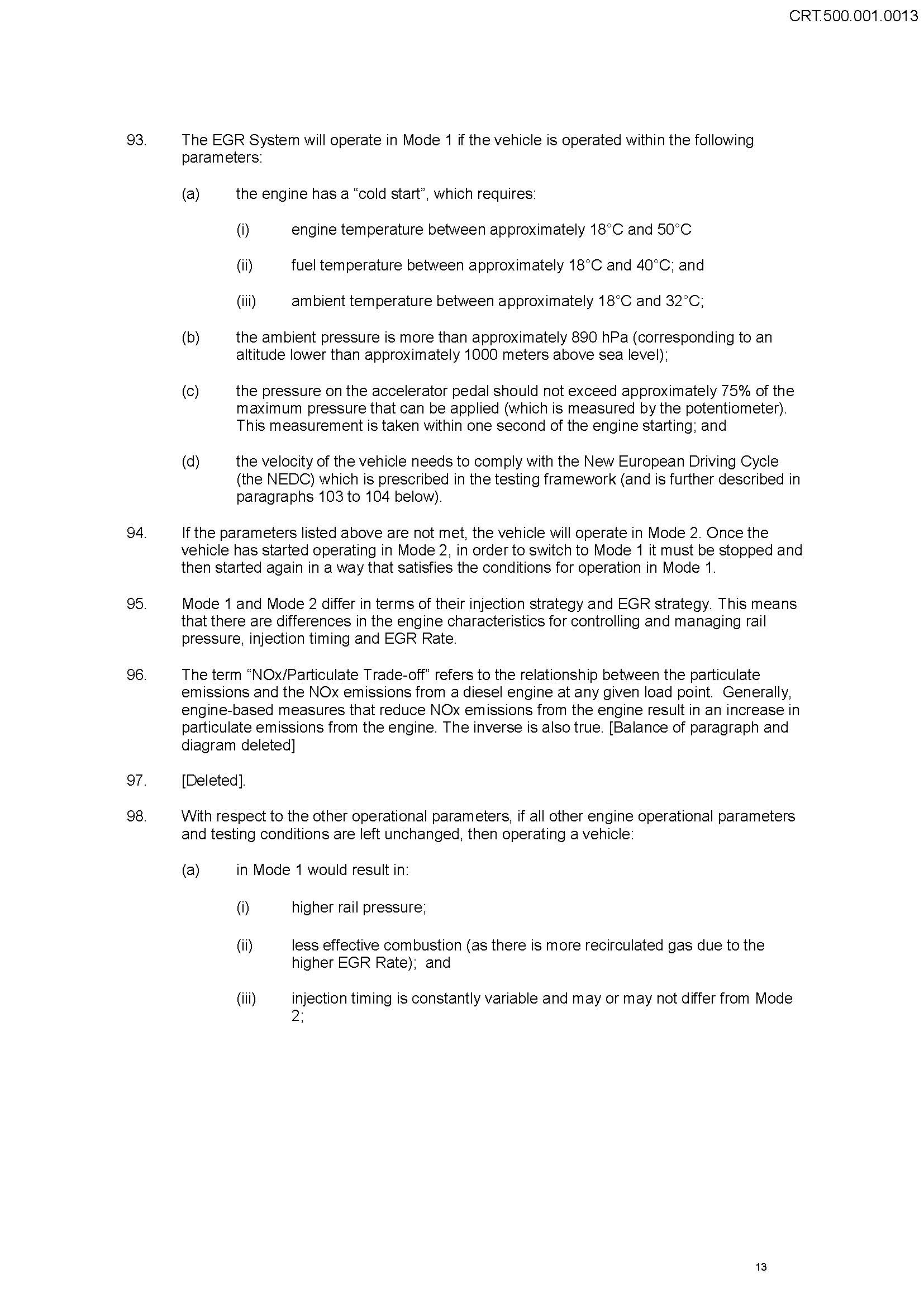
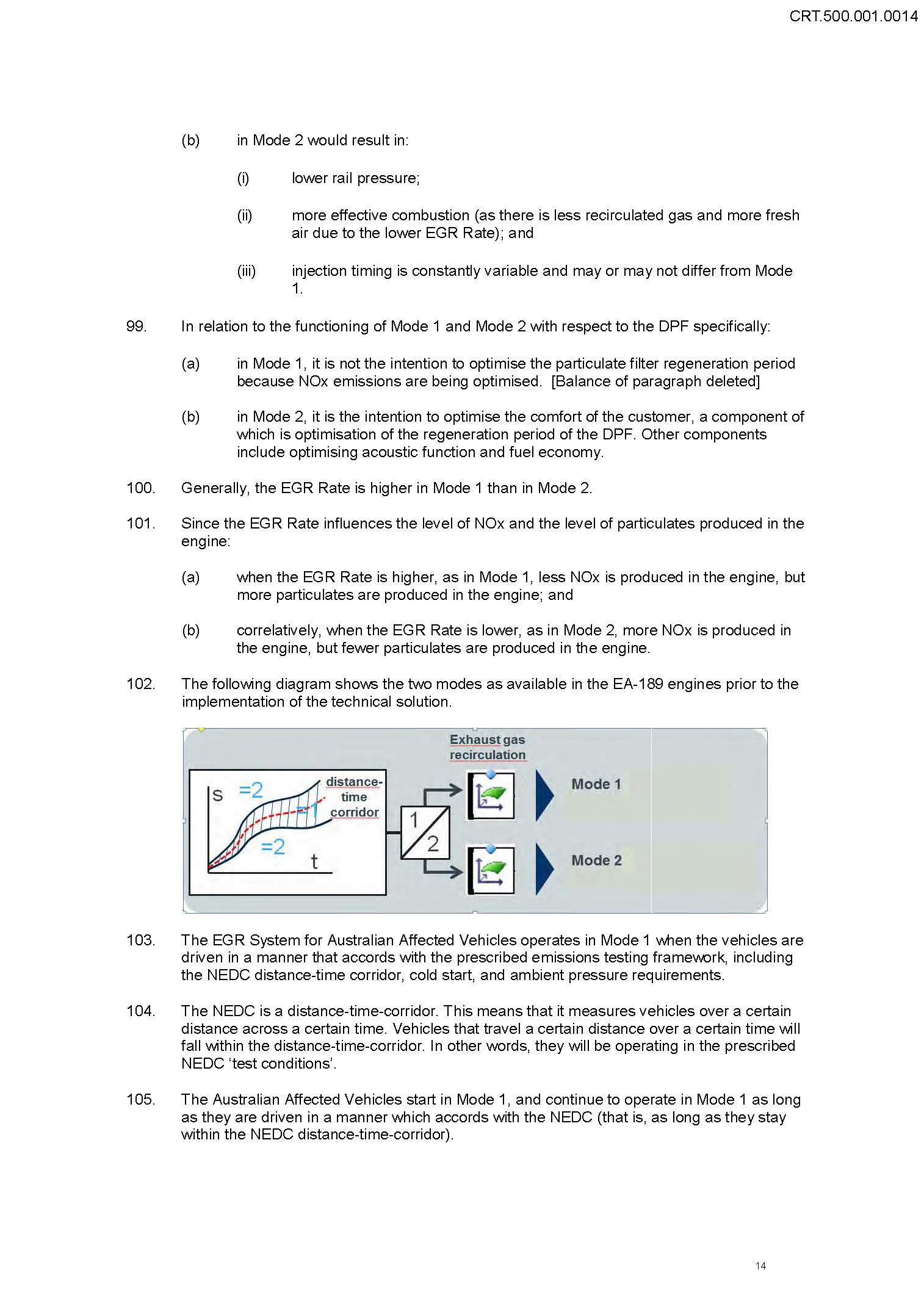
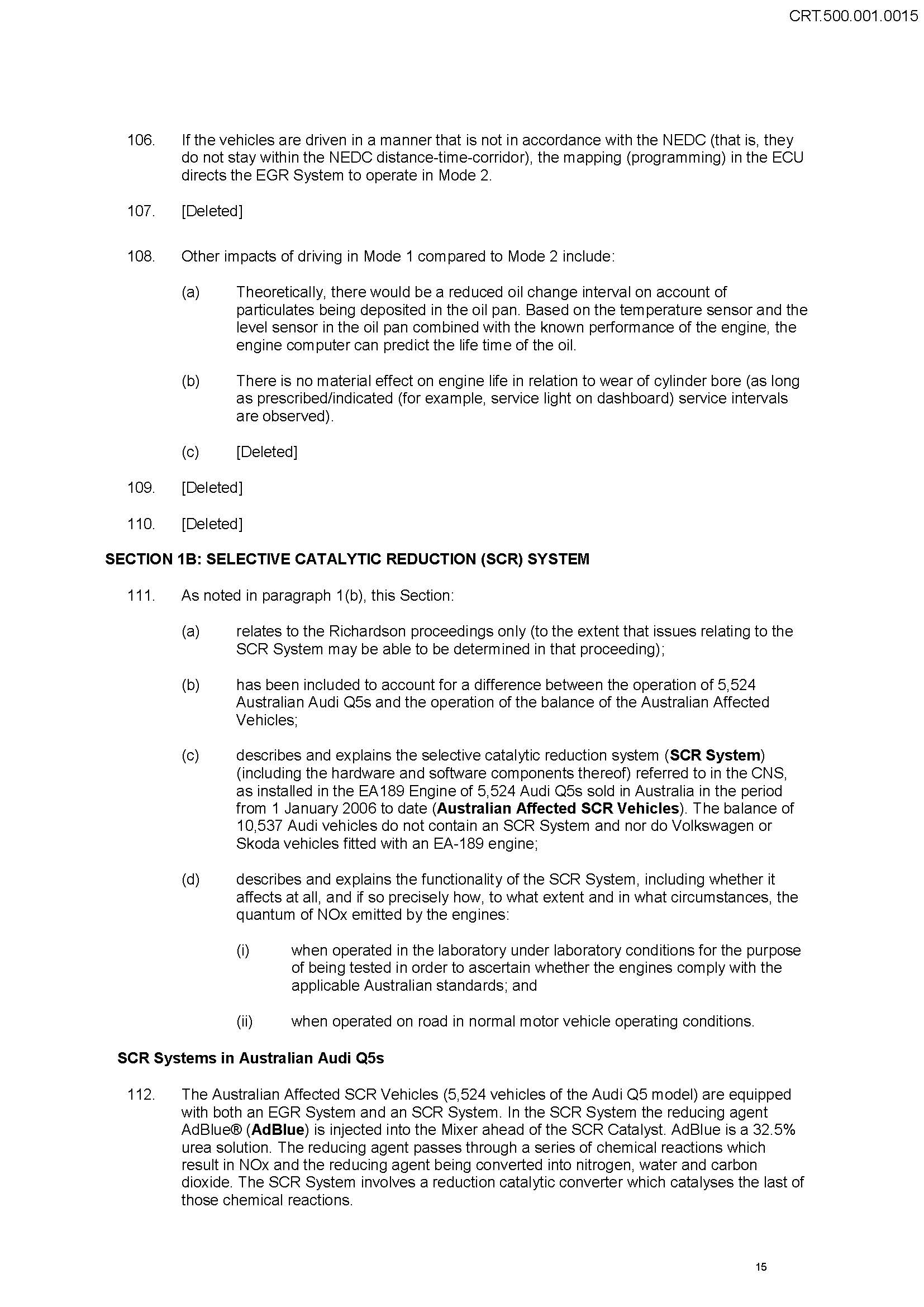
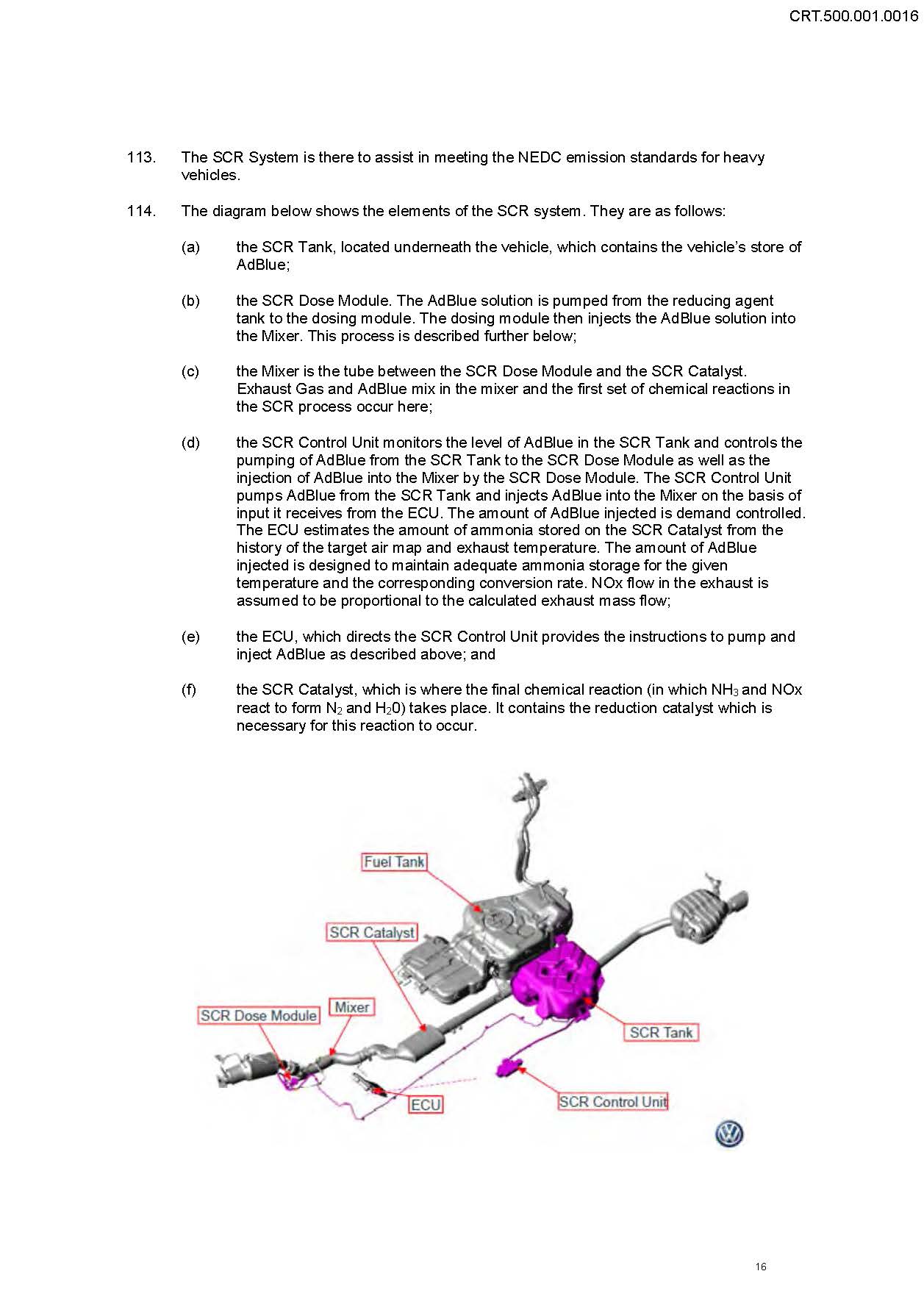
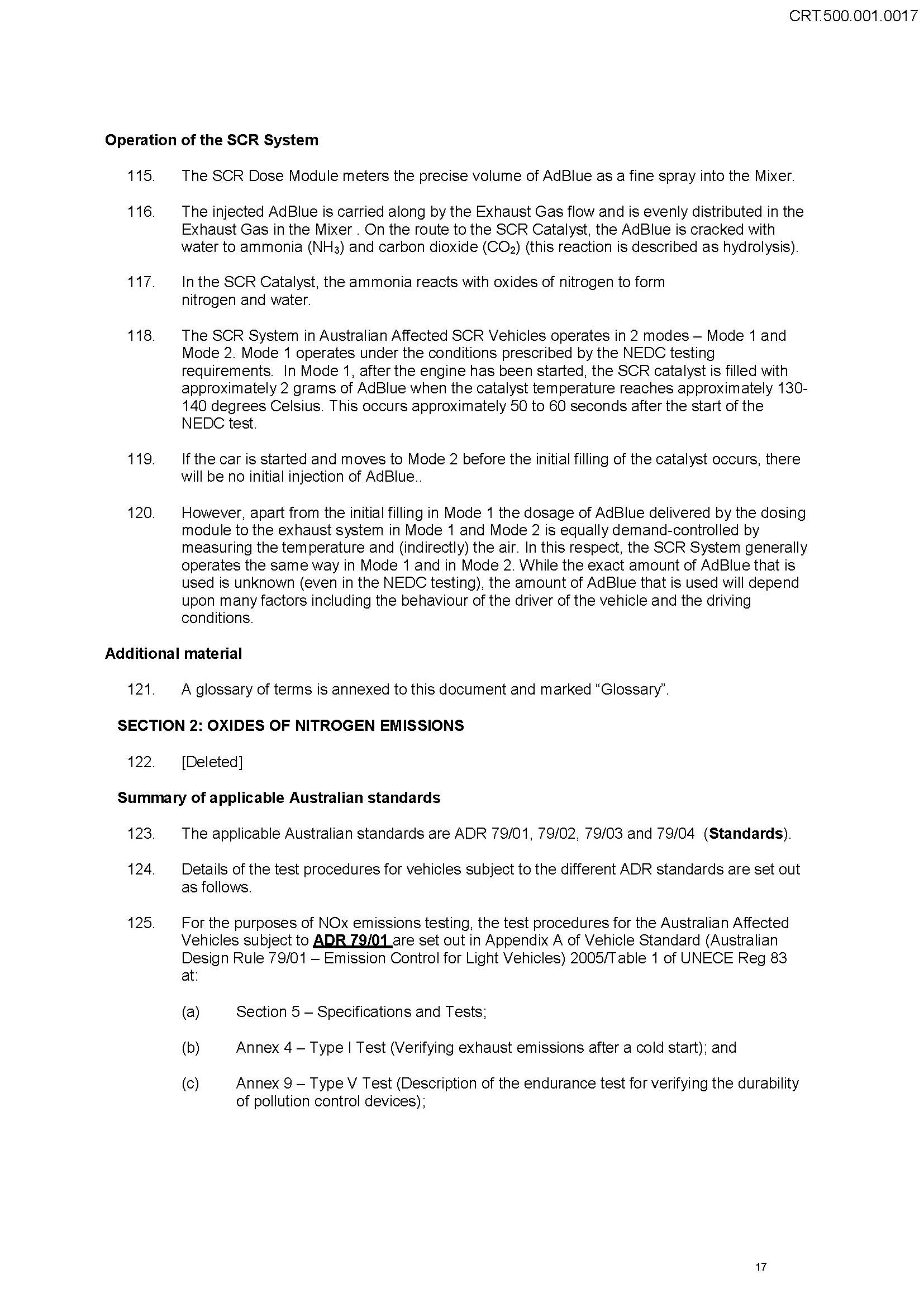
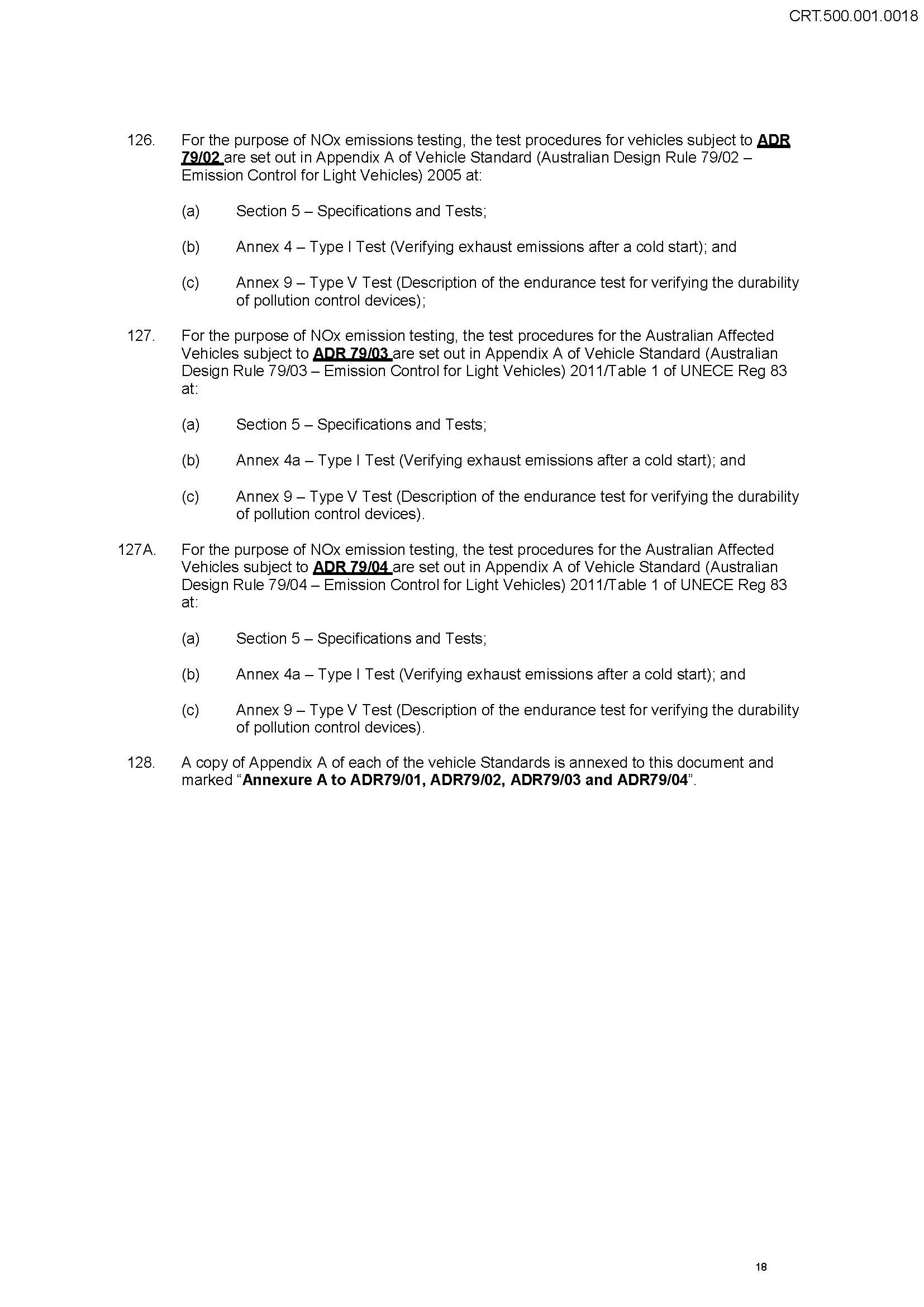
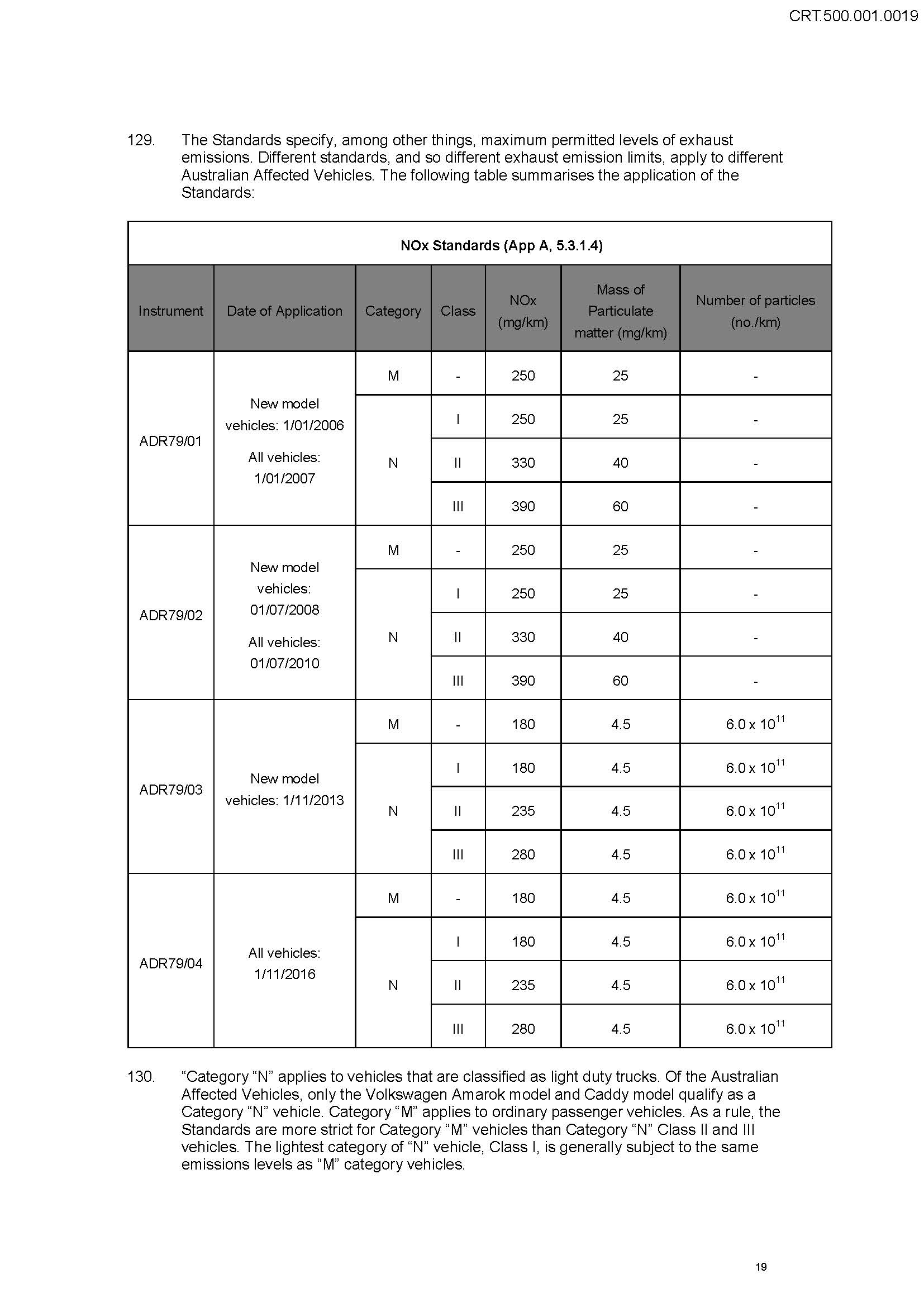
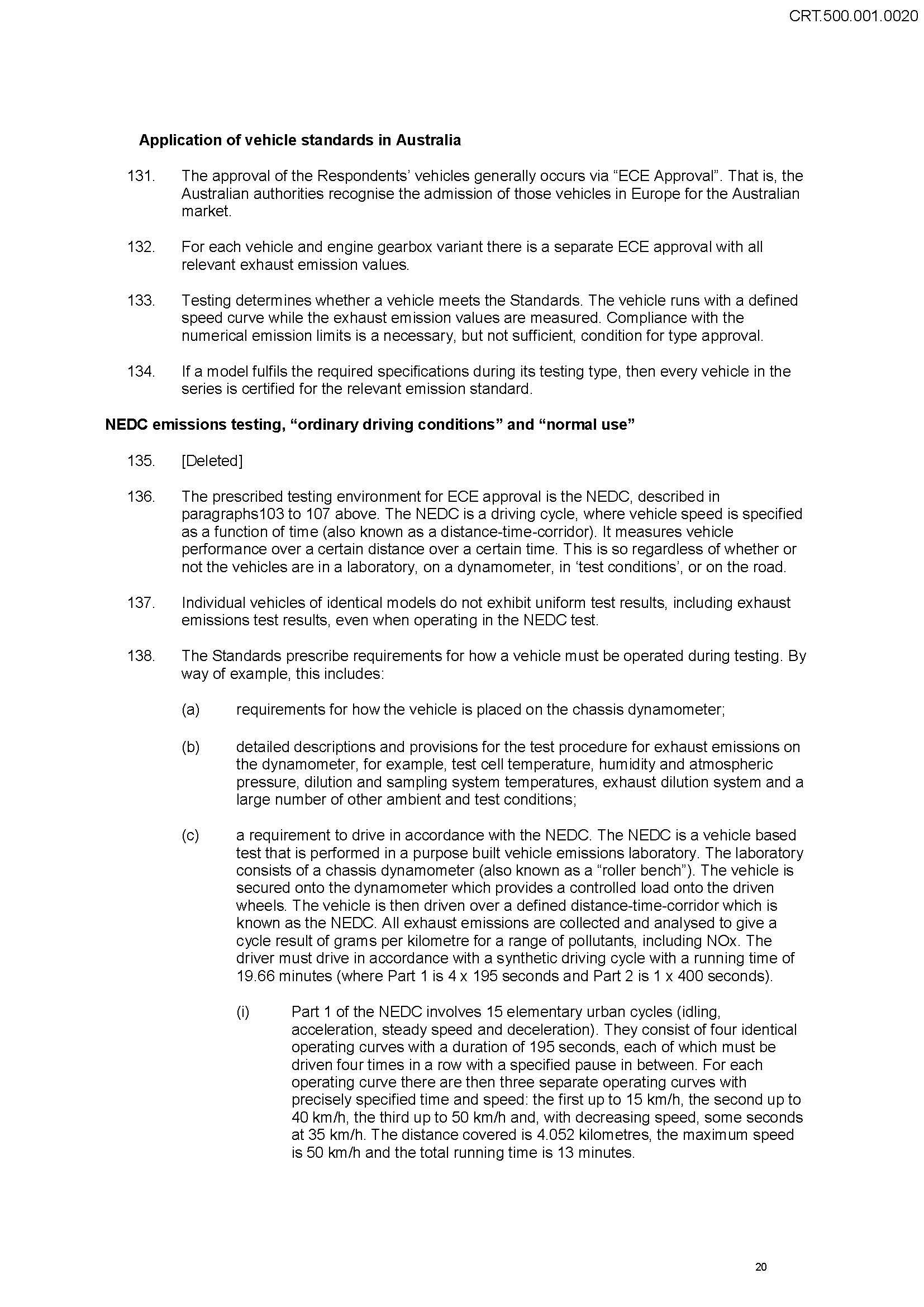
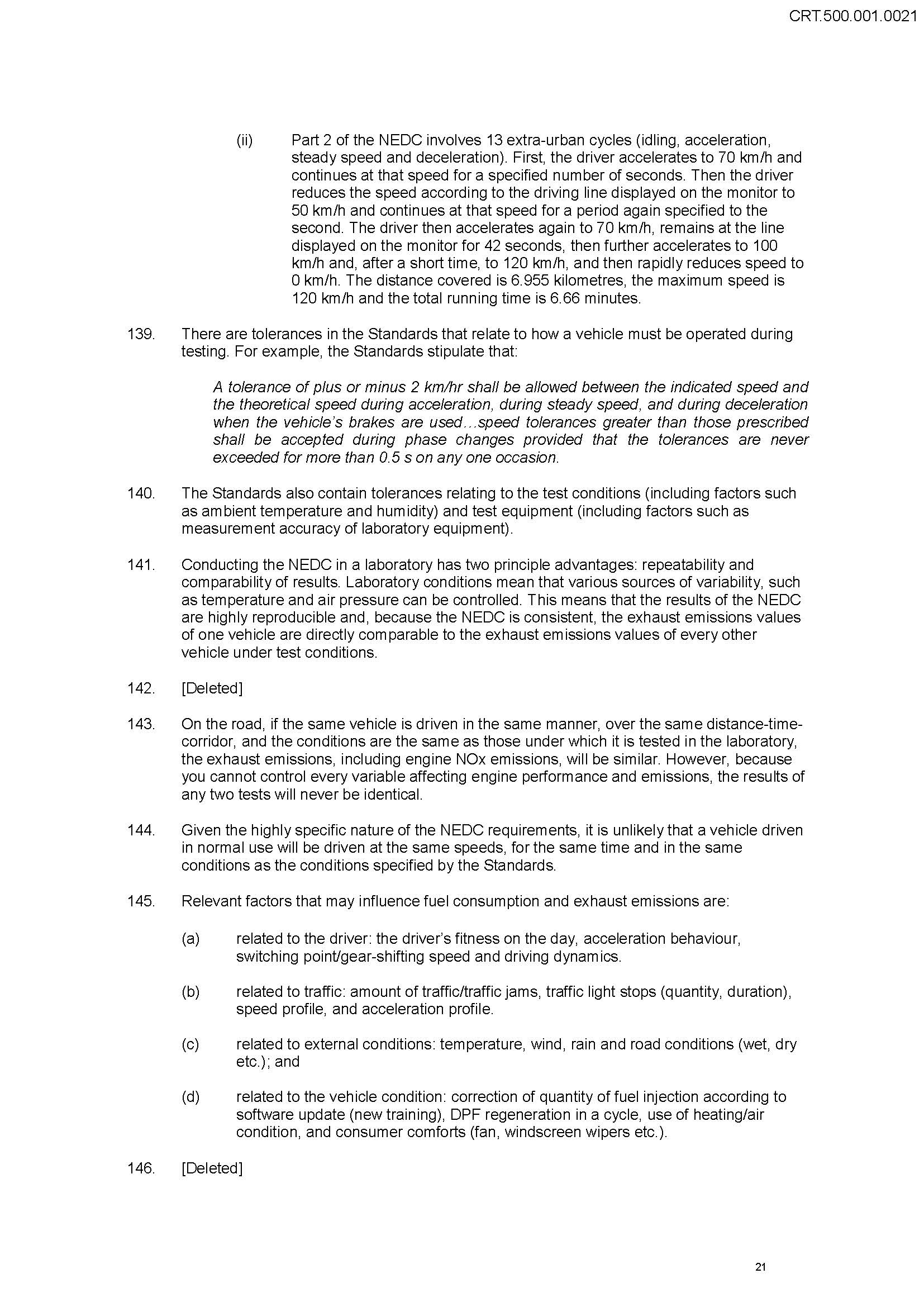
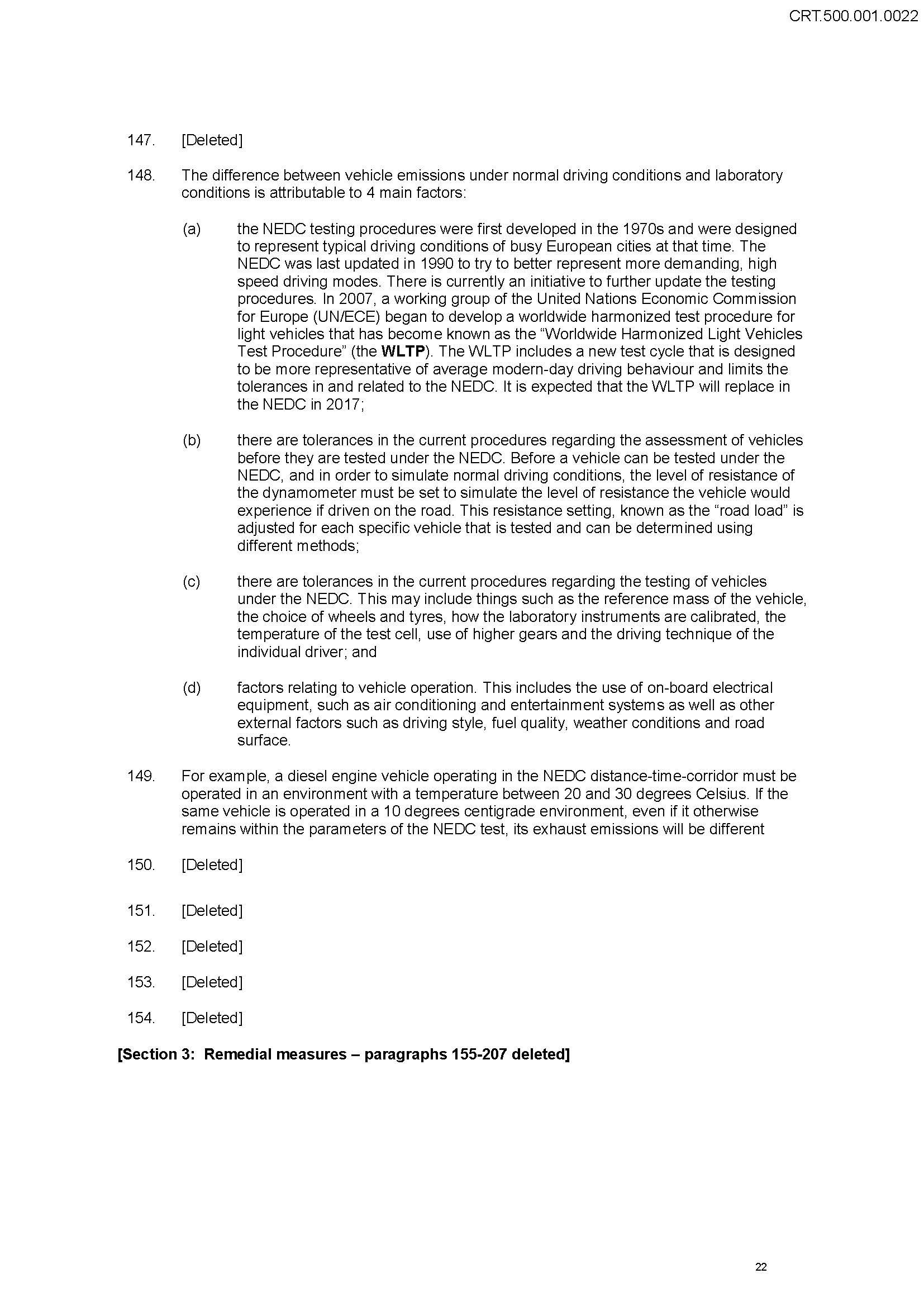
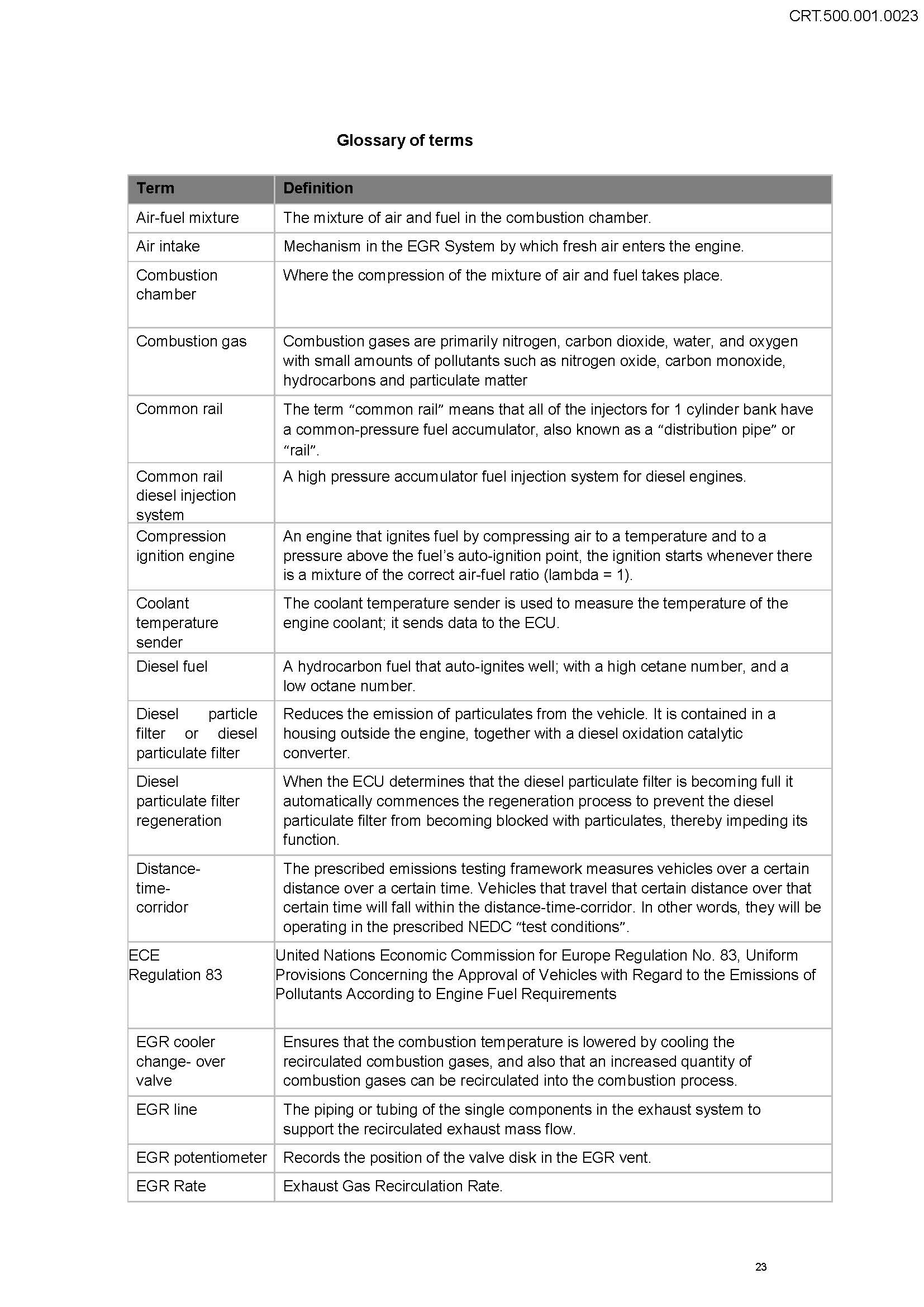
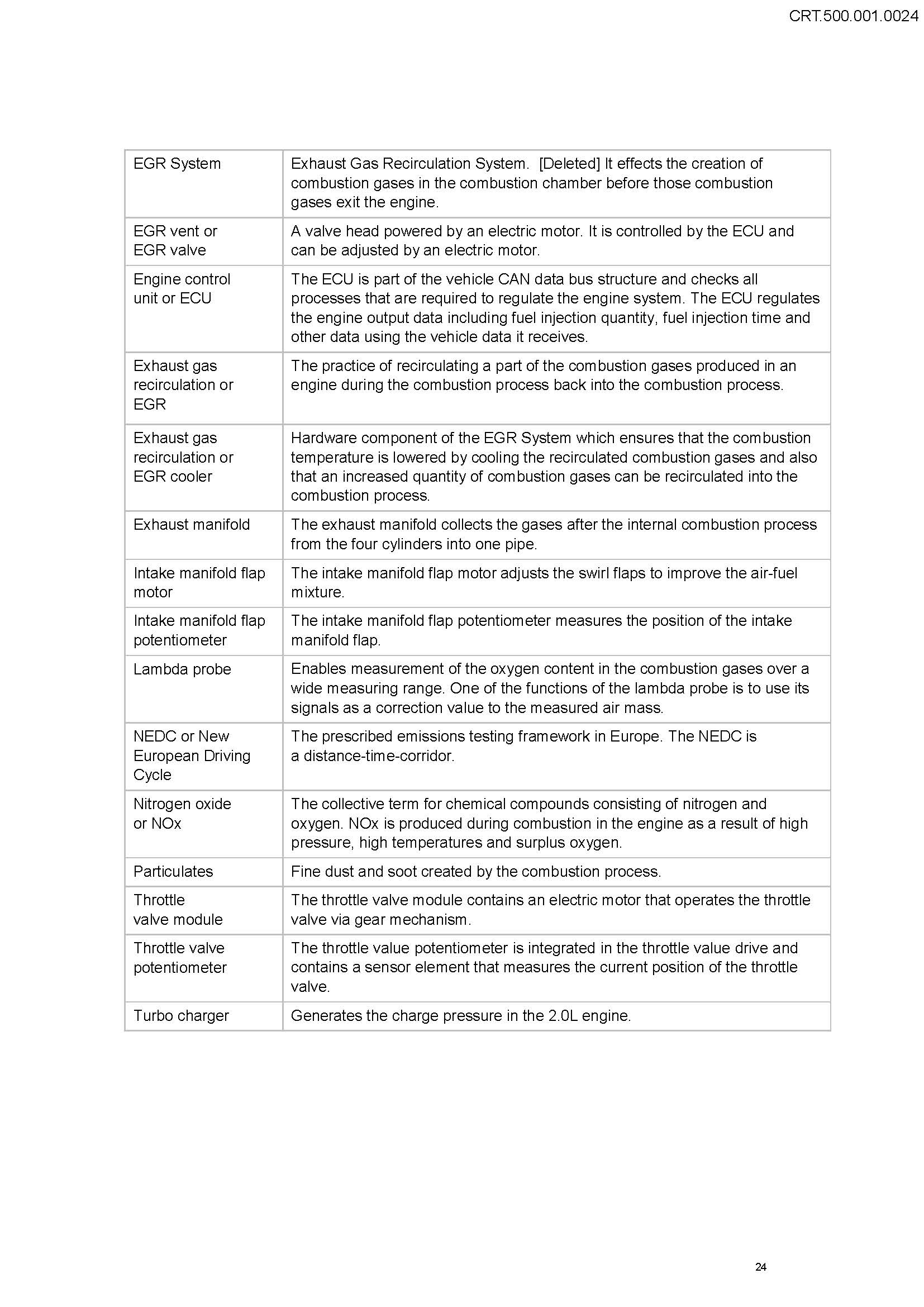
Attachment B
